Paul van Yperen's Blog, page 8
July 21, 2025
Betsy Drake
Betsy Drake (1923-2015) was a French-born American actress, writer, and psychotherapist. She played in films such as The Second Woman (1950), Will Success Spoil Rock Hunter? (1957) with Jayne Mansfield. She was also known for being the third wife of Cary Grant, with whom she co-starred in Every Girl Should Be Married (1948) and Room for One More (1952).
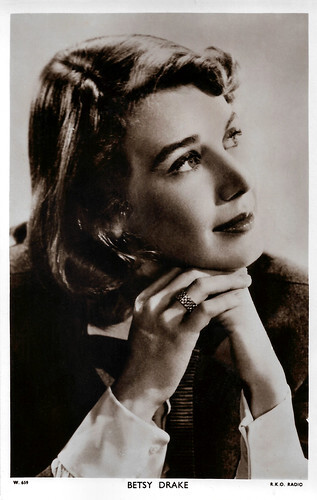
British postcard in the Picturegoer Series, London, no. W 659. Photo: R.K.O. Radio.
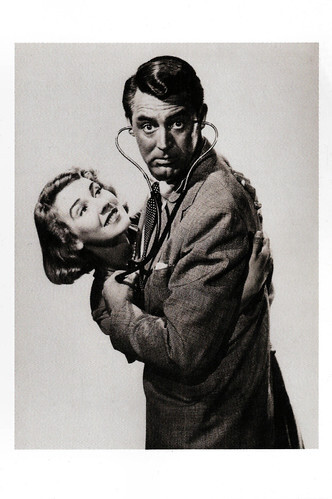
French postcard. Photo: Keystone - L'Illustration. Cary Grant and Betsy Drake in Every Girl Should Be Married (Don Hartman, 1948).
Every girl should be married
Betsy Drake was born in Paris in 1923. She was the eldest child of two American expatriates. Her grandfather, Tracy Drake, and his brother had opened the Drake Hotel in Chicago on New Year's Eve in 1920. The Drakes lost their money in the 1929 stock market crash. As a result, she returned to the U.S. on the SS Île de France with her parents, brothers, and a nanny. Betsy grew up in five different cities and went to 12 different schools, both private and public.
Then, she concentrated on theatre and acting at the National Park Seminary. Drake began looking for work as an actress in New York City, supporting herself by working as a Conover model. She met the playwright Horton Foote, who offered her a job as an understudy in his play 'Only the Heart', which enabled her to join the Actors' Equity Association and thus become a professional actress. After coming to the attention of producer Hal Wallis, Drake was pressured by her agent to sign a Hollywood contract.
She hated Hollywood and managed to be released from the contract by declaring herself insane. She returned to New York City and, in 1947, read for the director Elia Kazan for the lead role in the London company of the play 'Deep Are the Roots'. Later that year, Drake was selected by Kazan as one of the founding members of the Actors Studio. Cary Grant spotted her in 1947 while she was performing in London. The two, who both happened to be returning to the U.S. on the RMS Queen Mary, struck up an instant rapport. At the insistence of Grant, Drake was subsequently signed to a film contract by RKO Pictures and David Selznick, where she appeared, opposite Grant, in her first film, the romantic comedy Every Girl Should Be Married (Don Hartman, 1948). New York Times film critic Bosley Crowther called her performance “foxily amusing”.
On Christmas Day 1949, Drake and Grant married in a private ceremony organised by Grant's best man, Howard Hughes. They chose a low-key, introspective private life. They delved into transcendentalism, mysticism, and yoga. She took up causes including the plight of homeless children in Los Angeles. The couple co-starred in the radio series 'Mr. and Mrs. Blandings' (1951). They appeared together in the comedy drama Room for One More (Norman Taurog, 1952), and Drake appeared in more leading roles.
Betsy Drake was with her husband in Cannes in 1954 while Cary Grant made To Catch a Thief (Alfred Hitchcock, 1955). In 1954, they bought the 'Las Palomas' estate in the Movie Colony neighbourhood of Palm Springs, California. Betsy was also with him in Spain in 1956, when Grant filmed The Pride and the Passion (Stanley Kramer, 1957).
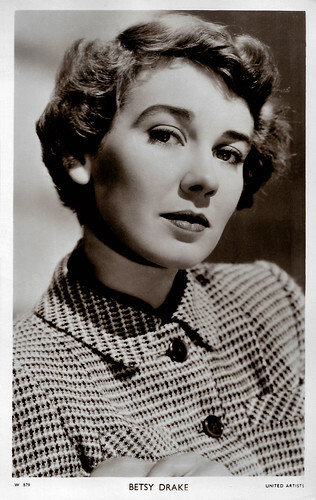
British postcard in the Picturegoer Series, London, no. W 879. Photo: United Artists.
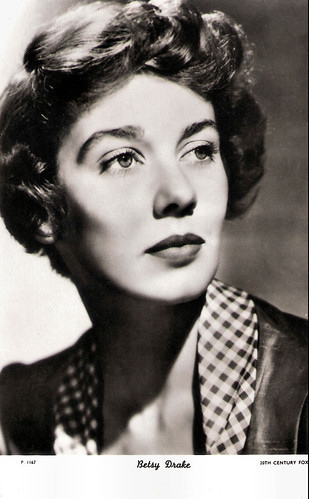
British postcard in the Film Star Series, no. P 1167, by Show Parade Picture Services, London. Photo: 20th Century Fox.
Taking LSD to recover from her divorce from Cary Grant
In Spain, Betsy Drake learned Cary Grant was reportedly in love with co-star Sophia Loren. Drake left before the press found out and sailed back to New York on the ill-fated Italian liner Andrea Doria in July 1956. She boarded it along with dozens of other wealthy travellers and tourists at Gibraltar, which was one of many stops the ship made between her home port of Genoa and her final destination of New York City. Drake sailed as a first-class passenger, occupying a single cabin on the ship's boat deck. When the SS Andrea Doria collided with the Stockholm, Drake waited with the other passengers for rescue, as the ship's severe list rendered half of its lifeboats useless. She was among more than 1600 people rescued from the ship by the famed French passenger liner SS Île de France. She lost more than $200,000 worth of jewellery as well as a book manuscript on which she had been working.
Betsy Drake had written the original script for the film Houseboat (Melville Shavelson, 1958) under a pseudonym, basing it on an unpublished story she had written. Starring Grant, Drake anticipated co-starring in the film. Grant, who indeed had begun an affair with Sophia Loren while filming The Pride and the Passion (Stanley Kramer, 1957), arranged for Loren to take Drake's place in Houseboat. For the rewritten script, Drake did not receive credit. The affair ended in bitterness before The Pride and the Passion's filming ended, causing problems on the Houseboat set.
Grant and Drake separated in 1958, remaining friends, and divorced in 1962. She was awarded more than $1 million in cash plus a percentage of the earnings from the 13 films Grant had made during their marriage. Their marriage constituted his longest union. Grant credited her with broadening his interests beyond his career and with introducing him to the then-legal LSD therapy and hypnosis. Later, Drake took LSD as a way of recovering from the trauma of divorce.
Betsy Drake had a supporting role in the satirical comedy Will Success Spoil Rock Hunter? (Frank Tashlin, 1957) with Tom Ewell and Jayne Mansfield , and a leading role in the British thriller Intent to Kill (Jack Cardiff, 1958) with Richard Todd . She subsequently gave up acting and pursued other career interests. She earned a Master of Education degree from Harvard University and became a children's therapist. Drake was a director of psychodrama at the UCLA Neuropsychiatric Institute, worked at Cedars-Sinai Hospital, and maintained a private therapy practice. She taught at UCLA, Pepperdine University and presented research at the 52nd Annual Meeting American Orthopsychiatric Association in 1975.
She made one more film, Clarence, the Cross-Eyed Lion (Andrew Marton, 1965). Under the name Betsy Drake Grant, her novel 'Children, You Are Very Little' (1971) was published by Atheneum Books. Drake did not have children with Grant and did not remarry. Her last screen appearance was in the documentary film Cary Grant: A Class Apart (2005), in which she reflected on Grant and their time together, and denied rumours alleging he was bisexual. Betsy Drake spent the latter part of her life in London, where she died, aged 92, in 2015. Upon her death, she was cremated and her ashes scattered at sea.
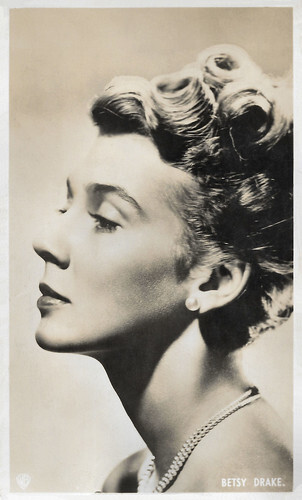
British collector card, no. A 53. Photo: Warner Bros.

Belgian postcard, no. 351. Photo: Warner Bros.
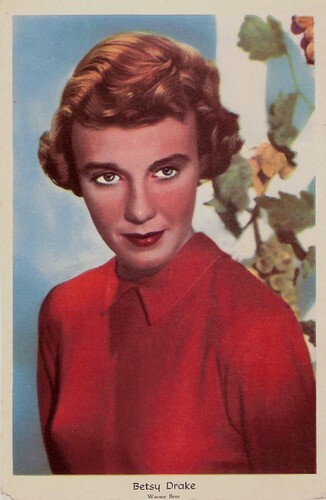
Vintage postcard. Photo: Warner Bros.
Sources: Wikipedia and .

British postcard in the Picturegoer Series, London, no. W 659. Photo: R.K.O. Radio.

French postcard. Photo: Keystone - L'Illustration. Cary Grant and Betsy Drake in Every Girl Should Be Married (Don Hartman, 1948).
Every girl should be married
Betsy Drake was born in Paris in 1923. She was the eldest child of two American expatriates. Her grandfather, Tracy Drake, and his brother had opened the Drake Hotel in Chicago on New Year's Eve in 1920. The Drakes lost their money in the 1929 stock market crash. As a result, she returned to the U.S. on the SS Île de France with her parents, brothers, and a nanny. Betsy grew up in five different cities and went to 12 different schools, both private and public.
Then, she concentrated on theatre and acting at the National Park Seminary. Drake began looking for work as an actress in New York City, supporting herself by working as a Conover model. She met the playwright Horton Foote, who offered her a job as an understudy in his play 'Only the Heart', which enabled her to join the Actors' Equity Association and thus become a professional actress. After coming to the attention of producer Hal Wallis, Drake was pressured by her agent to sign a Hollywood contract.
She hated Hollywood and managed to be released from the contract by declaring herself insane. She returned to New York City and, in 1947, read for the director Elia Kazan for the lead role in the London company of the play 'Deep Are the Roots'. Later that year, Drake was selected by Kazan as one of the founding members of the Actors Studio. Cary Grant spotted her in 1947 while she was performing in London. The two, who both happened to be returning to the U.S. on the RMS Queen Mary, struck up an instant rapport. At the insistence of Grant, Drake was subsequently signed to a film contract by RKO Pictures and David Selznick, where she appeared, opposite Grant, in her first film, the romantic comedy Every Girl Should Be Married (Don Hartman, 1948). New York Times film critic Bosley Crowther called her performance “foxily amusing”.
On Christmas Day 1949, Drake and Grant married in a private ceremony organised by Grant's best man, Howard Hughes. They chose a low-key, introspective private life. They delved into transcendentalism, mysticism, and yoga. She took up causes including the plight of homeless children in Los Angeles. The couple co-starred in the radio series 'Mr. and Mrs. Blandings' (1951). They appeared together in the comedy drama Room for One More (Norman Taurog, 1952), and Drake appeared in more leading roles.
Betsy Drake was with her husband in Cannes in 1954 while Cary Grant made To Catch a Thief (Alfred Hitchcock, 1955). In 1954, they bought the 'Las Palomas' estate in the Movie Colony neighbourhood of Palm Springs, California. Betsy was also with him in Spain in 1956, when Grant filmed The Pride and the Passion (Stanley Kramer, 1957).

British postcard in the Picturegoer Series, London, no. W 879. Photo: United Artists.

British postcard in the Film Star Series, no. P 1167, by Show Parade Picture Services, London. Photo: 20th Century Fox.
Taking LSD to recover from her divorce from Cary Grant
In Spain, Betsy Drake learned Cary Grant was reportedly in love with co-star Sophia Loren. Drake left before the press found out and sailed back to New York on the ill-fated Italian liner Andrea Doria in July 1956. She boarded it along with dozens of other wealthy travellers and tourists at Gibraltar, which was one of many stops the ship made between her home port of Genoa and her final destination of New York City. Drake sailed as a first-class passenger, occupying a single cabin on the ship's boat deck. When the SS Andrea Doria collided with the Stockholm, Drake waited with the other passengers for rescue, as the ship's severe list rendered half of its lifeboats useless. She was among more than 1600 people rescued from the ship by the famed French passenger liner SS Île de France. She lost more than $200,000 worth of jewellery as well as a book manuscript on which she had been working.
Betsy Drake had written the original script for the film Houseboat (Melville Shavelson, 1958) under a pseudonym, basing it on an unpublished story she had written. Starring Grant, Drake anticipated co-starring in the film. Grant, who indeed had begun an affair with Sophia Loren while filming The Pride and the Passion (Stanley Kramer, 1957), arranged for Loren to take Drake's place in Houseboat. For the rewritten script, Drake did not receive credit. The affair ended in bitterness before The Pride and the Passion's filming ended, causing problems on the Houseboat set.
Grant and Drake separated in 1958, remaining friends, and divorced in 1962. She was awarded more than $1 million in cash plus a percentage of the earnings from the 13 films Grant had made during their marriage. Their marriage constituted his longest union. Grant credited her with broadening his interests beyond his career and with introducing him to the then-legal LSD therapy and hypnosis. Later, Drake took LSD as a way of recovering from the trauma of divorce.
Betsy Drake had a supporting role in the satirical comedy Will Success Spoil Rock Hunter? (Frank Tashlin, 1957) with Tom Ewell and Jayne Mansfield , and a leading role in the British thriller Intent to Kill (Jack Cardiff, 1958) with Richard Todd . She subsequently gave up acting and pursued other career interests. She earned a Master of Education degree from Harvard University and became a children's therapist. Drake was a director of psychodrama at the UCLA Neuropsychiatric Institute, worked at Cedars-Sinai Hospital, and maintained a private therapy practice. She taught at UCLA, Pepperdine University and presented research at the 52nd Annual Meeting American Orthopsychiatric Association in 1975.
She made one more film, Clarence, the Cross-Eyed Lion (Andrew Marton, 1965). Under the name Betsy Drake Grant, her novel 'Children, You Are Very Little' (1971) was published by Atheneum Books. Drake did not have children with Grant and did not remarry. Her last screen appearance was in the documentary film Cary Grant: A Class Apart (2005), in which she reflected on Grant and their time together, and denied rumours alleging he was bisexual. Betsy Drake spent the latter part of her life in London, where she died, aged 92, in 2015. Upon her death, she was cremated and her ashes scattered at sea.

British collector card, no. A 53. Photo: Warner Bros.

Belgian postcard, no. 351. Photo: Warner Bros.

Vintage postcard. Photo: Warner Bros.
Sources: Wikipedia and .
Published on July 21, 2025 22:00
July 20, 2025
Kenneth More
Kenneth More (1914-1982) was one of the most successful and highest-paid British actors of his generation. He won a BAFTA Award in 1955 for his role in Doctor in the House. More was also nominated for a BAFTA for Genevieve (1954), The Deep Blue Sea (1956) and Reach for the Sky (1957). For The Deep Blue Sea, he received the Volpi Cup at the 1955 Venice Film Festival.
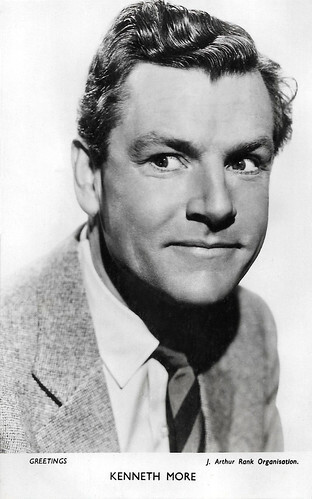
British postcard in the Greetings series. Photo: J. Arthur Rank Organisation.
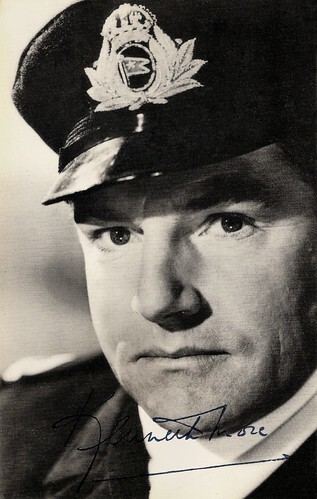
British postcard by Celebrity Publishers LTD, London, in the Celebrity Autograph Series, no. 334. Photo: Rank. Kenneth More in A Night to Remember (Roy Ward Baker, 1958).
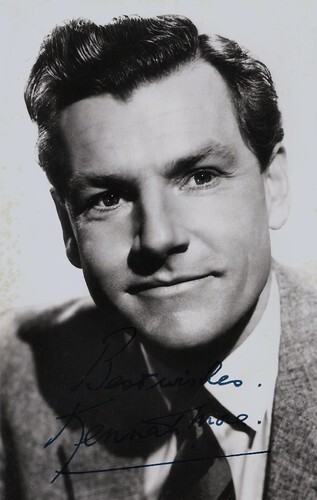
British autograph card. Photo: Rank.
Nearly starving
Kenneth Gilbert More was born in 1914 in Gerrards Cross, Buckinghamshire. He was the only son of Charles Gilbert More, a Royal Naval Air Service pilot, and Edith Winifred Watkins, the daughter of a Cardiff solicitor. He was educated at Victoria College, Jersey, having spent part of his childhood in the Channel Islands, where his father was general manager of the Jersey Eastern Railway.
When More was 17, his father died, and he applied to join the Royal Air Force but failed the medical test for equilibrium. He then travelled to Canada, intending to work as a fur trapper, but was sent back to Britain because he lacked immigration documents. On his return from Canada, a business associate of his father, Vivian Van Damm, agreed to offer him work as a stagehand at the Windmill Theatre, where his job included shifting scenery and helping to get the nude players off stage during its Revudeville variety shows.
After a chance moment on stage assisting a comic, he realised he wanted to act and was soon promoted to playing the straight man in the Revudeville comedy routines. He appeared in his first sketch in August 1935. He played there for a year, which led to regular work in repertory, performing in plays such as 'Burke and Hare' and 'Dracula's Daughter'. He continued his theatre work until the outbreak of the Second World War in 1939.
During the war, More received a commission as a lieutenant in the Royal Navy and saw active service aboard the cruiser HMS Aurora and the aircraft carrier HMS Victorious. More made his official film debut in Look Up and Laugh (Basil Dean, 1935) starring Gracie Fields . Nevertheless, in the first three film titles on his CV, he was 'only' an extra. His 'real' debut followed in 1946, with an unnamed role in the drama School for Secrets (Peter Ustinov, 1946) starring Ralph Richardson .
He began to appear regularly on the big screen. For a small role in Scott of the Antarctic (Charles Frend, 1948) as Edward Evans, 1st Baron Mountevans, he was paid £500. He thought this film would launch him more than it did and held off from accepting other roles, which resulted in him "nearly starving". He took minor parts in the Film Noir Man on the Run (Lawrence Huntington, 1949), the drama Now Barabbas (Gordon Parry, 1949), and Stop Press Girl (Michael Barry, 1949) starring Sally Ann Howes .
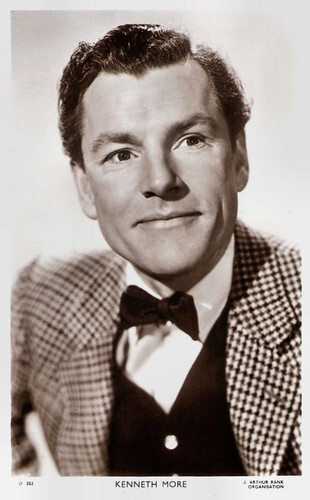
British postcard in the Picturegoer Series, London, no. D 352. Photo: J. Arthur Rank Organisation.
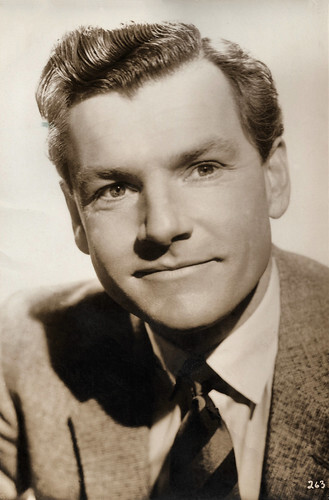
Spanish postcard by Kores Carboplan. Photo: J. Arthur Rank.
Tremendous critical acclaim
Kenneth More achieved notable stage success in 'The Way Things Go' (1950) with Ronald Squire, from whom More later claimed he learned his stage technique. He was in demand for minor roles on screen, such as Morning Departure (Roy Ward Baker, 1950) with John Mills , and Chance of a Lifetime (Bernard Miles, 1950). More had a good part as a British agent in the mystery The Clouded Yellow (Ralph Thomas, 1950), starring Jean Simmons .
He could also be seen in the thriller The Franchise Affair (Lawrence Huntington, 1951) and the sports comedy The Galloping Major (Henry Cornelius, 1951). More's first Hollywood-financed film was No Highway in the Sky (Henry Koster, 1951), where he played a co-pilot. Ralph Thomas cast him in another strong supporting part in Appointment with Venus (Ralph Thomas, 1952). More's name was placed above the title billing for the first time with a low-budget comedy, Brandy for the Parson (John Eldridge, 1952), playing a smuggler.
Roland Culver recommended More to audition for a part in a new play by Terence Rattigan, 'The Deep Blue Sea' (1952). He was successful and achieved tremendous critical acclaim in the role of Freddie. During the play's run, he appeared as a worried parent in a thriller, The Yellow Balloon (J. Lee Thompson, 1953). He was in another Hollywood-financed film, Never Let Me Go (Delmer Daves, 1953), playing a colleague of Clark Gable .
Kenneth More finally achieved film fame in the comedy Genevieve (Henry Cornelius, 1953). It stars John Gregson , Dinah Sheridan, Kenneth More and Kay Kendall as two couples comedically involved in a veteran automobile rally. In the New York Times , critic Bosley Crowther wrote, "British producer-director, Henry Cornelius, has made a film that may cautiously be recommended as one of the funniest farce comedies in years." Genevieve was the second-most popular film at the British box office in 1953 and turned More into a star. The following year, Doctor in the House (Ralph Thomas, 1954) with Dirk Bogarde and More was even the biggest hit of the year at the British box office and the most successful film in the history of Rank. More received a BAFTA Award as Best Newcomer.
He appeared in a TV production of The Deep Blue Sea (1954), which was seen by an audience of 11 million. He signed a five-year contract with Sir Alexander Korda at £10,000 a year and played the role again in a film version, The Deep Blue Sea (Anatole Litvak, 1955) with Vivien Leigh . He gained the Best Actor at the Venice Film Festival for his performance, but the film was a critical and commercial disappointment. More appeared as a carefree, happy-go-lucky gent in such comedies as Raising a Riot (Wendy Toye, 1955), The Admirable Crichton (Lewis Gilbert, 1957), The Sheriff of Fractured Jaw (Raoul Walsh, 1958) with Jayne Mansfield and Next to No Time (Henry Cornelius, 1958) with Betsy Drake. He also played more serious roles as a leading man in Reach for the Sky (Lewis Gilbert, 1956), A Night to Remember (Roy Ward Baker, 1958), North West Frontier (J. Lee Thompson, 1959) with Lauren Bacall , The 39 Steps (Ralph Thomas, 1959) and Sink the Bismarck! (Lewis Gilbert, 1960) with Dana Wynter.
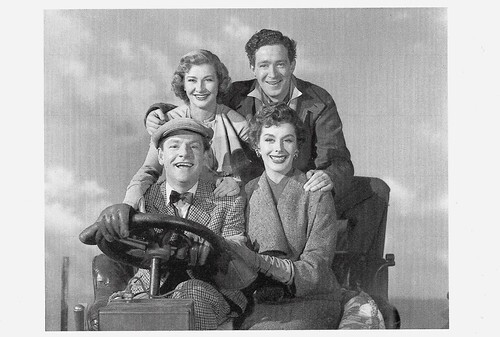
British postcard for the British Film Year exhibition by Raithby, Lawrence & Company Ltd, Leicester and London. Photo: Harry Gillard / Pinewood Studios. Kenneth More, John Gregson , Dinah Sheridan, John Gregson , Dinah Sheridan, and Kay Kendall in Geneviève (Henry Cornelius, 1953).
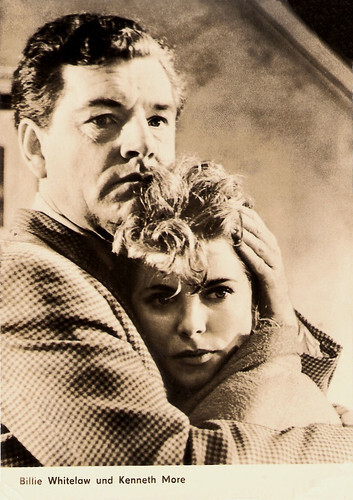
East-German postcard by VEB Progress Filmvertrieb, Berlin, no. 2420, 1965. Photo: Kenneth More and Billie Whitelaw in The Comedy Man (Alvin Rakoff, 1964).
His first real flop since becoming a star
Kenneth More made a comedy, Man In The Moon (Basil Dearden, 1960) with Shirley Anne Field , which flopped at the box office. It was his first real flop since becoming a star. He returned to the stage directing 'The Angry Deep' in Brighton in 1960. Although his career declined in the early 1960s, two of his own favourite films date from this time. The first was the drama The Greengage Summer (Lewis Gilbert, 1961) with Susannah York in her first leading role. More later wrote that Lewis Gilbert insisted he go on a diet before making the film so that he might be more believable as a romantic lead. More did so as he very badly wanted to star in the film.
The second film was The Comedy Man (Alvin Rakoff, 1964), but the film was not released for two years. In between, he returned to military roles as one of many stars in The Longest Day (Ken Annakin a.o., 1962) playing Beachmaster Captain Colin Maud. He accepted the lead in the low-budget youth film, Some People (Clive Donner, 1962), because he had no other offers at the time. The film was profitable.
Kenneth More enjoyed a revival on television in the much-acclaimed series The Forsyte Saga (David Giles, James Cellan Jones, 1967), an adaptation of John Galsworthy's series of 'The Forsyte Saga' novels. The series follows the fortunes of the upper-middle-class Forsyte family, and stars Eric Porter as Soames, Kenneth More as Young Jolyon and Nyree Dawn Porter as Irene. It was shown in the United States on public television and broadcast all over the world, and became the first BBC television series to be sold to the Soviet Union.
Another hit was the Father Brown series (1974) based on the stories by G. K. Chesterton. The series featured More as Father Brown, a Roman Catholic priest who solved crime mysteries. In the cinema, he appeared opposite Suzy Kendall in Fräulein Doktor (Alberto Lattuada, 1969). He was one of many names in Oh! What a Lovely War (Richard Attenborough, 1969) and Battle of Britain (Guy Hamilton, 1969). He took the role of the Ghost of Christmas Present in Scrooge (Ronald Neame, 1970) starring Albert Finney as Ebenezer Scrooge. His later film roles included The Slipper and the Rose (Bryan Forbes, 1976), Leopard in the Snow (Gerry O'Hara, 1978), and Unidentified Flying Oddball (Russ Mayberry, 1979).
Kenneth More was married to his first wife, Beryl Johnstone, from 1939 to 1946. With her, he had a daughter, Susan Jane More (1941). His second marriage (1952-1967) was to Mabel Edith 'Bill' Barkby. They also had a daughter, Sarah Elizabeth More (1954). He then married his third and final wife, the then-26-year-old actress Angela Douglas, in 1968. More and Douglas separated for several years during the 1970s but reunited when he was diagnosed with Parkinson's disease. This made it increasingly difficult for him to work, although his last role was a sizeable supporting part in an American TV adaptation of A Tale of Two Cities (Jim Goddard, 1980) with Chris Sarandon. More and Douglas remained together until his death. In 1982, Kenneth More died in London from the effects of Parkinson's disease. He was 67. His oeuvre included more than 50 (television) films.
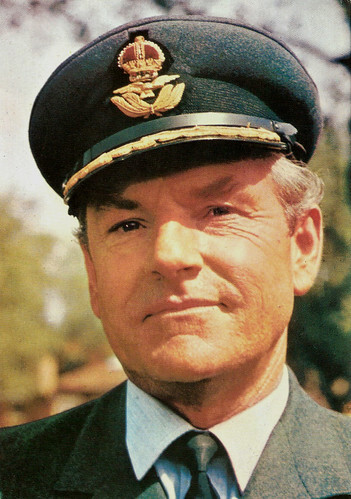
British postcard by Dixon-Lotus Production, no. L6/8701, 1969. Photo: Robert Penn / Spitfire Productions Ltd. Publicity still for Battle of Britain (Guy Hamilton, 1969). Caption: Kenneth More, one of Britain's truly international stars, portrays Station Commander Baker in the film Battle of Britain.
Sources: Wikipedia (Dutch and English) and .

British postcard in the Greetings series. Photo: J. Arthur Rank Organisation.

British postcard by Celebrity Publishers LTD, London, in the Celebrity Autograph Series, no. 334. Photo: Rank. Kenneth More in A Night to Remember (Roy Ward Baker, 1958).

British autograph card. Photo: Rank.
Nearly starving
Kenneth Gilbert More was born in 1914 in Gerrards Cross, Buckinghamshire. He was the only son of Charles Gilbert More, a Royal Naval Air Service pilot, and Edith Winifred Watkins, the daughter of a Cardiff solicitor. He was educated at Victoria College, Jersey, having spent part of his childhood in the Channel Islands, where his father was general manager of the Jersey Eastern Railway.
When More was 17, his father died, and he applied to join the Royal Air Force but failed the medical test for equilibrium. He then travelled to Canada, intending to work as a fur trapper, but was sent back to Britain because he lacked immigration documents. On his return from Canada, a business associate of his father, Vivian Van Damm, agreed to offer him work as a stagehand at the Windmill Theatre, where his job included shifting scenery and helping to get the nude players off stage during its Revudeville variety shows.
After a chance moment on stage assisting a comic, he realised he wanted to act and was soon promoted to playing the straight man in the Revudeville comedy routines. He appeared in his first sketch in August 1935. He played there for a year, which led to regular work in repertory, performing in plays such as 'Burke and Hare' and 'Dracula's Daughter'. He continued his theatre work until the outbreak of the Second World War in 1939.
During the war, More received a commission as a lieutenant in the Royal Navy and saw active service aboard the cruiser HMS Aurora and the aircraft carrier HMS Victorious. More made his official film debut in Look Up and Laugh (Basil Dean, 1935) starring Gracie Fields . Nevertheless, in the first three film titles on his CV, he was 'only' an extra. His 'real' debut followed in 1946, with an unnamed role in the drama School for Secrets (Peter Ustinov, 1946) starring Ralph Richardson .
He began to appear regularly on the big screen. For a small role in Scott of the Antarctic (Charles Frend, 1948) as Edward Evans, 1st Baron Mountevans, he was paid £500. He thought this film would launch him more than it did and held off from accepting other roles, which resulted in him "nearly starving". He took minor parts in the Film Noir Man on the Run (Lawrence Huntington, 1949), the drama Now Barabbas (Gordon Parry, 1949), and Stop Press Girl (Michael Barry, 1949) starring Sally Ann Howes .

British postcard in the Picturegoer Series, London, no. D 352. Photo: J. Arthur Rank Organisation.

Spanish postcard by Kores Carboplan. Photo: J. Arthur Rank.
Tremendous critical acclaim
Kenneth More achieved notable stage success in 'The Way Things Go' (1950) with Ronald Squire, from whom More later claimed he learned his stage technique. He was in demand for minor roles on screen, such as Morning Departure (Roy Ward Baker, 1950) with John Mills , and Chance of a Lifetime (Bernard Miles, 1950). More had a good part as a British agent in the mystery The Clouded Yellow (Ralph Thomas, 1950), starring Jean Simmons .
He could also be seen in the thriller The Franchise Affair (Lawrence Huntington, 1951) and the sports comedy The Galloping Major (Henry Cornelius, 1951). More's first Hollywood-financed film was No Highway in the Sky (Henry Koster, 1951), where he played a co-pilot. Ralph Thomas cast him in another strong supporting part in Appointment with Venus (Ralph Thomas, 1952). More's name was placed above the title billing for the first time with a low-budget comedy, Brandy for the Parson (John Eldridge, 1952), playing a smuggler.
Roland Culver recommended More to audition for a part in a new play by Terence Rattigan, 'The Deep Blue Sea' (1952). He was successful and achieved tremendous critical acclaim in the role of Freddie. During the play's run, he appeared as a worried parent in a thriller, The Yellow Balloon (J. Lee Thompson, 1953). He was in another Hollywood-financed film, Never Let Me Go (Delmer Daves, 1953), playing a colleague of Clark Gable .
Kenneth More finally achieved film fame in the comedy Genevieve (Henry Cornelius, 1953). It stars John Gregson , Dinah Sheridan, Kenneth More and Kay Kendall as two couples comedically involved in a veteran automobile rally. In the New York Times , critic Bosley Crowther wrote, "British producer-director, Henry Cornelius, has made a film that may cautiously be recommended as one of the funniest farce comedies in years." Genevieve was the second-most popular film at the British box office in 1953 and turned More into a star. The following year, Doctor in the House (Ralph Thomas, 1954) with Dirk Bogarde and More was even the biggest hit of the year at the British box office and the most successful film in the history of Rank. More received a BAFTA Award as Best Newcomer.
He appeared in a TV production of The Deep Blue Sea (1954), which was seen by an audience of 11 million. He signed a five-year contract with Sir Alexander Korda at £10,000 a year and played the role again in a film version, The Deep Blue Sea (Anatole Litvak, 1955) with Vivien Leigh . He gained the Best Actor at the Venice Film Festival for his performance, but the film was a critical and commercial disappointment. More appeared as a carefree, happy-go-lucky gent in such comedies as Raising a Riot (Wendy Toye, 1955), The Admirable Crichton (Lewis Gilbert, 1957), The Sheriff of Fractured Jaw (Raoul Walsh, 1958) with Jayne Mansfield and Next to No Time (Henry Cornelius, 1958) with Betsy Drake. He also played more serious roles as a leading man in Reach for the Sky (Lewis Gilbert, 1956), A Night to Remember (Roy Ward Baker, 1958), North West Frontier (J. Lee Thompson, 1959) with Lauren Bacall , The 39 Steps (Ralph Thomas, 1959) and Sink the Bismarck! (Lewis Gilbert, 1960) with Dana Wynter.

British postcard for the British Film Year exhibition by Raithby, Lawrence & Company Ltd, Leicester and London. Photo: Harry Gillard / Pinewood Studios. Kenneth More, John Gregson , Dinah Sheridan, John Gregson , Dinah Sheridan, and Kay Kendall in Geneviève (Henry Cornelius, 1953).

East-German postcard by VEB Progress Filmvertrieb, Berlin, no. 2420, 1965. Photo: Kenneth More and Billie Whitelaw in The Comedy Man (Alvin Rakoff, 1964).
His first real flop since becoming a star
Kenneth More made a comedy, Man In The Moon (Basil Dearden, 1960) with Shirley Anne Field , which flopped at the box office. It was his first real flop since becoming a star. He returned to the stage directing 'The Angry Deep' in Brighton in 1960. Although his career declined in the early 1960s, two of his own favourite films date from this time. The first was the drama The Greengage Summer (Lewis Gilbert, 1961) with Susannah York in her first leading role. More later wrote that Lewis Gilbert insisted he go on a diet before making the film so that he might be more believable as a romantic lead. More did so as he very badly wanted to star in the film.
The second film was The Comedy Man (Alvin Rakoff, 1964), but the film was not released for two years. In between, he returned to military roles as one of many stars in The Longest Day (Ken Annakin a.o., 1962) playing Beachmaster Captain Colin Maud. He accepted the lead in the low-budget youth film, Some People (Clive Donner, 1962), because he had no other offers at the time. The film was profitable.
Kenneth More enjoyed a revival on television in the much-acclaimed series The Forsyte Saga (David Giles, James Cellan Jones, 1967), an adaptation of John Galsworthy's series of 'The Forsyte Saga' novels. The series follows the fortunes of the upper-middle-class Forsyte family, and stars Eric Porter as Soames, Kenneth More as Young Jolyon and Nyree Dawn Porter as Irene. It was shown in the United States on public television and broadcast all over the world, and became the first BBC television series to be sold to the Soviet Union.
Another hit was the Father Brown series (1974) based on the stories by G. K. Chesterton. The series featured More as Father Brown, a Roman Catholic priest who solved crime mysteries. In the cinema, he appeared opposite Suzy Kendall in Fräulein Doktor (Alberto Lattuada, 1969). He was one of many names in Oh! What a Lovely War (Richard Attenborough, 1969) and Battle of Britain (Guy Hamilton, 1969). He took the role of the Ghost of Christmas Present in Scrooge (Ronald Neame, 1970) starring Albert Finney as Ebenezer Scrooge. His later film roles included The Slipper and the Rose (Bryan Forbes, 1976), Leopard in the Snow (Gerry O'Hara, 1978), and Unidentified Flying Oddball (Russ Mayberry, 1979).
Kenneth More was married to his first wife, Beryl Johnstone, from 1939 to 1946. With her, he had a daughter, Susan Jane More (1941). His second marriage (1952-1967) was to Mabel Edith 'Bill' Barkby. They also had a daughter, Sarah Elizabeth More (1954). He then married his third and final wife, the then-26-year-old actress Angela Douglas, in 1968. More and Douglas separated for several years during the 1970s but reunited when he was diagnosed with Parkinson's disease. This made it increasingly difficult for him to work, although his last role was a sizeable supporting part in an American TV adaptation of A Tale of Two Cities (Jim Goddard, 1980) with Chris Sarandon. More and Douglas remained together until his death. In 1982, Kenneth More died in London from the effects of Parkinson's disease. He was 67. His oeuvre included more than 50 (television) films.

British postcard by Dixon-Lotus Production, no. L6/8701, 1969. Photo: Robert Penn / Spitfire Productions Ltd. Publicity still for Battle of Britain (Guy Hamilton, 1969). Caption: Kenneth More, one of Britain's truly international stars, portrays Station Commander Baker in the film Battle of Britain.
Sources: Wikipedia (Dutch and English) and .
Published on July 20, 2025 22:00
July 19, 2025
Connie Francis (1937-2025)
On 16 July, American singer and film actress Connie Francis (1937-2025) died after a short illness. Around 1960, Francis was the most internationally successful Pop singer, with hits such as 'Who's Sorry Now' (1957) and 'Everybody's Somebody's Fool' (1960). MGM developed four vehicles for her to star in. Francis was 87.

Dutch postcard.
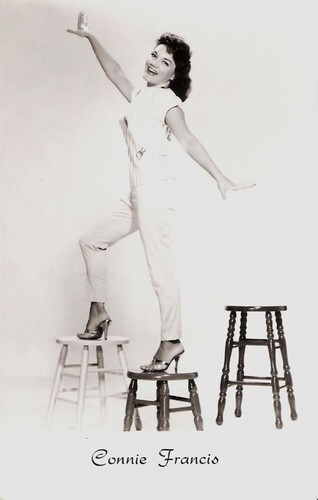
Dutch postcard by Gebr. Spanjersberg N.V., Rotterdam, no. 5870.
5,000 fan letters a week
Connie Francis was born Concetta Rosa Maria Franconero in 1937 in Newark, New Jersey. She was the first child of George Franconero (1911–1996) and Ida Franconero née Ferrari-di Vito. Conny was originally supposed to be born in Brooklyn, where her family lived at the time. However, her mother was visiting relatives in Newark and attended an all-night dance when she went into labour.
Concetta was educated at Arts High School and was a music student of her father. At age 11, she appeared on Arthur Godfrey's 'Talent Scouts' (1948) as a singer and accordionist. During rehearsals, Godfrey advised the girl to change her stage name to Connie Francis for easier pronunciation. Between 1953 and 1955, she appeared on the TV variety show Startime Kids. George Franconero Sr. and Francis's manager, George Scheck raised money for a recording session of four songs, which they hoped to sell to a major record company.
MGM released 'Freddie' as Francis's first single, which turned out to be a commercial failure, just like her next eight solo singles. In the fall of 1957, Francis enjoyed her first modest success with a duet single she had recorded with Marvin Rainwater: 'The Majesty of Love'. With her first smash hit 'Who's Sorry Now' (1957), she became the most internationally successful Pop singer. She originally did not want to sing 'Who's Sorry Now', since it was originally written in 1923 by Bert Kalmar and Harry Ruby. Her father convinced her otherwise.
In 1957, Connie Francis earned her first million dollars, topped polls for Favourite Female Singer and received 5,000 fan letters a week. Her next hits were 'Stupid Cupid' (1958) and 'Lipstick On Your Collar' (1959). She toured the US, Australia, New Zealand, South Africa and Europe, and made many records.
Another number one hit was 'Everybody's Somebody's Fool' (1960). For a time, she had her television show and performed in nightclubs and concerts. She joined ASCAP in 1959. Her popular song compositions include 'Senza Mama' and 'Italian Lullaby'.
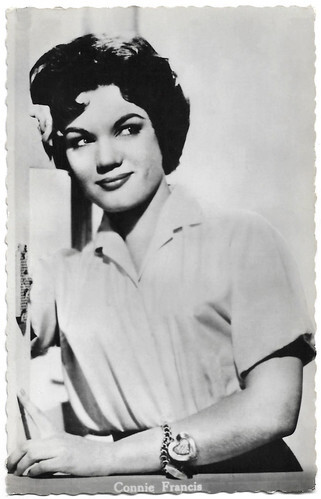
Dutch postcard by MUVA.
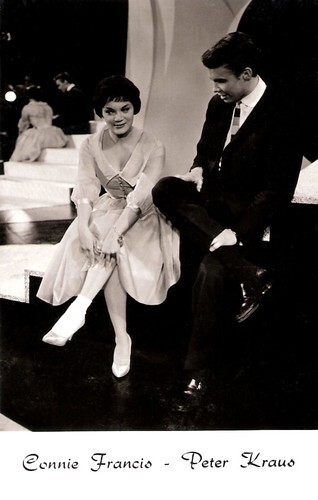
Vintage postcard. Caption: Connie Francis - Peter Kraus .
Viral on TikTok
Connie Francis was the star of four vehicles developed by MGM for her. Her first film was Where the Boys Are (Henry Levin, 1960) in which she was top-billed and also sang the title song. The film introduced the concept of spring break, as the once sleepy town of Fort Lauderdale became the hotspot for college students on their spring vacation in the wake of the film's success. She also starred in Follow the Boys (Richard Thorpe, 1963), Looking for Love (Don Weis, 1964) and When the Boys Meet the Girls (Alvin Ganzer, 1965). The latter was a remake of the Judy Garland musical Girl Crazy (Norman Taurog, Busby Berkeley, 1943).
Offscreen, she provided the singing voice for Tuesday Weld in Rock, Rock, Rock! (Will Price, 1956), Freda Holloway in Jamboree (Roy Lockwood, 1957) and Jayne Mansfield in The Sheriff of Fractured Jaw (Raoul Walsh, 1958). In the U.S., Connie Francis had a third number-one hit in 1962: 'Don't Break the Heart That Loves You'. Due to music trends in the early and mid-1960s, especially the British Invasion, Francis's chart success on Billboard's Hot 100 began to wane after 1963. She had her final top-ten hit, 'Vacation' (1962).
Francis's first autobiography, 'For Every Young Heart', was published in 1963. She had a tumultuous life, which included a relationship with singer Bobby Darin thwarted by her father, four divorces, a rape by a stranger in a motel in 1974, her brother, George Franconero Jr, an attorney to whom she was very close, murdered by Mafia hitmen in 1981, and partially revoked diagnoses of ADHD, bipolarity and PTSD.
Her life prompted a screenplay written by singer Gloria Estefan in 2009 for a biopic, which, however, never came to fruition. The screenplay was based on Francis' second autobiography, 'Who's Sorry Now?' (1984). A third autobiography, 'Among My Souvenirs', was published in 2017. Shortly before her death, a new generation discovered Francis after her relatively unknown song 'Pretty Little Baby '(1962) went viral on TikTok.
Her four husbands were Richard Eugene "Dick" Kanellis (1964-1964), Joseph Garzilli (1973-1978), Isadore John "Izzy" Dimaria (1971-1971) and Bob Parkinson (1985-1986). All her marriages ended in divorce. Her son is Joseph George Garzilli. Connie Francis remains one of the best-selling music artists in history, with estimated sales of over 100 million records.
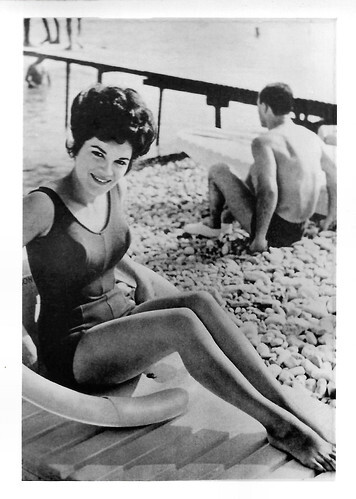
Dutch collector card.

Dutch postcard. Photo: James J. Krugmann, New York.
Sources: Hans Beerekamp (Het Schimmenrijk - Dutch), Wikipedia and .

Dutch postcard.

Dutch postcard by Gebr. Spanjersberg N.V., Rotterdam, no. 5870.
5,000 fan letters a week
Connie Francis was born Concetta Rosa Maria Franconero in 1937 in Newark, New Jersey. She was the first child of George Franconero (1911–1996) and Ida Franconero née Ferrari-di Vito. Conny was originally supposed to be born in Brooklyn, where her family lived at the time. However, her mother was visiting relatives in Newark and attended an all-night dance when she went into labour.
Concetta was educated at Arts High School and was a music student of her father. At age 11, she appeared on Arthur Godfrey's 'Talent Scouts' (1948) as a singer and accordionist. During rehearsals, Godfrey advised the girl to change her stage name to Connie Francis for easier pronunciation. Between 1953 and 1955, she appeared on the TV variety show Startime Kids. George Franconero Sr. and Francis's manager, George Scheck raised money for a recording session of four songs, which they hoped to sell to a major record company.
MGM released 'Freddie' as Francis's first single, which turned out to be a commercial failure, just like her next eight solo singles. In the fall of 1957, Francis enjoyed her first modest success with a duet single she had recorded with Marvin Rainwater: 'The Majesty of Love'. With her first smash hit 'Who's Sorry Now' (1957), she became the most internationally successful Pop singer. She originally did not want to sing 'Who's Sorry Now', since it was originally written in 1923 by Bert Kalmar and Harry Ruby. Her father convinced her otherwise.
In 1957, Connie Francis earned her first million dollars, topped polls for Favourite Female Singer and received 5,000 fan letters a week. Her next hits were 'Stupid Cupid' (1958) and 'Lipstick On Your Collar' (1959). She toured the US, Australia, New Zealand, South Africa and Europe, and made many records.
Another number one hit was 'Everybody's Somebody's Fool' (1960). For a time, she had her television show and performed in nightclubs and concerts. She joined ASCAP in 1959. Her popular song compositions include 'Senza Mama' and 'Italian Lullaby'.

Dutch postcard by MUVA.

Vintage postcard. Caption: Connie Francis - Peter Kraus .
Viral on TikTok
Connie Francis was the star of four vehicles developed by MGM for her. Her first film was Where the Boys Are (Henry Levin, 1960) in which she was top-billed and also sang the title song. The film introduced the concept of spring break, as the once sleepy town of Fort Lauderdale became the hotspot for college students on their spring vacation in the wake of the film's success. She also starred in Follow the Boys (Richard Thorpe, 1963), Looking for Love (Don Weis, 1964) and When the Boys Meet the Girls (Alvin Ganzer, 1965). The latter was a remake of the Judy Garland musical Girl Crazy (Norman Taurog, Busby Berkeley, 1943).
Offscreen, she provided the singing voice for Tuesday Weld in Rock, Rock, Rock! (Will Price, 1956), Freda Holloway in Jamboree (Roy Lockwood, 1957) and Jayne Mansfield in The Sheriff of Fractured Jaw (Raoul Walsh, 1958). In the U.S., Connie Francis had a third number-one hit in 1962: 'Don't Break the Heart That Loves You'. Due to music trends in the early and mid-1960s, especially the British Invasion, Francis's chart success on Billboard's Hot 100 began to wane after 1963. She had her final top-ten hit, 'Vacation' (1962).
Francis's first autobiography, 'For Every Young Heart', was published in 1963. She had a tumultuous life, which included a relationship with singer Bobby Darin thwarted by her father, four divorces, a rape by a stranger in a motel in 1974, her brother, George Franconero Jr, an attorney to whom she was very close, murdered by Mafia hitmen in 1981, and partially revoked diagnoses of ADHD, bipolarity and PTSD.
Her life prompted a screenplay written by singer Gloria Estefan in 2009 for a biopic, which, however, never came to fruition. The screenplay was based on Francis' second autobiography, 'Who's Sorry Now?' (1984). A third autobiography, 'Among My Souvenirs', was published in 2017. Shortly before her death, a new generation discovered Francis after her relatively unknown song 'Pretty Little Baby '(1962) went viral on TikTok.
Her four husbands were Richard Eugene "Dick" Kanellis (1964-1964), Joseph Garzilli (1973-1978), Isadore John "Izzy" Dimaria (1971-1971) and Bob Parkinson (1985-1986). All her marriages ended in divorce. Her son is Joseph George Garzilli. Connie Francis remains one of the best-selling music artists in history, with estimated sales of over 100 million records.

Dutch collector card.

Dutch postcard. Photo: James J. Krugmann, New York.
Sources: Hans Beerekamp (Het Schimmenrijk - Dutch), Wikipedia and .
Published on July 19, 2025 22:00
July 18, 2025
Victor Mature
Hunky American leading man Victor Mature (1913-1999) starred in Biblical Epics like Samson and Delilah (1949), and The Robe (1953). He was known for his dark good looks and mega-watt smile. Mature also appeared in the classics One Million B.C. (1940), My Darling Clementine (1946), Kiss of Death (1947), and in a large number of musicals opposite such stars as Rita Hayworth and Betty Grable.
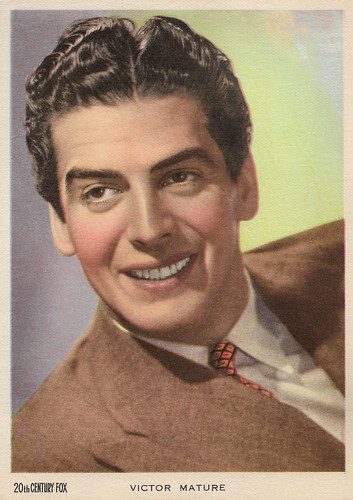
Uruguayan postcard by CF. Photo: 20th Century Fox.
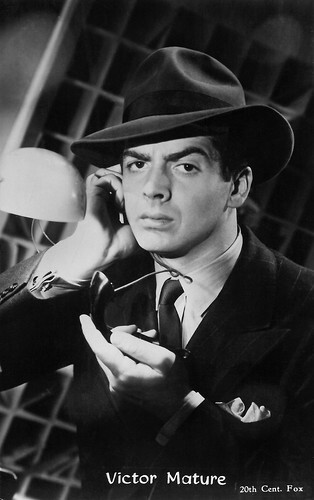
Vintage postcard. Photo: 20th Century-Fox. Victor Mature in I Wake Up Screaming (H. Bruce Humberstone, 1941).
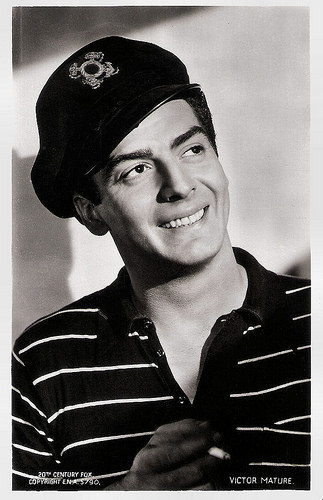
British Real Photograph postcard, no. 5790. Photo: 20th Century Fox. Publicity still for Song of the Islands (Walter Lang, 1942).
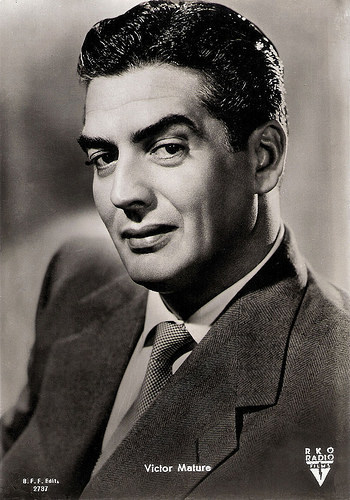
Italian postcard by B.F.F. Edit, no. 2787. Photo: RKO Radio Films.
What a beautiful hunk of man!
Victor John Mature was born in Louisville, Kentucky, in 1913. His father, cutlery sharpener Marcellus George (Gelindo) Mature, was Italian (from Pinzolo, Trentino), and his mother, Clara P. (Ackley), was of Swiss-German and German descent. Mature worked as a teenager with his father as a salesman for butcher supplies. He briefly sold candy and operated a restaurant before moving to California. Hoping to become an actor, he studied at the Pasadena Playhouse in California. For three years, he lived in a tent in the backyard of the mother of a fellow student, Catherine Lewis.
He was spotted by an agent for Hal Roach while acting in a production of To Quito and Back by Ben Hecht at the Pasadena Playhouse. Mature signed a seven-year contract with Roach in September 1939. He auditioned for Gone with the Wind (Victor Fleming, 1939) for the role ultimately played by his fellow Playhouse student, George Reeves. Roach cast Mature in a small role in the comedy The Housekeeper's Daughter (Hal Roach, 1939), then gave him his first leading role, as a fur-clad caveman in One Million B.C. (Hal Roach Jr., Hal Roach, 1940) opposite Carole Landis. The film was highly publicised, and it raised Mature's profile. Hedda Hopper called him "a sort of miniature Johnny Weissmuller ".
Roach then put him in a Swashbuckler set during the War of 1812, Captain Caution (Richard Wallace, 1940). As Hal Roach only made a handful of films every year, he loaned out Mature's services to RKO, who used him as a leading man in the Anna Neagle musical, No, No, Nanette (Herbert Wilcox, 1940). The studio people were so pleased with his performance, they bought an option to take over half of Mature's contract with Hal Roach, enabling them to draw on his services for two films a year over three years.
Mature also appeared in the Broadway musical Lady in the Dark (1941) with a book by Moss Hart and songs from Ira Gershwin and Kurt Weill. He played Randy Curtis, a film star boyfriend of the show's protagonist, magazine editor Liza Elliott (Gertrude Lawrence). In the musical, his character was described as 'What a beautiful hunk of man!' The musical was a smash hit, making a star of Danny Kaye and Macdonald Carey, and causing fresh appreciation for Mature's talents.
His performance was well received, and the description 'Beautiful Hunk of Man' would be frequently used to describe Mature throughout his career. Fox bought out the four years remaining on Mature's contract with Hal Roach, and he appeared in such popular musicals as My Gal Sal (Irving Cummings, 1942) with Rita Hayworth and Footlight Serenade (Gregory Ratoff, 1942) with Betty Grable . After achieving acclaim with these films, he served in the Coast Guard in World War II. This meant that when Paramount filmed Lady in the Dark, Mature was unable to reprise his stage role.

British postcard in the Picturegoer, London, no. 1457, ca. 1939-1940. Photo: Hal Roach.
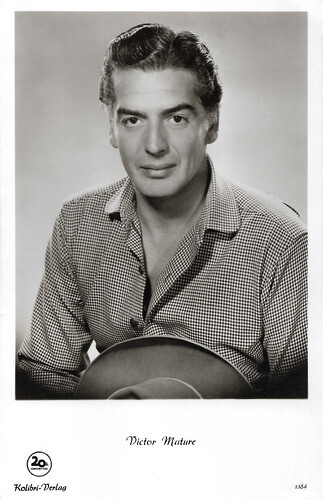
West German postcard by Kolibri-Verlag, no. 1384. Photo: 20th Century Fox.
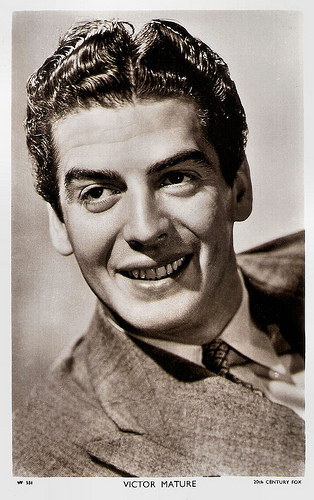
British postcard in the Picturegoer Series, London, no. W 531. Photo: 20th Century Fox.
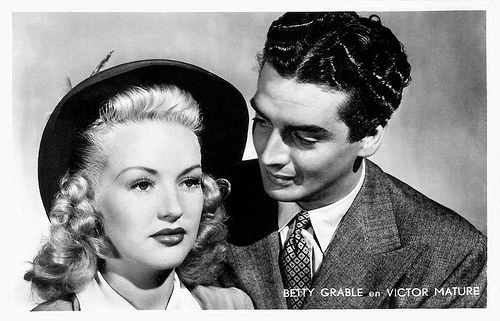
Dutch postcard by Uitg. J. Sleding N.V., Amsterdam, no. 33. Photo: 20th Century Fox. Publicity still for I Wake Up Screaming (H. Bruce Humberstone, 1941) with Betty Grable .

Dutch collectors card in the Filmsterren: een Portret series by Edito Service S.A., 1996. Photo: United Artists / The Kobal Collection. Publicity still for Shanghai Gesture (Josef von Sternberg, 1941).
A man who was 100 per cent yellow
Victor Mature was honourably discharged from the Coast Guard in November 1945, and he resumed his acting career. Soon, he became one of Hollywood's busiest and most popular actors, though he was rarely given the critical respect he often deserved. His roles in John Ford's My Darling Clementine (1946), playing Doc Holliday opposite Henry Fonda 's Wyatt Earp, and in Henry Hathaway's Kiss of Death (1947) were among his finest works.
Mature's career received a massive lift when he was borrowed by Cecil B. DeMille at Paramount to play the lead in the $3.5 million biblical spectacular Samson and Delilah (1949) opposite Hedy Lamarr . Despite his physique and his tough guy persona, Mature was a man of many fears and phobias. During filming, Mature was frightened by a number of the animals and mechanical props used in the production, including the lions, the wind machine, the swords and even the water.
This infuriated director Cecil B. DeMille , who bellowed through his megaphone at the assembled cast and crew: "I have met a few men in my time. Some have been afraid of heights, some have been afraid of water, some have been afraid of fire, some have been afraid of closed spaces. Some have even been afraid of open spaces - or themselves. But in all my 35 years of picture-making experience, Mr. Mature, I have not until now met a man who was 100 per cent yellow."
Groucho Marx famously said he would not go to see the film because "the leading man's tits are bigger than the leading lady's". However, Samson and Delilah earned over $12 million during its original run, making it the most popular Hollywood movie of the 1940s. It ushered in a cycle of spectacles set in the Ancient World.
Mature starred in such epics as Androcles and the Lion (Chester Erskine, 1952) opposite Jean Simmons , Demetrius and the Gladiators (Delmer Daves, 1954) with Susan Hayward , and The Egyptian (Michael Curtiz, 1954) with Jean Simmons and Gene Tierney . Jim Beaver at IMDb : "Never an energetic actor nor one of great artistic pretensions, he nevertheless continued as a Hollywood stalwart both in programme and in more prominent films like The Robe (1953)."
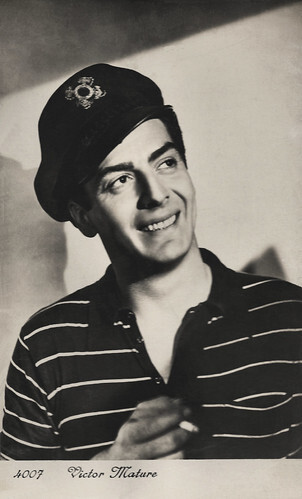
French postcard, no. 4007. Photo: 20th Century Fox. Publicity still for Song of the Islands (Walter Lang, 1942).
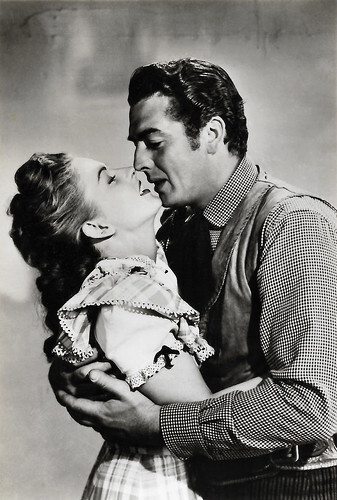
Vintage collector card. Photo: 20th Century Fox. Coleen Gray and Victor Mature in Fury at Furnace Creek (H. Bruce Humberstone, 1948).
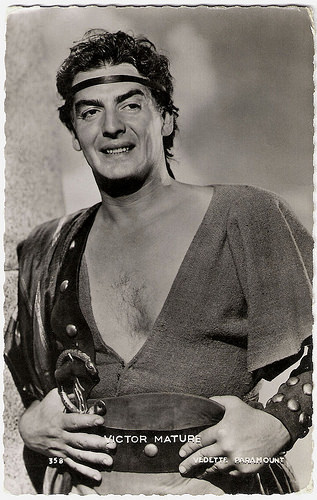
French postcard by Editions P.I., Paris, no. 358, 1954. Photo: Paramount Pictures Inc.. Publicity still for Samson and Delilah (Cecil B. DeMille, 1949).
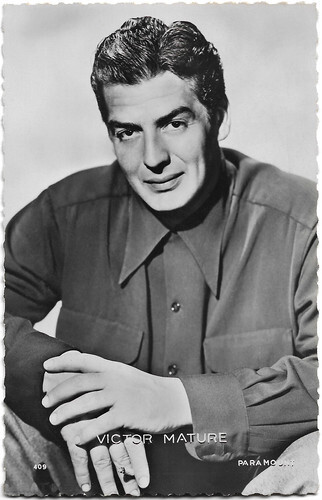
French postcard by Edition P.I., Paris, offered by Les Carbones Korès, no. 409. Photo: Paramount, 1953.
I'm not an actor - and I've got 64 films to prove it!
More interested in golf than acting, Victor Mature's appearances diminished through the late 1950s and 1960s. Applying for membership in the swank Los Angeles Country Club at the height of his fame, Mature was turned down and told that the golfing facility did not accept actors as members. His response: "I'm not an actor - and I've got 64 films to prove it!"
Mature was reunited with producer Irwin Allen for The Big Circus (Joseph M. Newman, 1959) with Red Buttons. In Italy, he starred in the Peplum Annibale/Hannibal (Carlo Ludovico Bragaglia, Edgar G. Ulmer, 1959), with Gabriele Ferzetti and Rita Gam . In Italy, he also appeared in I tartari/The Tartars (Richard Thorpe, 1961) with Orson Welles .
Mature then retired from acting. Five years later, he made a stunning comeback in the hilarious Italian-British comedy Caccia alla volpe/After the Fox (Vittorio de Sica, 1966), based on a play by Neil Simon. He starred opposite Peter Sellers and Britt Ekland as Tony Powell, an ageing American actor who is living off his reputation from his earlier body of work.
In a similar vein, he played a giant, The Big Victor, in The Monkees film Head (Bob Rafelson, 1968). Golf eventually took over his activities. Wikipedia quotes him saying, "Actually, I am a golfer. That is my real occupation. I never was an actor. Ask anybody, particularly the critics." His last feature film appearance was a cameo as a millionaire in Firepower (Michael Winner, 1979), starring Sophia Loren and James Coburn, and, after a cameo as Samson's father in the TV remake Samson and Delilah (Lee Philips, 1984), he retired for good. Rumours occasionally surfaced of another comeback, but none came to fruition.
Victor Mature died of cancer at his Rancho Santa Fe, California, home in 1999. Mature was married five times. His wives were actress Frances Charles (1938–1940), Martha Stephenson Kemp (1941–1943), Dorothy Stanford Berry (1948–1955), Adrienne Urwick (1959–1969) and Loretta Sebena (1974 until his death). With Sebena, he had his only child, daughter Victoria, who is now an opera singer, as was her mother.
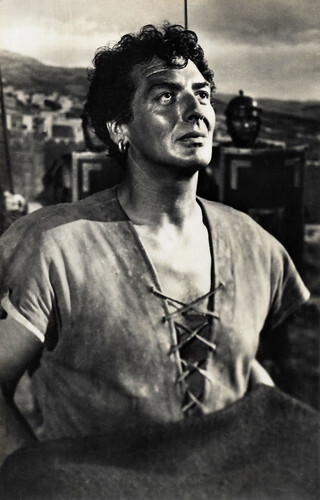
Spanish postcard. Photo: 20th Century-Fox. Victor Mature in The Robe (Henry Koster, 1953).
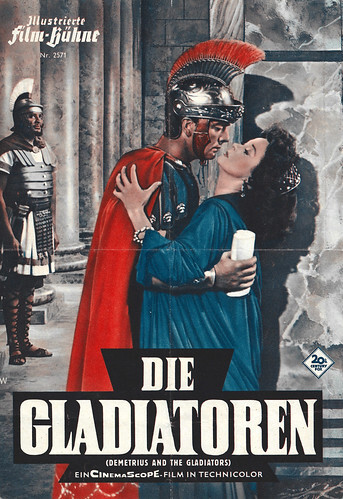
Cover page of a film programme by Illustrierte Film-Bühne, no. 2571. Victor Mature and Susan Hayward in Demetrius and the Gladiators (Delmer Daves, 1954).
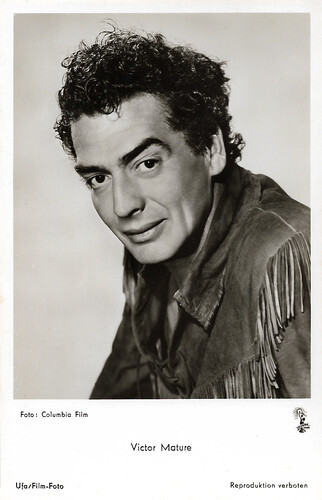
West German postcard by Ufa/Film-Foto, Berlin-Tempelhof, no. FK 3032. Photo: Columbia Film. Victor Mature in The Last Frontier (Anthony Mann, 1955).
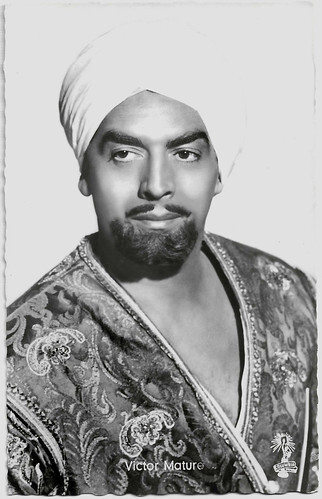
West German postcard by Kolibri-Verlag G.m.b.H., Minden / Westf., no. 2409. Photo: Columbia. Victor Mature in Zarak (Terence Young, 1956).
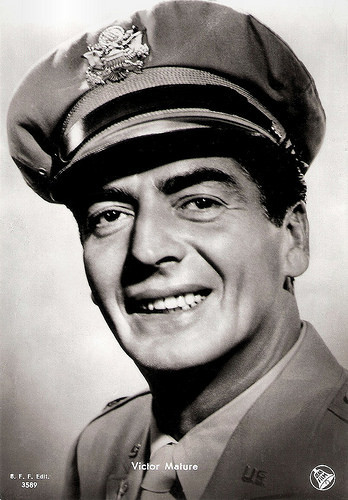
Italian postcard by B.F.F. Edit, no. 3589. Photo: Dear Film. Publicity still for China Doll (Frank Borzage, 1958).
Sources: (IMDb), Wikipedia and .

Uruguayan postcard by CF. Photo: 20th Century Fox.

Vintage postcard. Photo: 20th Century-Fox. Victor Mature in I Wake Up Screaming (H. Bruce Humberstone, 1941).

British Real Photograph postcard, no. 5790. Photo: 20th Century Fox. Publicity still for Song of the Islands (Walter Lang, 1942).

Italian postcard by B.F.F. Edit, no. 2787. Photo: RKO Radio Films.
What a beautiful hunk of man!
Victor John Mature was born in Louisville, Kentucky, in 1913. His father, cutlery sharpener Marcellus George (Gelindo) Mature, was Italian (from Pinzolo, Trentino), and his mother, Clara P. (Ackley), was of Swiss-German and German descent. Mature worked as a teenager with his father as a salesman for butcher supplies. He briefly sold candy and operated a restaurant before moving to California. Hoping to become an actor, he studied at the Pasadena Playhouse in California. For three years, he lived in a tent in the backyard of the mother of a fellow student, Catherine Lewis.
He was spotted by an agent for Hal Roach while acting in a production of To Quito and Back by Ben Hecht at the Pasadena Playhouse. Mature signed a seven-year contract with Roach in September 1939. He auditioned for Gone with the Wind (Victor Fleming, 1939) for the role ultimately played by his fellow Playhouse student, George Reeves. Roach cast Mature in a small role in the comedy The Housekeeper's Daughter (Hal Roach, 1939), then gave him his first leading role, as a fur-clad caveman in One Million B.C. (Hal Roach Jr., Hal Roach, 1940) opposite Carole Landis. The film was highly publicised, and it raised Mature's profile. Hedda Hopper called him "a sort of miniature Johnny Weissmuller ".
Roach then put him in a Swashbuckler set during the War of 1812, Captain Caution (Richard Wallace, 1940). As Hal Roach only made a handful of films every year, he loaned out Mature's services to RKO, who used him as a leading man in the Anna Neagle musical, No, No, Nanette (Herbert Wilcox, 1940). The studio people were so pleased with his performance, they bought an option to take over half of Mature's contract with Hal Roach, enabling them to draw on his services for two films a year over three years.
Mature also appeared in the Broadway musical Lady in the Dark (1941) with a book by Moss Hart and songs from Ira Gershwin and Kurt Weill. He played Randy Curtis, a film star boyfriend of the show's protagonist, magazine editor Liza Elliott (Gertrude Lawrence). In the musical, his character was described as 'What a beautiful hunk of man!' The musical was a smash hit, making a star of Danny Kaye and Macdonald Carey, and causing fresh appreciation for Mature's talents.
His performance was well received, and the description 'Beautiful Hunk of Man' would be frequently used to describe Mature throughout his career. Fox bought out the four years remaining on Mature's contract with Hal Roach, and he appeared in such popular musicals as My Gal Sal (Irving Cummings, 1942) with Rita Hayworth and Footlight Serenade (Gregory Ratoff, 1942) with Betty Grable . After achieving acclaim with these films, he served in the Coast Guard in World War II. This meant that when Paramount filmed Lady in the Dark, Mature was unable to reprise his stage role.

British postcard in the Picturegoer, London, no. 1457, ca. 1939-1940. Photo: Hal Roach.

West German postcard by Kolibri-Verlag, no. 1384. Photo: 20th Century Fox.

British postcard in the Picturegoer Series, London, no. W 531. Photo: 20th Century Fox.

Dutch postcard by Uitg. J. Sleding N.V., Amsterdam, no. 33. Photo: 20th Century Fox. Publicity still for I Wake Up Screaming (H. Bruce Humberstone, 1941) with Betty Grable .

Dutch collectors card in the Filmsterren: een Portret series by Edito Service S.A., 1996. Photo: United Artists / The Kobal Collection. Publicity still for Shanghai Gesture (Josef von Sternberg, 1941).
A man who was 100 per cent yellow
Victor Mature was honourably discharged from the Coast Guard in November 1945, and he resumed his acting career. Soon, he became one of Hollywood's busiest and most popular actors, though he was rarely given the critical respect he often deserved. His roles in John Ford's My Darling Clementine (1946), playing Doc Holliday opposite Henry Fonda 's Wyatt Earp, and in Henry Hathaway's Kiss of Death (1947) were among his finest works.
Mature's career received a massive lift when he was borrowed by Cecil B. DeMille at Paramount to play the lead in the $3.5 million biblical spectacular Samson and Delilah (1949) opposite Hedy Lamarr . Despite his physique and his tough guy persona, Mature was a man of many fears and phobias. During filming, Mature was frightened by a number of the animals and mechanical props used in the production, including the lions, the wind machine, the swords and even the water.
This infuriated director Cecil B. DeMille , who bellowed through his megaphone at the assembled cast and crew: "I have met a few men in my time. Some have been afraid of heights, some have been afraid of water, some have been afraid of fire, some have been afraid of closed spaces. Some have even been afraid of open spaces - or themselves. But in all my 35 years of picture-making experience, Mr. Mature, I have not until now met a man who was 100 per cent yellow."
Groucho Marx famously said he would not go to see the film because "the leading man's tits are bigger than the leading lady's". However, Samson and Delilah earned over $12 million during its original run, making it the most popular Hollywood movie of the 1940s. It ushered in a cycle of spectacles set in the Ancient World.
Mature starred in such epics as Androcles and the Lion (Chester Erskine, 1952) opposite Jean Simmons , Demetrius and the Gladiators (Delmer Daves, 1954) with Susan Hayward , and The Egyptian (Michael Curtiz, 1954) with Jean Simmons and Gene Tierney . Jim Beaver at IMDb : "Never an energetic actor nor one of great artistic pretensions, he nevertheless continued as a Hollywood stalwart both in programme and in more prominent films like The Robe (1953)."

French postcard, no. 4007. Photo: 20th Century Fox. Publicity still for Song of the Islands (Walter Lang, 1942).

Vintage collector card. Photo: 20th Century Fox. Coleen Gray and Victor Mature in Fury at Furnace Creek (H. Bruce Humberstone, 1948).

French postcard by Editions P.I., Paris, no. 358, 1954. Photo: Paramount Pictures Inc.. Publicity still for Samson and Delilah (Cecil B. DeMille, 1949).

French postcard by Edition P.I., Paris, offered by Les Carbones Korès, no. 409. Photo: Paramount, 1953.
I'm not an actor - and I've got 64 films to prove it!
More interested in golf than acting, Victor Mature's appearances diminished through the late 1950s and 1960s. Applying for membership in the swank Los Angeles Country Club at the height of his fame, Mature was turned down and told that the golfing facility did not accept actors as members. His response: "I'm not an actor - and I've got 64 films to prove it!"
Mature was reunited with producer Irwin Allen for The Big Circus (Joseph M. Newman, 1959) with Red Buttons. In Italy, he starred in the Peplum Annibale/Hannibal (Carlo Ludovico Bragaglia, Edgar G. Ulmer, 1959), with Gabriele Ferzetti and Rita Gam . In Italy, he also appeared in I tartari/The Tartars (Richard Thorpe, 1961) with Orson Welles .
Mature then retired from acting. Five years later, he made a stunning comeback in the hilarious Italian-British comedy Caccia alla volpe/After the Fox (Vittorio de Sica, 1966), based on a play by Neil Simon. He starred opposite Peter Sellers and Britt Ekland as Tony Powell, an ageing American actor who is living off his reputation from his earlier body of work.
In a similar vein, he played a giant, The Big Victor, in The Monkees film Head (Bob Rafelson, 1968). Golf eventually took over his activities. Wikipedia quotes him saying, "Actually, I am a golfer. That is my real occupation. I never was an actor. Ask anybody, particularly the critics." His last feature film appearance was a cameo as a millionaire in Firepower (Michael Winner, 1979), starring Sophia Loren and James Coburn, and, after a cameo as Samson's father in the TV remake Samson and Delilah (Lee Philips, 1984), he retired for good. Rumours occasionally surfaced of another comeback, but none came to fruition.
Victor Mature died of cancer at his Rancho Santa Fe, California, home in 1999. Mature was married five times. His wives were actress Frances Charles (1938–1940), Martha Stephenson Kemp (1941–1943), Dorothy Stanford Berry (1948–1955), Adrienne Urwick (1959–1969) and Loretta Sebena (1974 until his death). With Sebena, he had his only child, daughter Victoria, who is now an opera singer, as was her mother.

Spanish postcard. Photo: 20th Century-Fox. Victor Mature in The Robe (Henry Koster, 1953).

Cover page of a film programme by Illustrierte Film-Bühne, no. 2571. Victor Mature and Susan Hayward in Demetrius and the Gladiators (Delmer Daves, 1954).

West German postcard by Ufa/Film-Foto, Berlin-Tempelhof, no. FK 3032. Photo: Columbia Film. Victor Mature in The Last Frontier (Anthony Mann, 1955).

West German postcard by Kolibri-Verlag G.m.b.H., Minden / Westf., no. 2409. Photo: Columbia. Victor Mature in Zarak (Terence Young, 1956).

Italian postcard by B.F.F. Edit, no. 3589. Photo: Dear Film. Publicity still for China Doll (Frank Borzage, 1958).
Sources: (IMDb), Wikipedia and .
Published on July 18, 2025 22:00
July 17, 2025
Estrellas de Cine: Spanish and Mexican Stars
Between 1927 and 1935, just after the introduction of sound film, a new phenomenon emerged. Multi-language versions of films were made both in Hollywood and at the European Paramount studio near Paris. These were versions of Hollywood productions in French, German, Hungarian, Russian or even Dutch. The biggest market was Spanish-speaking countries, and Spanish versions with Spanish or Mexican actors were made at the assembly line. At the time, for instance, millions of Latin Americans did not know Bela Lugosi as the star of Dracula (Tod Browning, 1930) but had instead seen Carlos Villarías in Drácula (George Melford, 1931). After the multi-language boom ended, many of these actors left Hollywood again and returned home. Others had surprisingly long careers in the Mexican film industry. The Spanish series Estrellas del Cine offers a glimpse of these often forgotten film stars.
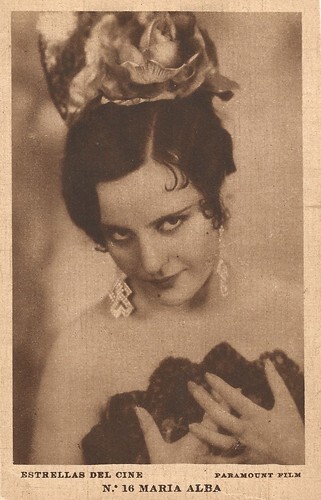
Spanish postcard in the Series Estrellas del cine by Editorial Grafica, Barcelona, no. 16. Photo: Paramount Film.
Spanish-American film actress and Flamenco dancer Maria Alba (1905-1999) was one of Hollywood's Latin stars. The Fox Film Corporation signed her after she won a Fox Film contest in Spain. She appeared in 25 feature films, starting with Road House (Richard Rosson, 1928) with Lionel Barrymore. Her most notable appearances were probably as 'Saturday' in the Douglas Fairbanks film Mr Robinson Crusoe (A. Edward Sutherland, 1932) and the exotic 'Princess Nadji' in the Bela Lugosi serial The Return of Chandu (Ray Taylor, 1934). Other Latin actresses working in Hollywood, like Lupe Vélez or Dolores del Río, became fluent in English. Still, Maria Alba spoke English with a thick accent, which limited her casting opportunities, and she made her last films in Mexico.
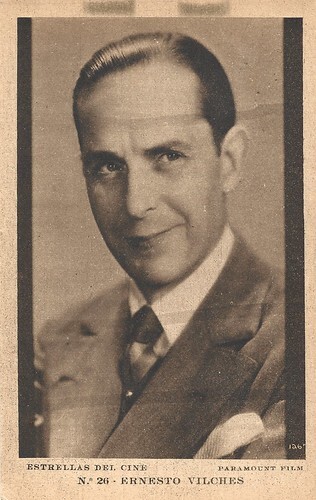
Spanish postcard in the Series Estrellas del cine by Editorial Grafica, Barcelona, no. 26. Photo: Paramount Film.
Spanish artist, theatre director and actor Ernesto Vilches (1879-1954) worked in Spain, Argentina, Mexico and other Latin American countries. He had his own company and was one of the first Spanish actors in Hollywood. He already made his film debut in 1909 in Francisco Oliver's Aventura de Pepín, followed by another outstanding silent Spanish film, El Golfo (José de Togores, 1917). In 1930-1931, he acted in five Spanish-language films at Paramount and MGM in Hollywood. First, he appeared in the Paramount production Cascarrabias (Cyril Gardner, 1930). In the MGM film Su última noche (Carlos F. Borcosque, Chester M. Franklin, 1931), he acted opposite Spanish actors who later became famous in Italian cinema: Conchita Montenegro and Juan de Landa. In Borcosque's Cheri-Bibi (1931), based on Gaston Leroux and the alternate version of The Phantom of Paris (1931), he had the lead as a man who transforms himself into his - dead - rival. After 1931, Vilches' career in Hollywood slowed down. He returned to Spain for El desaparecido (Antonio Graciani, 1934), and co-directed there El cientro trece (1935).
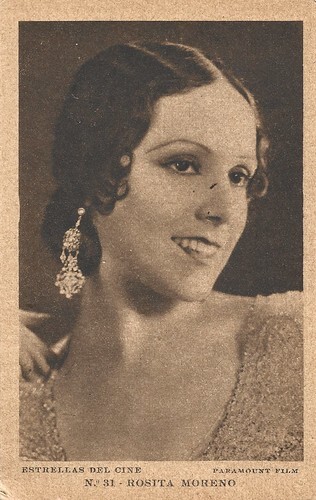
Spanish postcard in the Series Estrellas del cine by Editorial Grafica, Barcelona, no. 31. Photo: Paramount Film.
From 1930 on, Spanish actress Rosita Moreno (1907-1993) starred in Spanish-language versions of Hollywood films. That year, she appeared in the Spanish-language version of Paramount on Parade (1930). Among her best-known films are Piernas de seda / Silk Legs (1935), El día que me quieras / The Day You Love Me (1935) and Tango Bar (1935). In the latter two, her co-star was Carlos Gardel, the legendary songbird of Buenos Aires. She also played supporting parts in English language films such as Her Wedding Night (1930) starring Clara Bow, and Ladies Should Listen (1934) opposite Cary Grant. In Great Britain, she made Stamboul (1931) with Warwick Ward. Moreno appeared in more than 30 films in a career that spanned more than 20 years, often travelling through several countries in quick succession. She played her final role in 1949 in an episode of the TV series The Clock, in which she shared leading roles with George Reeves. Little is known about her after that point.
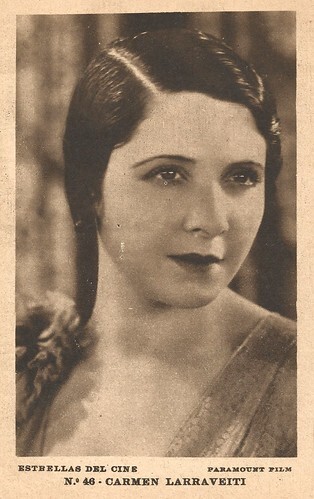
Spanish postcard in the Series Estrellas del cine by Editorial Grafica, Barcelona, no. 46. Photo: Paramount Film.
Carmen Larrabeiti (1904-1968) was a Spanish stage and screen actress. In 1926, Larrabeiti made her film debut with Currito de la Cruz (Alejandro Pérez Lugín, 1926). After spending time in Paris, she was hired, along with her husband, by the Paramount company to shoot Doña Mentiras / The Lady Lies (1930), Toda una vida / Sarah and Son (1930), La carta / The Letter (1931) and La fiesta del diablo / The Devil's Holiday (1931), all directed by former Latin lover film star Adelqui Migliar. She then moved to Hollywood with her husband. At Fox, she recorded Spanish versions of some of Hollywood's hits for the Spanish-speaking public. She acted in Esclavas de la moda / On Your Back (David Howard, 1931) with Julio Peña, ¿Conoces a tu mujer? / Don't Bet on Women (David Howard, 1931) with Rafael Rivelles, and La ley del harén / Fazil (Lewis Seiler, 1931) with José Mojica. In 1932, Larrabeiti had to return to Spain, suffering from an illness that kept her away from the stage for good.
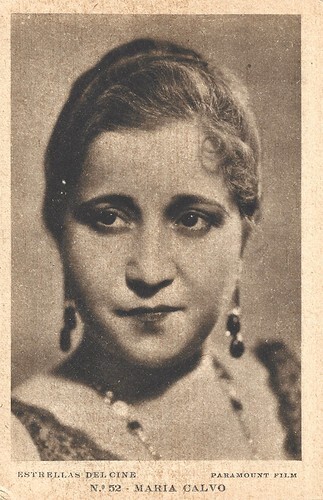
Spanish postcard in the Series Estrellas del cine by Editorial Grafica, Barcelona, no. 52. Photo: Paramount Film.
María Calvo (1892-1995) was a Spanish-American actress who worked in many Spanish alternate versions of early 1930s Hollywood films. Calvo debuted in 1930 in the Spanish alternate language version of The Benson Murder Case, called Il cuerpo del delitto (1930), shot at the Paramount studios in California. Between 1930 and 1935, she acted mostly in supporting parts in over twenty Spanish-speaking film productions shot in Hollywood. These were often alternate language versions of English spoken films, first at Paramount, but soon also at MGM and Fox. Examples are Sevilla de mis amores (1930), directed and performed by Ramon Novarro, Primavera en otoño (Eugene Forde, 1933), Rosa de Francia (1935), with Rosita Díaz Gimeno, José Peña, and Antonio Moreno, and El cantante de Napoles (Howard Bretherton, Moreno Cuyar, 1935), with Enrico Caruso Jr. In the late 1930s, she moved to Mexico, where, just before and during the war years, she acted in several films by Raphael J. Sevilla and William Rowland, including comedies with Cantinflas. After the war, she remained in Mexico for productions like Fernando Rivero's La morena de mi copla (1946), and Reina de reinas: La Virgen María (Miguel Contreras Torres, 1948) in which she played Elisabeth. After 1948, she only acted in one more film: the Spanish production Pleito de sangre (Ricardo Gascón, 1956). All in all, Calvo acted in over forty films.
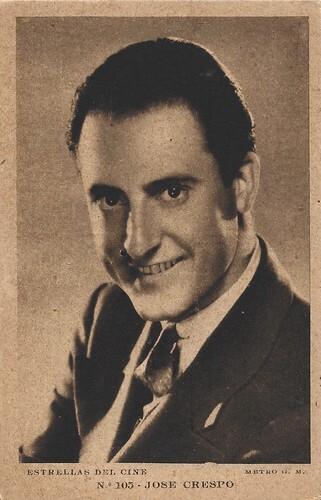
Spanish postcard in the Series Estrellas del cine by Editorial Grafica, Barcelona, no. 105. Photo: Paramount Film.
José Crespo Férez (1900-1997) was a Spanish actor who worked in Spain, Hollywood and Mexico. In 1926, he toured several Latin American countries and arrived in the United States in December 1926, where he had a great success in Los Angeles with the play 'El gran Galeoto' by José Echegaray. This attracted the attention of the film studios, and his first American film was Revenge (Edwin Carewe, 1928), starring Dolores Del Rio. He acted in one of the first sound films, the Fox production Joy Street (1929), starring Lois Moran. In May 1930, after a stay in Mexico, Metro-Goldwyn-Mayer offered him a long-term contract. Metro used him to replace John Gilbert in dubbed versions of Gilbert's films for Spanish America. The two actors got to know each other and became good friends. With the disappearance of silent films, he specialised (1930-35) in the dubbed and Spanish versions for United Artists, Fox and Metro-Goldwyn-Mayer. For Fox, he did mostly comedies, and for Metro, dramas. He also appeared in English films, while he spoke he language perfectly. He later acted in New York on CBS radio for the Hispanic market, including the series 'Hollywood por dentro'. When the Spanish dubbing studios were established in New York, he was hired as director. Crespo became the Spanish voice of Joseph Cotten in Paramount films. In 1936, he settled in Mexico and then, after a brief stay in Spain, he returned to the United States (1964) to direct the Spanish Theatre of New York.
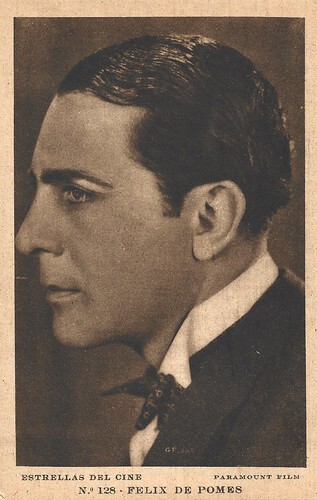
Spanish postcard in the Series Estrellas del cine by Editorial Grafica, Barcelona, no. 128. Photo: Paramount Film.
Félix de Pomés (1889-1969) was a Spanish actor, screenwriter and film director as well as a footballer and fencing champion. He acted in 72 films between 1928 and 1967. Félix de Pomés started his career as a film actor in Germany in the late 1920s, debuting as Teddy Bill in the silent film Die große Abenteuerin (Robert Wiene, 1928) starring Lili Damita. Until the end of the silent era, he had major parts in four more German films. When sound set in, De Pomés acted in Spanish language versions at the Paramount studios at Joinville, starting with Doña mentiras (Adelqui Migliar, 1930), the alternate version of The Lady Lies (1929), starring Carmen Larrabeiti. De Pomés had the lead at Paramount in El secreto del doctor (Migliar, 1930), the alternate-language version of The Doctor's Secret (1929). In 1931, he went to Hollywood to act in three Spanish versions of films at Fox, such as Cuerpo y alma (David Howard, 1931) with George Lewis. In 1933, he returned to Spain for a series of ten films produced in Barcelona in seven years.
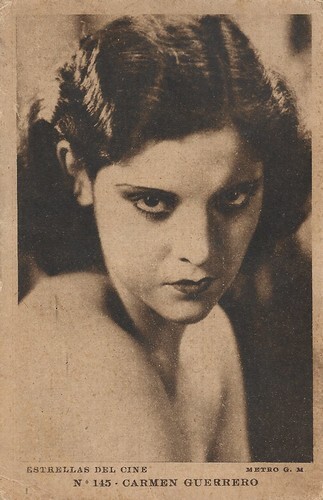
Spanish postcard in the Series Estrellas del cine by Editorial Grafica, Barcelona, no. 145. Photo: Metro G.M.
Carmen Guerrero (1911-1986) was a Mexican actress who had a successful career in Spanish alternate versions of early Hollywood sound films and afterwards in Mexican cinema of the early 1930s. After a bit part in the Laurel & Hardy comedy Double Whoopee (Lewis R. Foster, Hal Roach, 1929), Guerrero's first substantial part was in a Mexican independent production shot in California: Dios y ley (Guillermo Calles, 1930). This led to performances in a dozen Spanish alternate versions of Hollywood films, including the Spanish version of Dracula: Drácula (George Melford, 1931) in which Guerrero played Lucy/Lucia. She had the female leads in Cascarrabias (Cyril Gardner, 1930) opposite Ernesto Vilches and Barry Norton, Huye-Faldas (James W. Horne, 1931) with Charley Chase, Una cana al aire (Horne, 1931) again with Chase, Un fotógrafo distraído (Xavier Cugat, 1931) with Don Alvarado, and La gran jornada (David Howard, Samuel Schneider, Raoul Walsh, 1931), the Spanish version of The Big Trail. In 1932, Guerrero returned to Mexico as a celebrated movie star and played the female lead in several Mexican films.
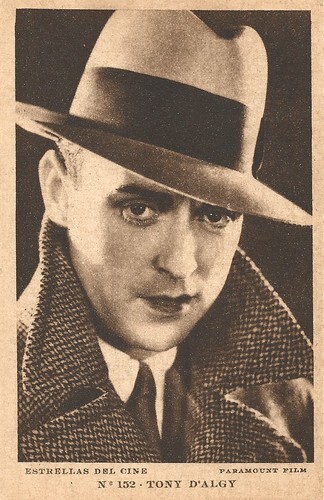
Spanish postcard in the Series Estrellas del cine by Editorial Grafica, Barcelona, no. 152.
Tony D'Algy (1897-1977) was a Portuguese film actor who appeared in 57 films between 1924 and 1949. D'Algy acted in various silent Hollywood films. In 1926, D'Algy also directed two films, The Reckless Mollycoddle, scripted by future director Tay Garnett, and the Spanish film Raza de hidalgos, with his sister Helena D'Algy and himself in the leads. In the early 1930s, he acted in Spanish sound versions of American films directed by Adelqui Migliar at the Paris Paramount studios, while he simultaneously also acted in French and Belgian early sound films. In the mid-1930s, he started to act in Spain but then moved to Argentina for several films, returning to Spain in 1940 for more films until 1949.
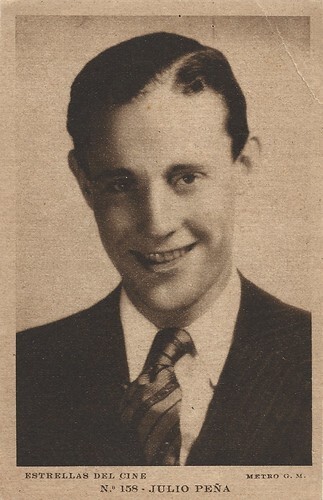
Spanish postcard in the Series Estrellas del cine by Editorial Grafica, Barcelona, no. 158.
Spanish actor Julio Peña (1912-1972) debuted in a Spanish language film at the Paris Paramount studio, Doña mentiras (Adelqui Migliar), the Spanish version of The Lady Lies, starring Carmen Larrabeiti and Félix de Pomés. He then acted at MGM in California in the Spanish version of Min and Bill, La fruta amarga (Arthur Gregor, José López Rubio, 1931) with Virginia Fábregas and Juan de Landa in the title roles. Peña stayed at MGM for the alternate language versions of Madame X, La mujer X (Carlos F. Borcosque, 1931). He had a first lead opposite Larrabeiti at Fox in Esclavas de la moda (David Howard, Francisco Moré de la Torre, 1931), the Spanish version of On Your Back, and also co-starred in the Fox film Mamá (Benito Perojo, 1931). Peña stayed at Fox for more Spanish language films: Primavera en otoño (Eugene Forde, 1933), Una viuda romántica (Louis King, 1933), Yo, tú y ella (John Reinhardt, 1933), La ciudad de cartón (Louis King, 1933), all starring Catalina Bárcena. Then followed the Fox productions Un capitán de cosacos (John Reinhardt, 1934) with José Mojica and Rosita Moreno, Julieta compra un hijo (Louis King, Gregorio Martínez Sierra, 1934) with Bárcena and Gilbert Roland, Rosa de Francia (José López Rubio, Gordon Wiles, 1935), and Fox's last Spanish language production: Angelina o el honor de un brigadier (Louis King, Miguel de Zárraga, 1935), a comedy starring Enrique de Rosas. After the Universal production Alas sobre El Chaco (Christy Cabanne, 1935), the Spanish version of Storm over the Andes, and four years of acting in alternative versions in California, Peña left Hollywood and returned to Spain to act on stage and on screen.
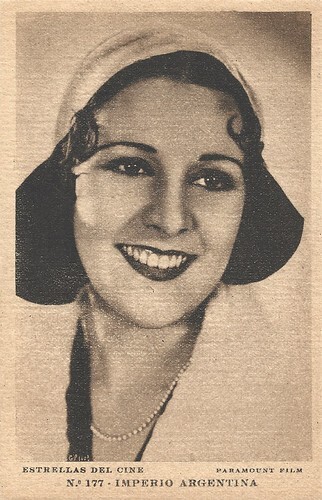
Spanish postcard in the Series Estrellas del cine by Editorial Grafica, Barcelona, no. 177. Photo: Paramount Film.
Imperio Argentina (1906-2003) was a singer, dancer and actress who appeared in more than 30 films. Although she was born in Buenos Aires, Argentina and was successful all over South America, she was a Spanish citizen. Besides Spain and South America, she also worked in France, Italy and Germany.
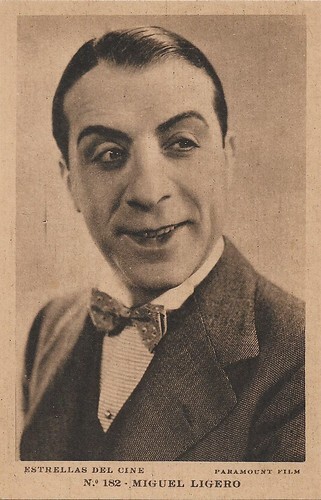
Spanish postcard in the Series Estrellas del cine by Editorial Grafica, Barcelona, no. 182. Photo: Paramount Film.
Miguel Ligero Rodríguez (1890-1968) was a Spanish revue, film and zarzuela actor. Ligero made his film debut in 1926, but it was not until the 1930s that he achieved true recognition as a leading screen figure in the Spanish cinema of the time. At the beginning of the decade, he shot at the Paramount studios in Joinville near Paris Spanish language versions of films, such as Doña mentiras (Adelqui Migliar, 1930), the Spanish version of The Lady Lies, starring Carmen Larrabeiti as the lying lady. After five more films at Joinville, Ligero went to the US and acted there in Hollywood versions for Spanish-speaking countries of Fox films, such as Hay que casar al príncipe (Lewis Seiler, 1931), starring José Mojica, and ¿Conoces a tu mujer? (David Howard, 1931) with Larrabeiti again. After two more films in Hollywood, Ligero returned to Spain.
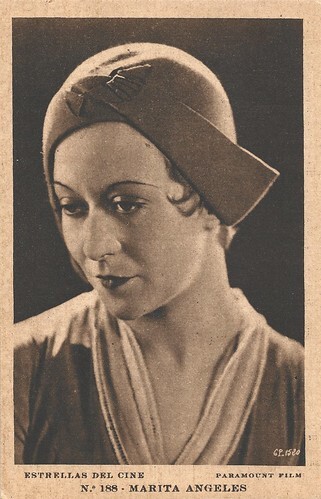
Spanish postcard in the Series Estrellas del cine by Editorial Grafica, Barcelona, no. 188. Photo: Paramount Film.
Marita Ángeles (?-?) had a short film career in 1931-1932 as a supporting actress acting in Spanish language films at the Paramount studios in Joinville. She started with La incorregible (Leo Mettler, 1931) with Tony D'Algy, followed by Las luces de Buenos Aires (Adelqui Migliar, 1931) with Carlos Gardel, and Un caballero de frac (Roger Capellani, Carlos San Martín) starring Roberto Rey - the latter was the Spanish version of Trois hommes en habit. After an uncredited part in La pura verdad (Florián Rey, Manuel Romero, 1931) and a role in the German version, Die nackte Wahrheit (Karl Anton, 1932), she quit film acting.
Source: IMDb.

Spanish postcard in the Series Estrellas del cine by Editorial Grafica, Barcelona, no. 16. Photo: Paramount Film.
Spanish-American film actress and Flamenco dancer Maria Alba (1905-1999) was one of Hollywood's Latin stars. The Fox Film Corporation signed her after she won a Fox Film contest in Spain. She appeared in 25 feature films, starting with Road House (Richard Rosson, 1928) with Lionel Barrymore. Her most notable appearances were probably as 'Saturday' in the Douglas Fairbanks film Mr Robinson Crusoe (A. Edward Sutherland, 1932) and the exotic 'Princess Nadji' in the Bela Lugosi serial The Return of Chandu (Ray Taylor, 1934). Other Latin actresses working in Hollywood, like Lupe Vélez or Dolores del Río, became fluent in English. Still, Maria Alba spoke English with a thick accent, which limited her casting opportunities, and she made her last films in Mexico.

Spanish postcard in the Series Estrellas del cine by Editorial Grafica, Barcelona, no. 26. Photo: Paramount Film.
Spanish artist, theatre director and actor Ernesto Vilches (1879-1954) worked in Spain, Argentina, Mexico and other Latin American countries. He had his own company and was one of the first Spanish actors in Hollywood. He already made his film debut in 1909 in Francisco Oliver's Aventura de Pepín, followed by another outstanding silent Spanish film, El Golfo (José de Togores, 1917). In 1930-1931, he acted in five Spanish-language films at Paramount and MGM in Hollywood. First, he appeared in the Paramount production Cascarrabias (Cyril Gardner, 1930). In the MGM film Su última noche (Carlos F. Borcosque, Chester M. Franklin, 1931), he acted opposite Spanish actors who later became famous in Italian cinema: Conchita Montenegro and Juan de Landa. In Borcosque's Cheri-Bibi (1931), based on Gaston Leroux and the alternate version of The Phantom of Paris (1931), he had the lead as a man who transforms himself into his - dead - rival. After 1931, Vilches' career in Hollywood slowed down. He returned to Spain for El desaparecido (Antonio Graciani, 1934), and co-directed there El cientro trece (1935).

Spanish postcard in the Series Estrellas del cine by Editorial Grafica, Barcelona, no. 31. Photo: Paramount Film.
From 1930 on, Spanish actress Rosita Moreno (1907-1993) starred in Spanish-language versions of Hollywood films. That year, she appeared in the Spanish-language version of Paramount on Parade (1930). Among her best-known films are Piernas de seda / Silk Legs (1935), El día que me quieras / The Day You Love Me (1935) and Tango Bar (1935). In the latter two, her co-star was Carlos Gardel, the legendary songbird of Buenos Aires. She also played supporting parts in English language films such as Her Wedding Night (1930) starring Clara Bow, and Ladies Should Listen (1934) opposite Cary Grant. In Great Britain, she made Stamboul (1931) with Warwick Ward. Moreno appeared in more than 30 films in a career that spanned more than 20 years, often travelling through several countries in quick succession. She played her final role in 1949 in an episode of the TV series The Clock, in which she shared leading roles with George Reeves. Little is known about her after that point.

Spanish postcard in the Series Estrellas del cine by Editorial Grafica, Barcelona, no. 46. Photo: Paramount Film.
Carmen Larrabeiti (1904-1968) was a Spanish stage and screen actress. In 1926, Larrabeiti made her film debut with Currito de la Cruz (Alejandro Pérez Lugín, 1926). After spending time in Paris, she was hired, along with her husband, by the Paramount company to shoot Doña Mentiras / The Lady Lies (1930), Toda una vida / Sarah and Son (1930), La carta / The Letter (1931) and La fiesta del diablo / The Devil's Holiday (1931), all directed by former Latin lover film star Adelqui Migliar. She then moved to Hollywood with her husband. At Fox, she recorded Spanish versions of some of Hollywood's hits for the Spanish-speaking public. She acted in Esclavas de la moda / On Your Back (David Howard, 1931) with Julio Peña, ¿Conoces a tu mujer? / Don't Bet on Women (David Howard, 1931) with Rafael Rivelles, and La ley del harén / Fazil (Lewis Seiler, 1931) with José Mojica. In 1932, Larrabeiti had to return to Spain, suffering from an illness that kept her away from the stage for good.

Spanish postcard in the Series Estrellas del cine by Editorial Grafica, Barcelona, no. 52. Photo: Paramount Film.
María Calvo (1892-1995) was a Spanish-American actress who worked in many Spanish alternate versions of early 1930s Hollywood films. Calvo debuted in 1930 in the Spanish alternate language version of The Benson Murder Case, called Il cuerpo del delitto (1930), shot at the Paramount studios in California. Between 1930 and 1935, she acted mostly in supporting parts in over twenty Spanish-speaking film productions shot in Hollywood. These were often alternate language versions of English spoken films, first at Paramount, but soon also at MGM and Fox. Examples are Sevilla de mis amores (1930), directed and performed by Ramon Novarro, Primavera en otoño (Eugene Forde, 1933), Rosa de Francia (1935), with Rosita Díaz Gimeno, José Peña, and Antonio Moreno, and El cantante de Napoles (Howard Bretherton, Moreno Cuyar, 1935), with Enrico Caruso Jr. In the late 1930s, she moved to Mexico, where, just before and during the war years, she acted in several films by Raphael J. Sevilla and William Rowland, including comedies with Cantinflas. After the war, she remained in Mexico for productions like Fernando Rivero's La morena de mi copla (1946), and Reina de reinas: La Virgen María (Miguel Contreras Torres, 1948) in which she played Elisabeth. After 1948, she only acted in one more film: the Spanish production Pleito de sangre (Ricardo Gascón, 1956). All in all, Calvo acted in over forty films.

Spanish postcard in the Series Estrellas del cine by Editorial Grafica, Barcelona, no. 105. Photo: Paramount Film.
José Crespo Férez (1900-1997) was a Spanish actor who worked in Spain, Hollywood and Mexico. In 1926, he toured several Latin American countries and arrived in the United States in December 1926, where he had a great success in Los Angeles with the play 'El gran Galeoto' by José Echegaray. This attracted the attention of the film studios, and his first American film was Revenge (Edwin Carewe, 1928), starring Dolores Del Rio. He acted in one of the first sound films, the Fox production Joy Street (1929), starring Lois Moran. In May 1930, after a stay in Mexico, Metro-Goldwyn-Mayer offered him a long-term contract. Metro used him to replace John Gilbert in dubbed versions of Gilbert's films for Spanish America. The two actors got to know each other and became good friends. With the disappearance of silent films, he specialised (1930-35) in the dubbed and Spanish versions for United Artists, Fox and Metro-Goldwyn-Mayer. For Fox, he did mostly comedies, and for Metro, dramas. He also appeared in English films, while he spoke he language perfectly. He later acted in New York on CBS radio for the Hispanic market, including the series 'Hollywood por dentro'. When the Spanish dubbing studios were established in New York, he was hired as director. Crespo became the Spanish voice of Joseph Cotten in Paramount films. In 1936, he settled in Mexico and then, after a brief stay in Spain, he returned to the United States (1964) to direct the Spanish Theatre of New York.

Spanish postcard in the Series Estrellas del cine by Editorial Grafica, Barcelona, no. 128. Photo: Paramount Film.
Félix de Pomés (1889-1969) was a Spanish actor, screenwriter and film director as well as a footballer and fencing champion. He acted in 72 films between 1928 and 1967. Félix de Pomés started his career as a film actor in Germany in the late 1920s, debuting as Teddy Bill in the silent film Die große Abenteuerin (Robert Wiene, 1928) starring Lili Damita. Until the end of the silent era, he had major parts in four more German films. When sound set in, De Pomés acted in Spanish language versions at the Paramount studios at Joinville, starting with Doña mentiras (Adelqui Migliar, 1930), the alternate version of The Lady Lies (1929), starring Carmen Larrabeiti. De Pomés had the lead at Paramount in El secreto del doctor (Migliar, 1930), the alternate-language version of The Doctor's Secret (1929). In 1931, he went to Hollywood to act in three Spanish versions of films at Fox, such as Cuerpo y alma (David Howard, 1931) with George Lewis. In 1933, he returned to Spain for a series of ten films produced in Barcelona in seven years.

Spanish postcard in the Series Estrellas del cine by Editorial Grafica, Barcelona, no. 145. Photo: Metro G.M.
Carmen Guerrero (1911-1986) was a Mexican actress who had a successful career in Spanish alternate versions of early Hollywood sound films and afterwards in Mexican cinema of the early 1930s. After a bit part in the Laurel & Hardy comedy Double Whoopee (Lewis R. Foster, Hal Roach, 1929), Guerrero's first substantial part was in a Mexican independent production shot in California: Dios y ley (Guillermo Calles, 1930). This led to performances in a dozen Spanish alternate versions of Hollywood films, including the Spanish version of Dracula: Drácula (George Melford, 1931) in which Guerrero played Lucy/Lucia. She had the female leads in Cascarrabias (Cyril Gardner, 1930) opposite Ernesto Vilches and Barry Norton, Huye-Faldas (James W. Horne, 1931) with Charley Chase, Una cana al aire (Horne, 1931) again with Chase, Un fotógrafo distraído (Xavier Cugat, 1931) with Don Alvarado, and La gran jornada (David Howard, Samuel Schneider, Raoul Walsh, 1931), the Spanish version of The Big Trail. In 1932, Guerrero returned to Mexico as a celebrated movie star and played the female lead in several Mexican films.

Spanish postcard in the Series Estrellas del cine by Editorial Grafica, Barcelona, no. 152.
Tony D'Algy (1897-1977) was a Portuguese film actor who appeared in 57 films between 1924 and 1949. D'Algy acted in various silent Hollywood films. In 1926, D'Algy also directed two films, The Reckless Mollycoddle, scripted by future director Tay Garnett, and the Spanish film Raza de hidalgos, with his sister Helena D'Algy and himself in the leads. In the early 1930s, he acted in Spanish sound versions of American films directed by Adelqui Migliar at the Paris Paramount studios, while he simultaneously also acted in French and Belgian early sound films. In the mid-1930s, he started to act in Spain but then moved to Argentina for several films, returning to Spain in 1940 for more films until 1949.

Spanish postcard in the Series Estrellas del cine by Editorial Grafica, Barcelona, no. 158.
Spanish actor Julio Peña (1912-1972) debuted in a Spanish language film at the Paris Paramount studio, Doña mentiras (Adelqui Migliar), the Spanish version of The Lady Lies, starring Carmen Larrabeiti and Félix de Pomés. He then acted at MGM in California in the Spanish version of Min and Bill, La fruta amarga (Arthur Gregor, José López Rubio, 1931) with Virginia Fábregas and Juan de Landa in the title roles. Peña stayed at MGM for the alternate language versions of Madame X, La mujer X (Carlos F. Borcosque, 1931). He had a first lead opposite Larrabeiti at Fox in Esclavas de la moda (David Howard, Francisco Moré de la Torre, 1931), the Spanish version of On Your Back, and also co-starred in the Fox film Mamá (Benito Perojo, 1931). Peña stayed at Fox for more Spanish language films: Primavera en otoño (Eugene Forde, 1933), Una viuda romántica (Louis King, 1933), Yo, tú y ella (John Reinhardt, 1933), La ciudad de cartón (Louis King, 1933), all starring Catalina Bárcena. Then followed the Fox productions Un capitán de cosacos (John Reinhardt, 1934) with José Mojica and Rosita Moreno, Julieta compra un hijo (Louis King, Gregorio Martínez Sierra, 1934) with Bárcena and Gilbert Roland, Rosa de Francia (José López Rubio, Gordon Wiles, 1935), and Fox's last Spanish language production: Angelina o el honor de un brigadier (Louis King, Miguel de Zárraga, 1935), a comedy starring Enrique de Rosas. After the Universal production Alas sobre El Chaco (Christy Cabanne, 1935), the Spanish version of Storm over the Andes, and four years of acting in alternative versions in California, Peña left Hollywood and returned to Spain to act on stage and on screen.

Spanish postcard in the Series Estrellas del cine by Editorial Grafica, Barcelona, no. 177. Photo: Paramount Film.
Imperio Argentina (1906-2003) was a singer, dancer and actress who appeared in more than 30 films. Although she was born in Buenos Aires, Argentina and was successful all over South America, she was a Spanish citizen. Besides Spain and South America, she also worked in France, Italy and Germany.

Spanish postcard in the Series Estrellas del cine by Editorial Grafica, Barcelona, no. 182. Photo: Paramount Film.
Miguel Ligero Rodríguez (1890-1968) was a Spanish revue, film and zarzuela actor. Ligero made his film debut in 1926, but it was not until the 1930s that he achieved true recognition as a leading screen figure in the Spanish cinema of the time. At the beginning of the decade, he shot at the Paramount studios in Joinville near Paris Spanish language versions of films, such as Doña mentiras (Adelqui Migliar, 1930), the Spanish version of The Lady Lies, starring Carmen Larrabeiti as the lying lady. After five more films at Joinville, Ligero went to the US and acted there in Hollywood versions for Spanish-speaking countries of Fox films, such as Hay que casar al príncipe (Lewis Seiler, 1931), starring José Mojica, and ¿Conoces a tu mujer? (David Howard, 1931) with Larrabeiti again. After two more films in Hollywood, Ligero returned to Spain.

Spanish postcard in the Series Estrellas del cine by Editorial Grafica, Barcelona, no. 188. Photo: Paramount Film.
Marita Ángeles (?-?) had a short film career in 1931-1932 as a supporting actress acting in Spanish language films at the Paramount studios in Joinville. She started with La incorregible (Leo Mettler, 1931) with Tony D'Algy, followed by Las luces de Buenos Aires (Adelqui Migliar, 1931) with Carlos Gardel, and Un caballero de frac (Roger Capellani, Carlos San Martín) starring Roberto Rey - the latter was the Spanish version of Trois hommes en habit. After an uncredited part in La pura verdad (Florián Rey, Manuel Romero, 1931) and a role in the German version, Die nackte Wahrheit (Karl Anton, 1932), she quit film acting.
Source: IMDb.
Published on July 17, 2025 22:00
July 16, 2025
Margitta Scherr
Margitta Scherr (1943-2020) was a German film and television actress who starred in several lightweight romantic comedies and musicals of the 1960s. Between 1969 and 1972, she also appeared in the popular TV series Salto Mortale.
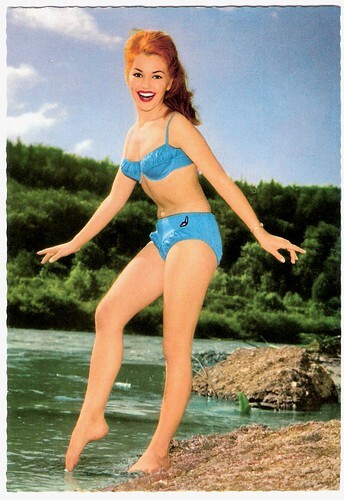
German postcard by ISV, Sort. 18/6. Photo: F. Schneider.
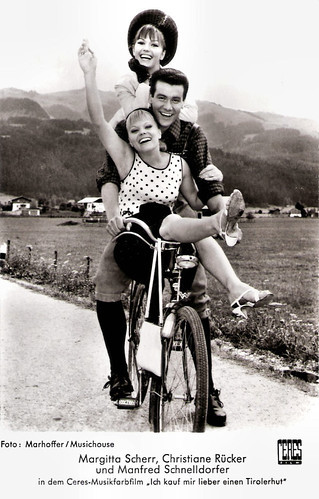
German postcard by Graphima, Berlin. Photo: Marhoffer / Musichouse / Ceres Film. Margitta Scherr, Christiane Rücker and Manfred Schnelldorfer in Ich kauf mir lieber einen Tirolerhut / I'd Rather Buy a Tyrolean Hat (Hans Bilian, 1965).
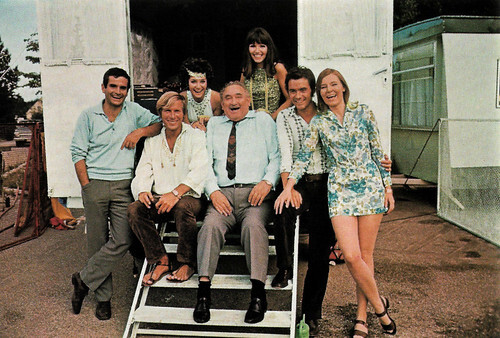
West German collector card by Penny-Bildbände in the Unsere Bambi-Lieblingee series, no. 13. Andreas Blum, Horst Janson , Gitty Djamal, Gustav Knuth , Margitta Scherr, Hans Jürgen Bäumler and Karla Chadimová in Salto Mortale (Michael Braun, 1969). Caption: The TV series Salto Mortale with Gustav Knuth (centre) was so well received by viewers that it was continued.
One of the most astonishing, convincing displays of talent of recent times
Margitta Ina Scherr was born in 1943 in Chemnitz, Germany. When she was seven, her family moved to München (Munich). She got her first small role at the age of twelve in the film Der Meineidbauer / The Perjured Farmer (Rudolf Jugert, 1956) starring Heidemarie Hatheyer .
She also appeared in two comedies, starring Heinz Erhardt, Vater, Mutter und neun Kinder / Father, Mother and Nine Children (Erich Engels, 1958) and Natürlich die Autofahrer / Of Course, the Motorists (Erich Engels, 1958).
The young actress took acting and ballet lessons and continued to appear in front of the camera. Critics noticed her in the television film Frédéric Chopin und George Sand (Arthur Maria Rabenalt, 1960) as the composer's stepdaughter. The Süddeutsche Zeitung wrote: ‘The renowned leading actors were nowhere near as intense as the very young Margitta Scherr, who gave one of the most astonishing, convincing displays of talent of recent times.’
Margitta Scherr showed her talent also on the big screen with her first leading role as Carlos Thompson 's partner in Der Held meiner Träume / The Hero of My Dreams (Arthur Maria Rabenalt, 1960).
She played opposite Helmut Griem and Horst Frank in Fabrik der Offiziere / Operation Terror (Frank Wisbar, 1960), she was Luise Ullrich 's daughter in Frau Irene Besser / Mrs Irene Besser (John Olden, 1961), and she had Maria Schell and O. W. Fischer as her film parents in Das Riesenrad / The Ferris Wheel (Géza von Radványi, 1961).
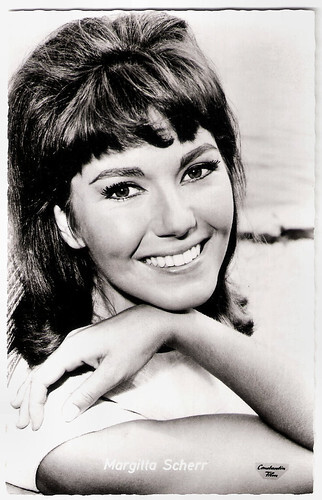
German postcard by Kolibri-Verlag G.m.b.H., Minden / Westf, no. 1642. Photo: Music House / Constantin Film / Stempka. Margitta Scherr in Wenn die Musik spielt am Wörthersee / When the Music Plays on Lake Wörthersee (Hans Grimm, 1962).
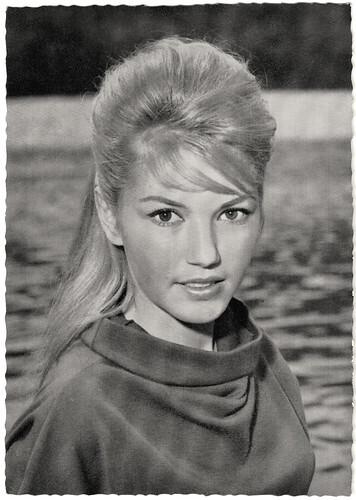
West German postcard by Filmbilder-Vertrieb Ernst Freihoff, Essen, no. 762. Photo: Erwin Schneider.
Fully clothed in Playboy
Margitta Scherr played the title role in the film Operetta Schwarzwaldmädel / The Black Forest Girl (Wilm ten Haaf, 1961). In the same year, Michael Pfleghar directed her for his television show Zu jung um blond zu sein / Too Young to be Blonde (Michael Pfleghar, 1961), which won the Golden Rose of Montreux.
Scherr acted in such light entertainment films as the romantic comedies Die Post geht ab / The Mail Goes Off (Helmuth M. Backhaus, 1962), Holiday in St. Tropez (Ernst Hofbauer, 1964) with Vivi Bach, and Ich kauf mir lieber einen Tirolerhut / I'd Rather Buy a Tyrolean Hat (Hans Billian, 1965) with Manfred Schnelldorfer .
Playboy dedicated a full-page lead photo to Scherr in the cover story ‘The Girls of Germany’ in the November 1964 issue, in which she remained fully clothed. She was the leading lady in the Italian-Spanish-German Eurospy film A 001: operazione Giamaica / Scharfe Schüsse auf Jamaika / Our Man in Jamaica (Ernst Ritter von Theumer, Peter Jacob, 1965) starring Larry Pennell and Brad Harris .
Her last major film role was as Vevi in Das sündige Dorf / The Sinful Village (Werner Jacobs, 1966) with Hans-Jürgen Bäumler . From 1967, Scherr only appeared on television. She had leading roles in Die Glocken von London / The Bells of London (Wilm ten Haaf, 1962), based on Charles Dickens and Boni (Theodor Grädler, 1966) as the Bavarian butcher's daughter Evi, who falls in love with a black man. On stage, she appeared as the title character in the boulevard comedy 'Mary, Mary' in Wuppertal. She also acted in the popular TV series Salto Mortale (1969-1972) with Gustav Knuth . She played the trapeze artist Francis Doria.
After the end of this series, Margitta Scherr ended her career as an actress and retired to private life. She studied foreign languages and then worked for many years as a press officer for international cinema films. She was married to photographer Karl-Heinz Vogelmann from 1962 till their divorce in 1977. They had one son, Alexander Vogelmann. After a long illness, Margitta Scherr died in 2020, surrounded by her family in Munich. She was 77.
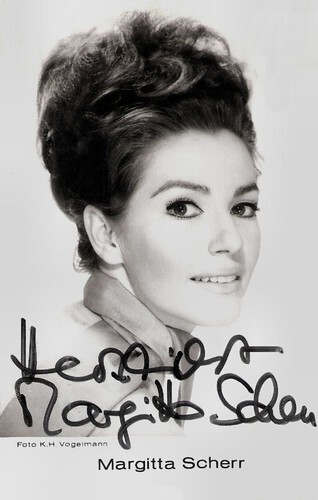
German autograph card. Photo: K.H. Vogelmann.
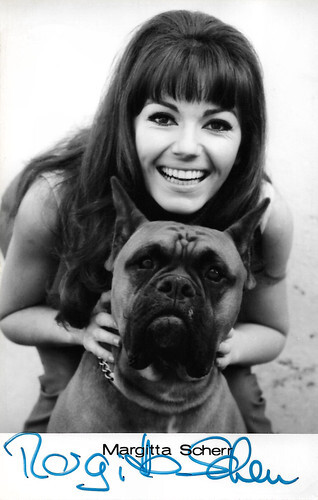
West German autograph card.
Sources: Wikipedia (German and English) and .

German postcard by ISV, Sort. 18/6. Photo: F. Schneider.

German postcard by Graphima, Berlin. Photo: Marhoffer / Musichouse / Ceres Film. Margitta Scherr, Christiane Rücker and Manfred Schnelldorfer in Ich kauf mir lieber einen Tirolerhut / I'd Rather Buy a Tyrolean Hat (Hans Bilian, 1965).

West German collector card by Penny-Bildbände in the Unsere Bambi-Lieblingee series, no. 13. Andreas Blum, Horst Janson , Gitty Djamal, Gustav Knuth , Margitta Scherr, Hans Jürgen Bäumler and Karla Chadimová in Salto Mortale (Michael Braun, 1969). Caption: The TV series Salto Mortale with Gustav Knuth (centre) was so well received by viewers that it was continued.
One of the most astonishing, convincing displays of talent of recent times
Margitta Ina Scherr was born in 1943 in Chemnitz, Germany. When she was seven, her family moved to München (Munich). She got her first small role at the age of twelve in the film Der Meineidbauer / The Perjured Farmer (Rudolf Jugert, 1956) starring Heidemarie Hatheyer .
She also appeared in two comedies, starring Heinz Erhardt, Vater, Mutter und neun Kinder / Father, Mother and Nine Children (Erich Engels, 1958) and Natürlich die Autofahrer / Of Course, the Motorists (Erich Engels, 1958).
The young actress took acting and ballet lessons and continued to appear in front of the camera. Critics noticed her in the television film Frédéric Chopin und George Sand (Arthur Maria Rabenalt, 1960) as the composer's stepdaughter. The Süddeutsche Zeitung wrote: ‘The renowned leading actors were nowhere near as intense as the very young Margitta Scherr, who gave one of the most astonishing, convincing displays of talent of recent times.’
Margitta Scherr showed her talent also on the big screen with her first leading role as Carlos Thompson 's partner in Der Held meiner Träume / The Hero of My Dreams (Arthur Maria Rabenalt, 1960).
She played opposite Helmut Griem and Horst Frank in Fabrik der Offiziere / Operation Terror (Frank Wisbar, 1960), she was Luise Ullrich 's daughter in Frau Irene Besser / Mrs Irene Besser (John Olden, 1961), and she had Maria Schell and O. W. Fischer as her film parents in Das Riesenrad / The Ferris Wheel (Géza von Radványi, 1961).

German postcard by Kolibri-Verlag G.m.b.H., Minden / Westf, no. 1642. Photo: Music House / Constantin Film / Stempka. Margitta Scherr in Wenn die Musik spielt am Wörthersee / When the Music Plays on Lake Wörthersee (Hans Grimm, 1962).

West German postcard by Filmbilder-Vertrieb Ernst Freihoff, Essen, no. 762. Photo: Erwin Schneider.
Fully clothed in Playboy
Margitta Scherr played the title role in the film Operetta Schwarzwaldmädel / The Black Forest Girl (Wilm ten Haaf, 1961). In the same year, Michael Pfleghar directed her for his television show Zu jung um blond zu sein / Too Young to be Blonde (Michael Pfleghar, 1961), which won the Golden Rose of Montreux.
Scherr acted in such light entertainment films as the romantic comedies Die Post geht ab / The Mail Goes Off (Helmuth M. Backhaus, 1962), Holiday in St. Tropez (Ernst Hofbauer, 1964) with Vivi Bach, and Ich kauf mir lieber einen Tirolerhut / I'd Rather Buy a Tyrolean Hat (Hans Billian, 1965) with Manfred Schnelldorfer .
Playboy dedicated a full-page lead photo to Scherr in the cover story ‘The Girls of Germany’ in the November 1964 issue, in which she remained fully clothed. She was the leading lady in the Italian-Spanish-German Eurospy film A 001: operazione Giamaica / Scharfe Schüsse auf Jamaika / Our Man in Jamaica (Ernst Ritter von Theumer, Peter Jacob, 1965) starring Larry Pennell and Brad Harris .
Her last major film role was as Vevi in Das sündige Dorf / The Sinful Village (Werner Jacobs, 1966) with Hans-Jürgen Bäumler . From 1967, Scherr only appeared on television. She had leading roles in Die Glocken von London / The Bells of London (Wilm ten Haaf, 1962), based on Charles Dickens and Boni (Theodor Grädler, 1966) as the Bavarian butcher's daughter Evi, who falls in love with a black man. On stage, she appeared as the title character in the boulevard comedy 'Mary, Mary' in Wuppertal. She also acted in the popular TV series Salto Mortale (1969-1972) with Gustav Knuth . She played the trapeze artist Francis Doria.
After the end of this series, Margitta Scherr ended her career as an actress and retired to private life. She studied foreign languages and then worked for many years as a press officer for international cinema films. She was married to photographer Karl-Heinz Vogelmann from 1962 till their divorce in 1977. They had one son, Alexander Vogelmann. After a long illness, Margitta Scherr died in 2020, surrounded by her family in Munich. She was 77.

German autograph card. Photo: K.H. Vogelmann.

West German autograph card.
Sources: Wikipedia (German and English) and .
Published on July 16, 2025 22:00
July 15, 2025
15 postcards from GDI: More postcards from the estates of Tjitte de Vries and Ati Mul (2)
Today, the last GDI post on the big blue album from the estate of film historians Tjitte de Vries and Ati Mul. The album includes mostly Dutch postcards from the 1920s to the 1950s. So in this final post, you can find Hollywood stars of the 1940s and 1950s, including Elvis, who was very popular in the Netherlands. Next month, we will discover a new album full of vintage postcards from the collection of the Geoffrey Donaldson Institute.
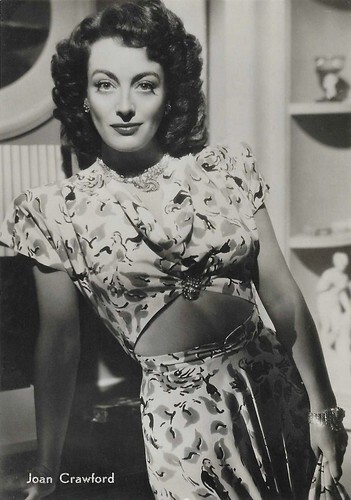
Dutch postcard by PEB.
American film star Joan Crawford (1904-1977) had a career that spanned many decades, studios, and controversies. In her silent films, she made an impact as a vivacious Jazz Age flapper, and later she matured into a star of psychological melodramas.
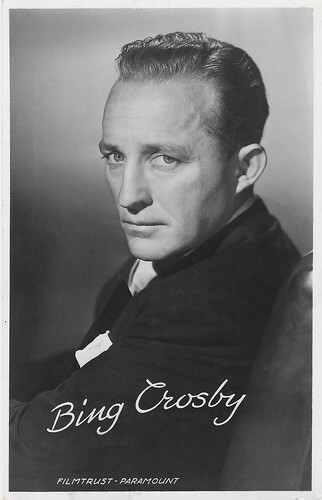
Dutch postcard by Takken / 't Sticht, no. 3177. Photo: Filmtrust - Paramount.
American singer Bing Crosby (1903-1977) was a crooner whose signature song was 'White Christmas'. He often played 'happy-go-lucky fellas' in films which included the 'Road to...' comedies from 1940 to 1962, but he proved that he could act with The Country Girl (1954) opposite Grace Kelly. Crosby was a multi-media entertainer: a star on the radio and in the cinema, with chart-topping recordings. He had 38 no. 1 singles, which surpassed Elvis Presley and The Beatles.
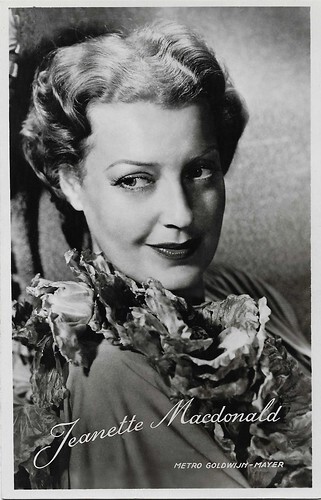
Dutch postcard by 't Sticht, no. 3017. Photo: Metro Goldwyn Mayer.
Red-headed and blue-green-eyed operatic singer Jeanette MacDonald (1903-1965) was discovered for the cinema by Ernst Lubitsch, who cast her opposite Maurice Chevalier in The Love Parade (1929). Later, the 'Iron Butterfly' co-starred with Nelson Eddy in a string of successful musicals and played opposite Clark Gable in San Francisco (1936).
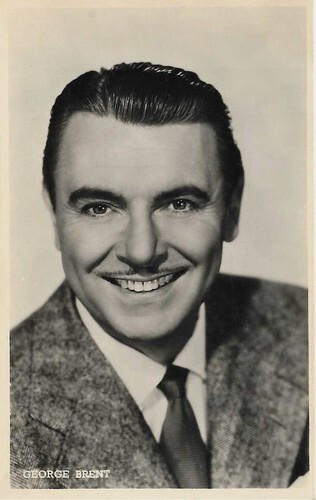
Dutch postcard by J.S.A. Photo: Universal / M.P.E.
George Brent (1904-1979) was an Irish-born actor who was mainly active in American cinema in the 1930s and 1940s. He was the favourite leading man of Bette Davis and they were onscreen paired eleven times in such classics as Jezebel (1938) and Dark Victory (1939).
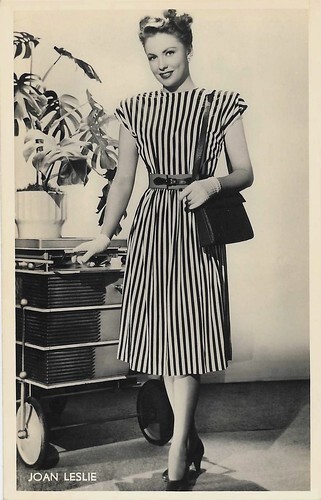
Dutch postcard by P.F. Cladder, Amsterdam, no. 49-51. Photo: Warner Bros.
American actress Joan Leslie (1925-2015) starred in over 30 films. Her breakout role came at the age of 15, when she appeared as the crippled girl Velma in High Sierra (1941) with Humphrey Bogart. In the following years, she starred alongside Gary Cooper in Sergeant York (1941) and James Cagney in Yankee Doodle Dandy (1942). After 1956, she appeared in some television series.
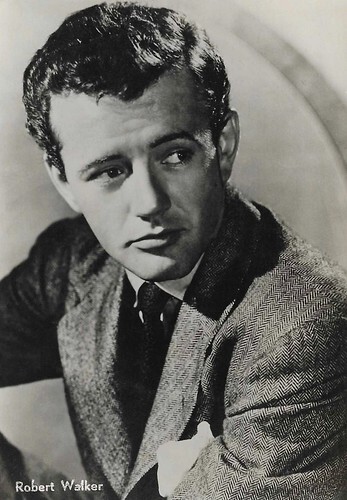
Dutch postcard by PEB.
Between 1939 and 1951, American actor Robert Walker (1918-1951) played in about twenty films. He starred in Alfred Hitchcock's psychological thriller Strangers on a Train (1949) as the madman who proposes a perfect murder in exchange.
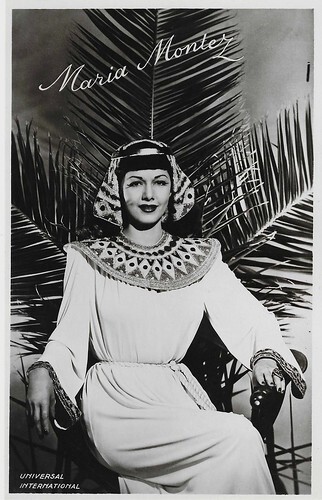
Dutch postcard by 't Sticht, no. 3023. Photo: Universal- International. Maria Montez in Sudan (John Rawlins, 1945).
Dominican film actress María Montez (1912-1951) gained fame and popularity as a tempestuous Latina beauty in Hollywood movies of the 1940s. In a series of exotic adventures filmed in Technicolor, she starred as Arabian princesses, jungle goddesses, and highborn gypsies, dressed in fanciful costumes and sparkling jewels. Over her career, ‘The Queen of Technicolor’ appeared in 26 films, of which five were made in Europe.
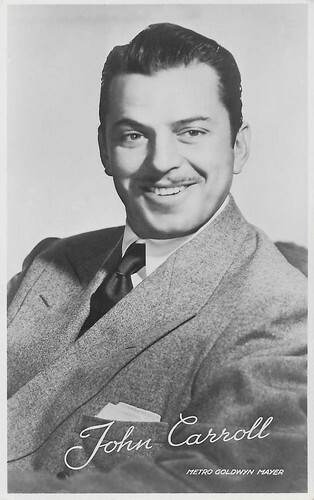
Dutch postcard by 't Sticht, no. 3095. Photo: Metro Goldwyn Mayer.
Dark-haired and tall John Carroll (1906-1979) was an American actor and singer. Combining a good singing voice and dashing looks, Carroll appeared in over 50 films during his 24-year career. He reached his peak in the 1940s when MGM gave him leading roles in second-rate Westerns and musicals. Incidentally, he worked with famous directors like Howard Hawks, George Cukor and Orson Welles. He was married briefly to exotic leading lady Steffi Duna, and later to one of the first female Hollywood studio executives, Lucille Ryman.
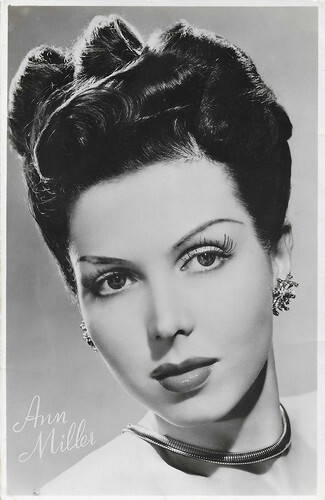
Dutch postcard. Photo: Metro-Goldwyn-Mayer.
Ann Miller (1923-2004) was an American dancer, singer and actress. She was famed for her speed in tap dancing and her style of glamour: massive black bouffant hair, heavy makeup with a splash of crimson lipstick, and fashions that emphasised her lithe figure and long dancer's legs. Miller is best remembered for her work in the classic Hollywood musicals Easter Parade (1948), On the Town (1949) and Kiss Me Kate (1953).
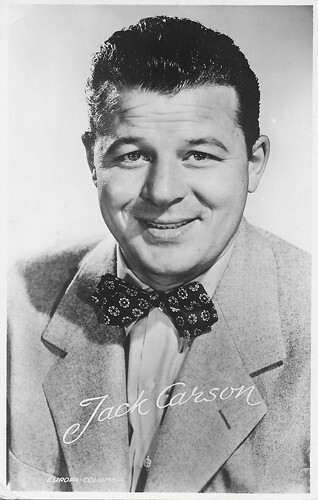
Dutch postcard by Takken / 't Sticht, no. 3332. Photo: Europa / Columbia.
Jack Carson (1910-1953) was a tall and beefy character actor who specialised in friendly but frequently untrustworthy types in Hollywood films of the 1930s and 1940s. He would take the double-take and the quizzical look to a higher level.
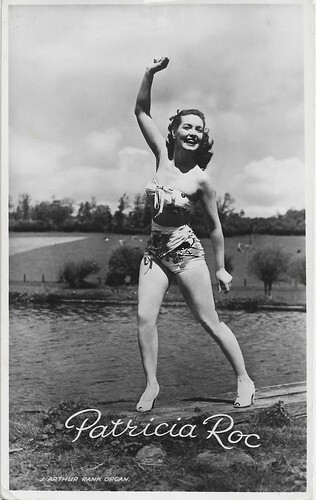
Dutch postcard by Foto archief Film en Toneel, no. 3240. Photo: J. Arthur Rank Organ.
Fresh-faced Patricia Roc (1915-2003) was, between 1943 and 1953, one of Britain's top 10 box office stars. The elegant, well-spoken actress seemed the epitome of the English rose. She had international success in such Gainsborough costume dramas as Madonna of the Seven Moons (1945) and The Wicked Lady (1945), and in When the Bough Breaks (1947), in which she played an unmarried mother.
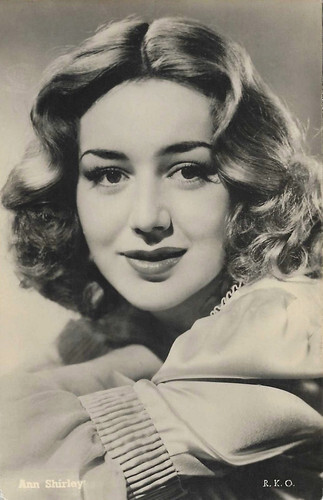
Dutch postcard by MPEA. Photo: RKO.
American actress Anne Shirley (1918-1993) began her career as a child actress, Dawn O'Day, and was the original Alice in Disney's silent animated series Alice in Cartoonland. She became known as Anne Shirley with Anne of Green Gables (1934). For her supporting role in Stella Dallas (1937), she received an Oscar nomination.
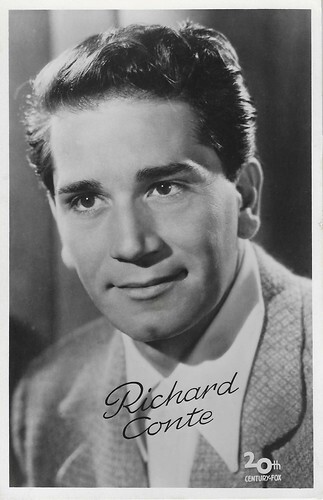
Dutch postcard by Takken / 't Sticht, no. 3138. Photo: 20th Century Fox.
Richard Conte (1910-1975) was an American actor who often appeared in Film Noirs and crime dramas of the late 1940s and early 1950s. Two decades later, he returned to the screen as gangster boss Don Barzini in The Godfather (1972).
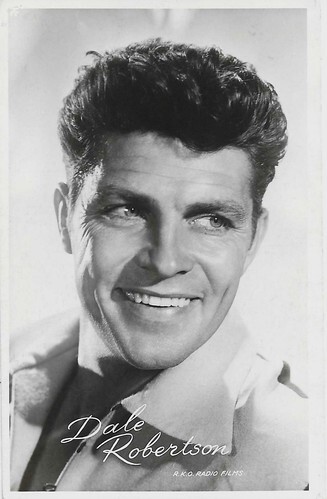
Dutch postcard by Takken / 't Sticht, no. 1567. Photo: RKO Radio Films.
American actor Dale Robertson (1923-2013) was best known for his starring roles on television. He played the roving investigator Jim Hardie in the television series Tales of Wells Fargo and railroad owner Ben Calhoun in Iron Horse. He was often presented as a deceptively thoughtful but modest Western hero. Robertson played in over 60 Western films and television shows.
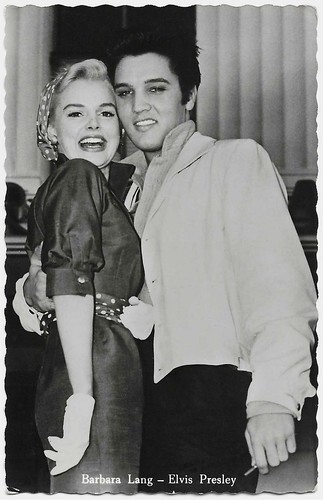
West German postcard by Kolibri-Verlag, Minden/Westf., no. 789. Barbara Lang and Elvis Presley .
Beautiful, brassy Barbara Lang (1928–1982) was an American actress and singer. During the 1950s, she was one of the many B-level blondes in Hollywood who were promoted as the new Marilyn Monroe. However, Lang appeared in only three films.
When The Beatles came to America in 1965, there was only one person they wanted to meet: Elvis Presley (1935-1977). Elvis had more multi-platinum album sales than any other performer, with twelve albums selling over 2 million copies.
All postcards: Collection Geoffrey Donaldson Institute (GDI). Our thanks to Egbert Barten.

Dutch postcard by PEB.
American film star Joan Crawford (1904-1977) had a career that spanned many decades, studios, and controversies. In her silent films, she made an impact as a vivacious Jazz Age flapper, and later she matured into a star of psychological melodramas.

Dutch postcard by Takken / 't Sticht, no. 3177. Photo: Filmtrust - Paramount.
American singer Bing Crosby (1903-1977) was a crooner whose signature song was 'White Christmas'. He often played 'happy-go-lucky fellas' in films which included the 'Road to...' comedies from 1940 to 1962, but he proved that he could act with The Country Girl (1954) opposite Grace Kelly. Crosby was a multi-media entertainer: a star on the radio and in the cinema, with chart-topping recordings. He had 38 no. 1 singles, which surpassed Elvis Presley and The Beatles.

Dutch postcard by 't Sticht, no. 3017. Photo: Metro Goldwyn Mayer.
Red-headed and blue-green-eyed operatic singer Jeanette MacDonald (1903-1965) was discovered for the cinema by Ernst Lubitsch, who cast her opposite Maurice Chevalier in The Love Parade (1929). Later, the 'Iron Butterfly' co-starred with Nelson Eddy in a string of successful musicals and played opposite Clark Gable in San Francisco (1936).

Dutch postcard by J.S.A. Photo: Universal / M.P.E.
George Brent (1904-1979) was an Irish-born actor who was mainly active in American cinema in the 1930s and 1940s. He was the favourite leading man of Bette Davis and they were onscreen paired eleven times in such classics as Jezebel (1938) and Dark Victory (1939).

Dutch postcard by P.F. Cladder, Amsterdam, no. 49-51. Photo: Warner Bros.
American actress Joan Leslie (1925-2015) starred in over 30 films. Her breakout role came at the age of 15, when she appeared as the crippled girl Velma in High Sierra (1941) with Humphrey Bogart. In the following years, she starred alongside Gary Cooper in Sergeant York (1941) and James Cagney in Yankee Doodle Dandy (1942). After 1956, she appeared in some television series.

Dutch postcard by PEB.
Between 1939 and 1951, American actor Robert Walker (1918-1951) played in about twenty films. He starred in Alfred Hitchcock's psychological thriller Strangers on a Train (1949) as the madman who proposes a perfect murder in exchange.

Dutch postcard by 't Sticht, no. 3023. Photo: Universal- International. Maria Montez in Sudan (John Rawlins, 1945).
Dominican film actress María Montez (1912-1951) gained fame and popularity as a tempestuous Latina beauty in Hollywood movies of the 1940s. In a series of exotic adventures filmed in Technicolor, she starred as Arabian princesses, jungle goddesses, and highborn gypsies, dressed in fanciful costumes and sparkling jewels. Over her career, ‘The Queen of Technicolor’ appeared in 26 films, of which five were made in Europe.

Dutch postcard by 't Sticht, no. 3095. Photo: Metro Goldwyn Mayer.
Dark-haired and tall John Carroll (1906-1979) was an American actor and singer. Combining a good singing voice and dashing looks, Carroll appeared in over 50 films during his 24-year career. He reached his peak in the 1940s when MGM gave him leading roles in second-rate Westerns and musicals. Incidentally, he worked with famous directors like Howard Hawks, George Cukor and Orson Welles. He was married briefly to exotic leading lady Steffi Duna, and later to one of the first female Hollywood studio executives, Lucille Ryman.

Dutch postcard. Photo: Metro-Goldwyn-Mayer.
Ann Miller (1923-2004) was an American dancer, singer and actress. She was famed for her speed in tap dancing and her style of glamour: massive black bouffant hair, heavy makeup with a splash of crimson lipstick, and fashions that emphasised her lithe figure and long dancer's legs. Miller is best remembered for her work in the classic Hollywood musicals Easter Parade (1948), On the Town (1949) and Kiss Me Kate (1953).

Dutch postcard by Takken / 't Sticht, no. 3332. Photo: Europa / Columbia.
Jack Carson (1910-1953) was a tall and beefy character actor who specialised in friendly but frequently untrustworthy types in Hollywood films of the 1930s and 1940s. He would take the double-take and the quizzical look to a higher level.

Dutch postcard by Foto archief Film en Toneel, no. 3240. Photo: J. Arthur Rank Organ.
Fresh-faced Patricia Roc (1915-2003) was, between 1943 and 1953, one of Britain's top 10 box office stars. The elegant, well-spoken actress seemed the epitome of the English rose. She had international success in such Gainsborough costume dramas as Madonna of the Seven Moons (1945) and The Wicked Lady (1945), and in When the Bough Breaks (1947), in which she played an unmarried mother.

Dutch postcard by MPEA. Photo: RKO.
American actress Anne Shirley (1918-1993) began her career as a child actress, Dawn O'Day, and was the original Alice in Disney's silent animated series Alice in Cartoonland. She became known as Anne Shirley with Anne of Green Gables (1934). For her supporting role in Stella Dallas (1937), she received an Oscar nomination.

Dutch postcard by Takken / 't Sticht, no. 3138. Photo: 20th Century Fox.
Richard Conte (1910-1975) was an American actor who often appeared in Film Noirs and crime dramas of the late 1940s and early 1950s. Two decades later, he returned to the screen as gangster boss Don Barzini in The Godfather (1972).

Dutch postcard by Takken / 't Sticht, no. 1567. Photo: RKO Radio Films.
American actor Dale Robertson (1923-2013) was best known for his starring roles on television. He played the roving investigator Jim Hardie in the television series Tales of Wells Fargo and railroad owner Ben Calhoun in Iron Horse. He was often presented as a deceptively thoughtful but modest Western hero. Robertson played in over 60 Western films and television shows.

West German postcard by Kolibri-Verlag, Minden/Westf., no. 789. Barbara Lang and Elvis Presley .
Beautiful, brassy Barbara Lang (1928–1982) was an American actress and singer. During the 1950s, she was one of the many B-level blondes in Hollywood who were promoted as the new Marilyn Monroe. However, Lang appeared in only three films.
When The Beatles came to America in 1965, there was only one person they wanted to meet: Elvis Presley (1935-1977). Elvis had more multi-platinum album sales than any other performer, with twelve albums selling over 2 million copies.
All postcards: Collection Geoffrey Donaldson Institute (GDI). Our thanks to Egbert Barten.
Published on July 15, 2025 22:00
July 14, 2025
15 postcards from GDI: More postcards from the estates of Tjitte de Vries and Ati Mul (1)
In our monthly post on the postcard collection of Geoffrey Donaldson Institute (GDI), we chose again 15 postcards from a big album from the estate of film historians Tjitte de Vries and Ati Mul. The blue album, which they probably started somewhere in the 1970s, contains so many interesting postcards that we planned an extra post tomorrow. Today, we focus on Dutch post-war postcards of Hollywood stars. The publishers were such firms as J. Sleeding in Amsterdam (J.S.A.) and Takken in Utrecht.
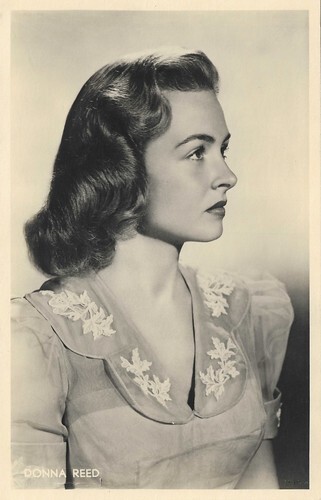
Dutch postcard by S. & v. H., A. Photo: M.P.E.A.
Donna Reed (1921-1986) was an American film and television actress and producer. Her career spanned more than 40 years, with performances in more than 40 films. She is well known for her role as Mary Hatch Bailey in It's a Wonderful Life (Frank Capra, 1946). She received the Oscar for Best Supporting Actress for her role as Lorene Burke in the war drama From Here to Eternity (Fred Zinnemann, 1953). Reed is also known as Donna Stone, a middle-class American mother and housewife in the sitcom The Donna Reed Show (1958–1966).
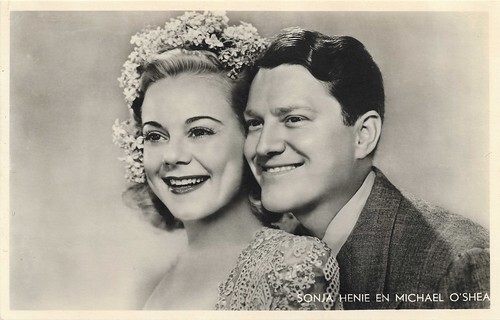
Dutch postcard by S. & v. H., A. Photo: M.P.E.A. Sonja Henie and Michael O'Shea in It's a Pleasure (William A. Seiter, 1945).
Petite and glamorous Sonja Henie (1912-1969) was one of the greatest figure skaters in history, the ‘Pavlova of the ice’. She won more Olympic and World titles than any other ladies' figure skater. At the height of her acting career, the Norwegian figure skater and film star was one of the highest-paid stars in Hollywood. She had a shrewd business sense and was immensely successful next with a series of ice revues.
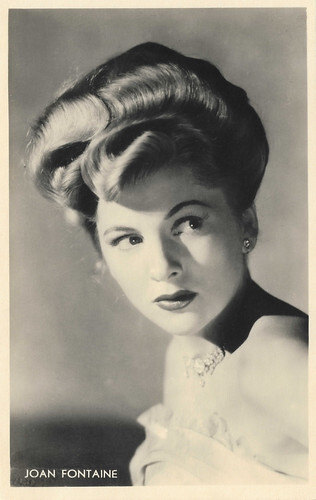
Dutch postcard by S. & v. H., A. Photo: M.P.E.A.
American actress Joan Fontaine (1917-2013) was the younger sister of Hollywood star Olivia de Havilland, but Joan made a name for herself with two classics by Alfred Hitchcock, Rebecca (1941) and Suspicion (1942). For the first film, she was nominated for the Oscar, and for the second film, she won the award.
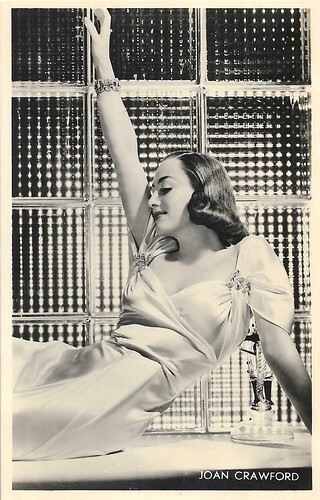
Dutch postcard by J.S.A. Photo: M.G.M. / M.P.E.
American film star Joan Crawford (1904-1977) had a career that spanned many decades, studios, and controversies. In her silent films, she made an impact as a vivacious Jazz Age flapper, and later she matured into a star of psychological melodramas.
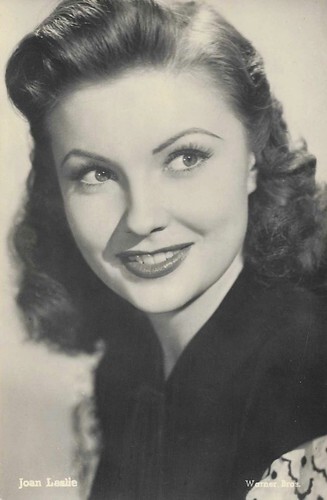
Dutch postcard/ Photo: MPEA / Warner Bros.
American actress Joan Leslie (1925-2015) starred in over 30 films. Her breakout role came at the age of 15, when she appeared as the crippled girl Velma in High Sierra (1941) with Humphrey Bogart. In the following years, she starred alongside Gary Cooper in Sergeant York (1941) and James Cagney in Yankee Doodle Dandy (1942). After 1956, she appeared in several television series.
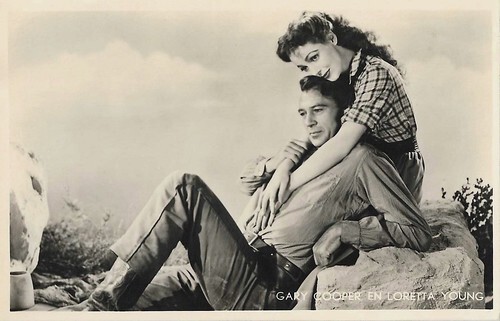
Dutch postcard by S. & v. H., A. Photo: M.P.E.A. Gary Cooper and Loretta Young in Along Came Jones (Stuart Heisler, 1945).
American screen legend Gary Cooper (1901-1961) is well remembered for his stoic, understated acting style in more than one hundred Westerns, comedies and dramas. He received five Oscar nominations and won twice for his roles as Alvin York in Sergeant York (1941) and as Will Kane in High Noon (1952).
Loretta Young (1913-2000) was probably one of the loveliest female stars from the golden age of Hollywood, with her beautiful eyes, high cheekbones, full lips and radiant smile. She was also regarded as one of the most elegant actresses of her time. Young had a long career at the top. She began to get leading roles at the end of the 1920s and was still given starring parts at the beginning of the 1950s. Afterwards, she was able to extend her success for several years by wisely turning to television.
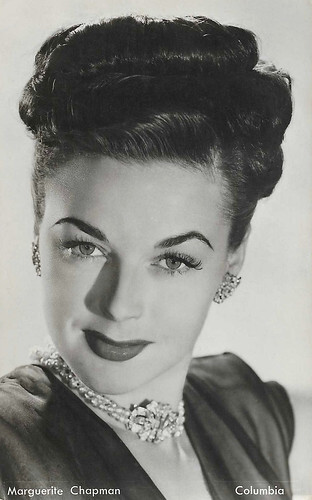
Dutch postcard by DRC, no. 31. Photo: MPEA.
American actress Marguerite Chapman (1918-1999) began her career as a model. In 1940, she moved to Hollywood and appeared in film and television till 1977.
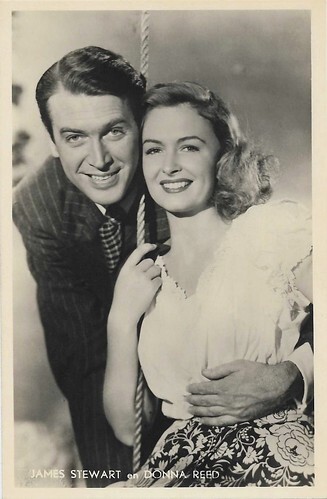
Dutch postcard by S. & v. H., A. Photo: M.P.E.A. James Stewart and Donna Reed in It's a Wonderful Life (Frank Capra, 1946).
American actor James Stewart (1908-1997) is among the most honoured and popular stars in film history. Known for his distinctive drawl and everyman screen persona, Stewart had a film career that spanned over 55 years and 80 films.
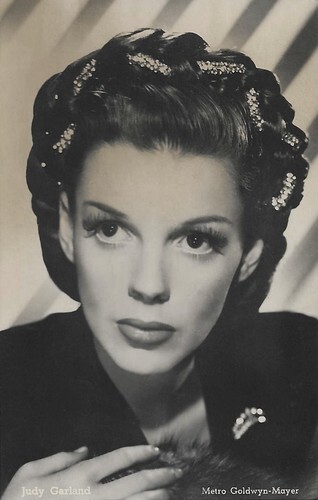
Dutch postcard by MPEA. Photo: Metro Goldwyn Mayer.
Judy Garland (1922-1969) was an American singer, actress, and vaudevillian. During a career that spanned 45 of her 47 years, Garland attained international stardom as an actress in musical and dramatic roles, as a recording artist, and on the concert stage. She was nominated for the Oscar for Best Actress for A Star is Born (1954) and received a nomination for Best Supporting Actress for Judgment at Nuremberg (1961).
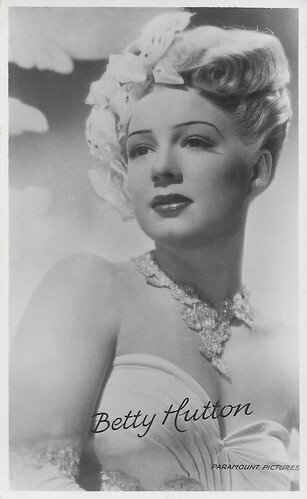
Dutch postcard by Takken, no. 3132. Photo: Paramount Pictures.
American actress Betty Hutton (1921-2007) was an energetic, 'blonde bombshell' of the 1940s. She appeared in successful musicals and comedies, including The Miracle of Morgan's Creek (1943), Red, Hot and Blue (1949), Annie Get Your Gun (1950), and The Greatest Show on Earth (1952).
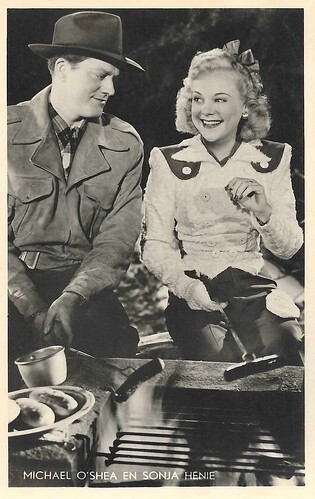
Dutch postcard by S. & v. H., A. Photo: M.P.E.A. Sonja Henie and Michael O'Shea in It's a Pleasure (William A. Seiter, 1945).
Michael O'Shea (1906-1973) was an American actor who appeared on the stage, in feature films, and on television in a career that spanned the 1940s and early 1970s. He was also a comedian, musician, and band leader, and performed on the radio.
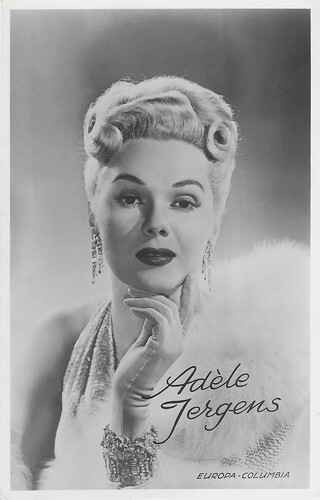
Dutch postcard by Takken, no. 3180 Photo: Europa-Columbia.
Glamorous Adele Jergens (1917-2002) was an American film actress of the 1940s and 1950s who was often cast in B-films as blonde floozies and burlesque dancers.

Dutch postcard by J.S.A. Photo: W.B. & V.P. / M.P.E.
Japanese-born British-American actress Olivia de Havilland (1916-2020) had a career from 1935 to 1988. She appeared in 49 feature films and was one of the leading stars during the golden age of Classical Hollywood. She is best known for her early screen performances in The Adventures of Robin Hood (1938) and Gone with the Wind (1939), and her later award-winning performances in To Each His Own (1946), The Snake Pit (1948), and The Heiress (1949).
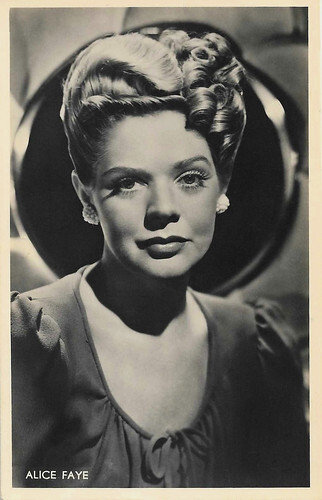
Dutch postcard by P.F. Cladder, Amsterdam, no. 49-47. Photo: 20th Century Fox.
Famous composer Irving Berlin would allegedly have said once, "I’d rather have Alice Faye introduce my songs than anyone else". Henry King, who directed her in three films, stated: "Alice Faye always took direction beautifully without any show of temperament, and when you were done, the character she played came across with a vibrant warmth of personality so many actresses did not possess. I think that was the secret of Alice’s success in pictures. A deep-seated human warmth, so genuine, so real that everybody felt it. It’s truly a gift; you can’t buy it. It’s either there or it isn’t." In the second half of the 1930s and the first half of the 1940s, Alice Faye was a name to reckon with in the world of Hollywood musicals. Her compelling voice, her remarkable ability to put over a song and her endearing screen persona made her a top star. In the U.S. Quigley’s Motion Picture Exhibitors’ Poll, which was the barometer of the stars’ box-office power, she placed 9th in 1938, 7th in 1939, 13th in 1940, 12th in 1941 and 1943 and 15th in 1944 (in 1942, she had been away from the screen).
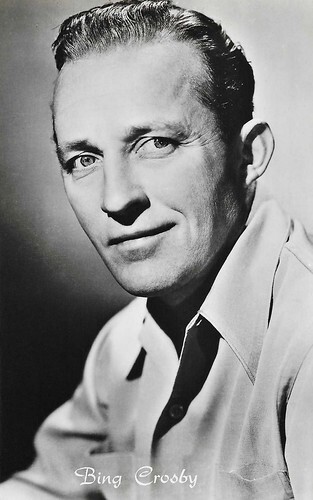
Dutch postcard by Korès. Photo: Paramount.
American singer Bing Crosby (1903-1977) was a crooner whose signature song was 'White Christmas'. He often played 'happy-go-lucky fellas' in films which included the 'Road to...' comedies from 1940 to 1962, but he proved that he could act with The Country Girl (1954) opposite Grace Kelly. Crosby was a multi-media entertainer: a star on the radio and in the cinema, with chart-topping recordings. He had 38 no. 1 singles, which surpassed Elvis Presley and The Beatles.
All postcards: Collection Geoffrey Donaldson Institute. To be continued tomorrow.

Dutch postcard by S. & v. H., A. Photo: M.P.E.A.
Donna Reed (1921-1986) was an American film and television actress and producer. Her career spanned more than 40 years, with performances in more than 40 films. She is well known for her role as Mary Hatch Bailey in It's a Wonderful Life (Frank Capra, 1946). She received the Oscar for Best Supporting Actress for her role as Lorene Burke in the war drama From Here to Eternity (Fred Zinnemann, 1953). Reed is also known as Donna Stone, a middle-class American mother and housewife in the sitcom The Donna Reed Show (1958–1966).

Dutch postcard by S. & v. H., A. Photo: M.P.E.A. Sonja Henie and Michael O'Shea in It's a Pleasure (William A. Seiter, 1945).
Petite and glamorous Sonja Henie (1912-1969) was one of the greatest figure skaters in history, the ‘Pavlova of the ice’. She won more Olympic and World titles than any other ladies' figure skater. At the height of her acting career, the Norwegian figure skater and film star was one of the highest-paid stars in Hollywood. She had a shrewd business sense and was immensely successful next with a series of ice revues.

Dutch postcard by S. & v. H., A. Photo: M.P.E.A.
American actress Joan Fontaine (1917-2013) was the younger sister of Hollywood star Olivia de Havilland, but Joan made a name for herself with two classics by Alfred Hitchcock, Rebecca (1941) and Suspicion (1942). For the first film, she was nominated for the Oscar, and for the second film, she won the award.

Dutch postcard by J.S.A. Photo: M.G.M. / M.P.E.
American film star Joan Crawford (1904-1977) had a career that spanned many decades, studios, and controversies. In her silent films, she made an impact as a vivacious Jazz Age flapper, and later she matured into a star of psychological melodramas.

Dutch postcard/ Photo: MPEA / Warner Bros.
American actress Joan Leslie (1925-2015) starred in over 30 films. Her breakout role came at the age of 15, when she appeared as the crippled girl Velma in High Sierra (1941) with Humphrey Bogart. In the following years, she starred alongside Gary Cooper in Sergeant York (1941) and James Cagney in Yankee Doodle Dandy (1942). After 1956, she appeared in several television series.

Dutch postcard by S. & v. H., A. Photo: M.P.E.A. Gary Cooper and Loretta Young in Along Came Jones (Stuart Heisler, 1945).
American screen legend Gary Cooper (1901-1961) is well remembered for his stoic, understated acting style in more than one hundred Westerns, comedies and dramas. He received five Oscar nominations and won twice for his roles as Alvin York in Sergeant York (1941) and as Will Kane in High Noon (1952).
Loretta Young (1913-2000) was probably one of the loveliest female stars from the golden age of Hollywood, with her beautiful eyes, high cheekbones, full lips and radiant smile. She was also regarded as one of the most elegant actresses of her time. Young had a long career at the top. She began to get leading roles at the end of the 1920s and was still given starring parts at the beginning of the 1950s. Afterwards, she was able to extend her success for several years by wisely turning to television.

Dutch postcard by DRC, no. 31. Photo: MPEA.
American actress Marguerite Chapman (1918-1999) began her career as a model. In 1940, she moved to Hollywood and appeared in film and television till 1977.

Dutch postcard by S. & v. H., A. Photo: M.P.E.A. James Stewart and Donna Reed in It's a Wonderful Life (Frank Capra, 1946).
American actor James Stewart (1908-1997) is among the most honoured and popular stars in film history. Known for his distinctive drawl and everyman screen persona, Stewart had a film career that spanned over 55 years and 80 films.

Dutch postcard by MPEA. Photo: Metro Goldwyn Mayer.
Judy Garland (1922-1969) was an American singer, actress, and vaudevillian. During a career that spanned 45 of her 47 years, Garland attained international stardom as an actress in musical and dramatic roles, as a recording artist, and on the concert stage. She was nominated for the Oscar for Best Actress for A Star is Born (1954) and received a nomination for Best Supporting Actress for Judgment at Nuremberg (1961).

Dutch postcard by Takken, no. 3132. Photo: Paramount Pictures.
American actress Betty Hutton (1921-2007) was an energetic, 'blonde bombshell' of the 1940s. She appeared in successful musicals and comedies, including The Miracle of Morgan's Creek (1943), Red, Hot and Blue (1949), Annie Get Your Gun (1950), and The Greatest Show on Earth (1952).

Dutch postcard by S. & v. H., A. Photo: M.P.E.A. Sonja Henie and Michael O'Shea in It's a Pleasure (William A. Seiter, 1945).
Michael O'Shea (1906-1973) was an American actor who appeared on the stage, in feature films, and on television in a career that spanned the 1940s and early 1970s. He was also a comedian, musician, and band leader, and performed on the radio.

Dutch postcard by Takken, no. 3180 Photo: Europa-Columbia.
Glamorous Adele Jergens (1917-2002) was an American film actress of the 1940s and 1950s who was often cast in B-films as blonde floozies and burlesque dancers.

Dutch postcard by J.S.A. Photo: W.B. & V.P. / M.P.E.
Japanese-born British-American actress Olivia de Havilland (1916-2020) had a career from 1935 to 1988. She appeared in 49 feature films and was one of the leading stars during the golden age of Classical Hollywood. She is best known for her early screen performances in The Adventures of Robin Hood (1938) and Gone with the Wind (1939), and her later award-winning performances in To Each His Own (1946), The Snake Pit (1948), and The Heiress (1949).

Dutch postcard by P.F. Cladder, Amsterdam, no. 49-47. Photo: 20th Century Fox.
Famous composer Irving Berlin would allegedly have said once, "I’d rather have Alice Faye introduce my songs than anyone else". Henry King, who directed her in three films, stated: "Alice Faye always took direction beautifully without any show of temperament, and when you were done, the character she played came across with a vibrant warmth of personality so many actresses did not possess. I think that was the secret of Alice’s success in pictures. A deep-seated human warmth, so genuine, so real that everybody felt it. It’s truly a gift; you can’t buy it. It’s either there or it isn’t." In the second half of the 1930s and the first half of the 1940s, Alice Faye was a name to reckon with in the world of Hollywood musicals. Her compelling voice, her remarkable ability to put over a song and her endearing screen persona made her a top star. In the U.S. Quigley’s Motion Picture Exhibitors’ Poll, which was the barometer of the stars’ box-office power, she placed 9th in 1938, 7th in 1939, 13th in 1940, 12th in 1941 and 1943 and 15th in 1944 (in 1942, she had been away from the screen).

Dutch postcard by Korès. Photo: Paramount.
American singer Bing Crosby (1903-1977) was a crooner whose signature song was 'White Christmas'. He often played 'happy-go-lucky fellas' in films which included the 'Road to...' comedies from 1940 to 1962, but he proved that he could act with The Country Girl (1954) opposite Grace Kelly. Crosby was a multi-media entertainer: a star on the radio and in the cinema, with chart-topping recordings. He had 38 no. 1 singles, which surpassed Elvis Presley and The Beatles.
All postcards: Collection Geoffrey Donaldson Institute. To be continued tomorrow.
Published on July 14, 2025 22:00
July 13, 2025
Pat O’Brien
Pat O'Brien (1899-1983) was an American actor of Irish descent. From 1930 on, he starred in around 150 films. He often starred alongside the actor James Cagney. He is best known for his roles in The Front Page (1931), Knute Rockne, All American (1940) and Some Like It Hot (1959).
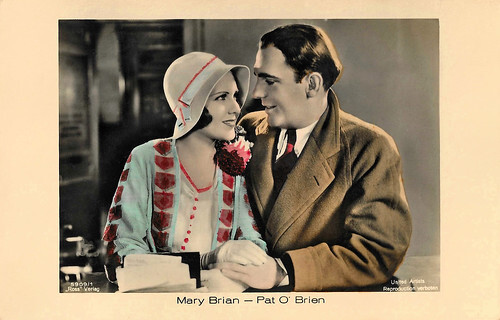
German postcard by Ross Verlag, no. 5909/1, 1930-1931. Photo: United Artists. Mary Brian and Pat 'O Brien in The Front Page (Lewis Milestone, 1931) Collection: Geoffrey Donaldson Institute.
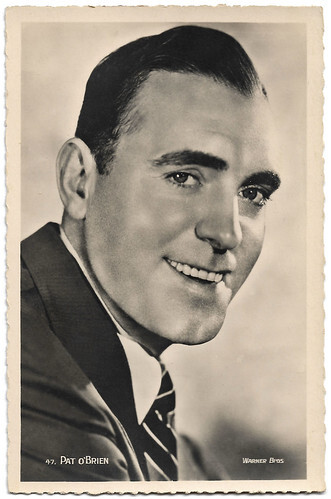
French postcard by Edition Chantal, Rueil-Malmaison, no. 47. Photo: Warner Bros.
The Front Page
William Joseph Patrick O'Brien was born in 1899 to an Irish-American Catholic family in Milwaukee, Wisconsin. All four of his grandparents had come from Ireland. As a child, O'Brien served as an altar boy at Gesu Church, while growing up near 13th and Kilbourn Streets in Milwaukee. He attended Marquette Academy with fellow actor Spencer Tracy , who was a lifelong friend. During World War I, O'Brien and Tracy joined the United States Navy. They both attended boot camp at the Great Lakes Naval Training Center, but they never went to sea. The war ended before their training had finished. Jack Benny was also at the Great Lakes Naval Training Center at the same time as O'Brien and Tracy.
After the war, O'Brien finished his secondary schooling at Marquette Academy and later attended Marquette University. While still at college, he decided to seek work as an actor. He and Spencer Tracy moved to New York, where they both attended the American Academy of Dramatic Arts. The two struggling young actors shared a small studio apartment and began their careers on stage. O'Brien spent a decade in plays on Broadway and in the New York City area. He made his film debut in the Vitaphone Varieties short film, The Nightingale (1930), produced in New York.
His first starring role was as ace reporter Hildy Johnson in the original version of the screwball comedy The Front Page (Lewis Milestone, 1931) with Adolphe Menjou . Based on the 1928 Broadway play of the same name by Ben Hecht and Charles MacArthur, the film was nominated for the Oscars for Best Picture, Lewis Milestone for Best Director, and Menjou for Best Actor. Pat O'Brien was the lead in Personal Maid (Monta Bell, Lothar Mendes, 1931), and appeared in the musical Flying High (Charles Reisner, 1931), supporting Bert Lahr. He was Irene Dunne 's love interest in Consolation Marriage (Paul Sloane, 1932), then co-starred opposite a young Bette Davis in Hell's House (Howard Higgin, 1932).
O'Brien stayed in leads, going from studio to studio: Scandal for Sale (Russell Mack, 1932), The Strange Case of Clara Deane (Louis J. Gasnier, Max Marcin, 1932), Hollywood Speaks (Edward Buzzell, 1932) and American Madness (Frank Capra, 1932). O'Brien played a heroic pilot in Air Mail (1932), directed by John Ford. At the small Majestic Pictures, he starred in The World Gone Mad (Christy Cabanne, 1933) with Evelyn Brent . In 1933, Warners signed O'Brien to a long-term contract. He would remain with the studio until 1940 when he left after a dispute over the terms of his contract renewal. O'Brien supported Dick Powell in College Coach (William A. Wellman, 1933) and Joan Blondell in I've Got Your Number (Ray Enright, 1934). Here Comes the Navy (Earl Baldwin, 1934) was O'Brien's first film with James Cagney , also under contract to Warners. The two originally met in 1926 and remained friends for almost six decades. After O'Brien's death, Cagney referred to him as his "dearest friend."
O'Brien played the lead, a boxer, in The Personality Kid (Alan Crosland, 1934), supported Dick Powell in Flirtation Walk (1934) and was an auctioneer in I Sell Anything (Robert Florey, 1935). Cagney and O'Brien were reteamed in Devil Dogs of the Air (Lloyd Bacon, 1935). He was a critic in love with Dolores del Río in In Caliente (Lloyd Bacon, 1935) and had the lead in the bio-pic Oil for the Lamps of China (Mervyn LeRoy, 1935), which he called "one of my favourite pictures". He headlined the musical Stars Over Broadway (William Keighley, 1935) and then was back with Cagney for Howard Hawks ' adventure drama Ceiling Zero (1935). Cagney later sued Warners for billing O'Brien's name above his. Warners gave him some starring parts: I Married a Doctor (Archie Mayo, 1936), Public Enemy's Wife (Nick Grinde, 1936), China Clipper (Ray Enright, 1936), The Great O'Malley (William Dieterle, 1937), and Slim (Ray Enright, 1937) with Henry Fonda . He was Captain of the Guard (on special leave from the US Army) in San Quentin (1937) opposite Humphrey Bogart , romanced Joan Blondell in Back in Circulation (Lloyd Bacon, 1937) and was a veteran sailor in Submarine D-1 (Lloyd Bacon, 1938). He and Cagney reteamed for the screwball comedy Boy Meets Girl (Lloyd Bacon, 1938) with Marie Wilson .
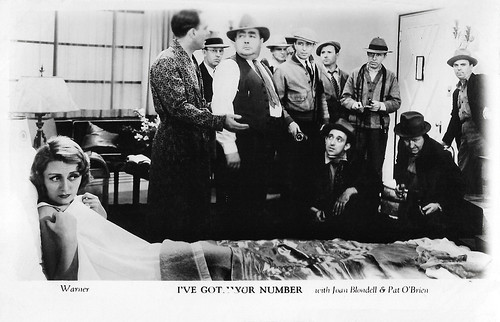
British postcard in the Filmshots series by Film Weekly. Photo: Warner. Joan Blondell and Pat O'Brien in I've Got Your Number (Ray Enright, 1934).
Crack-Up
In the late 1930s, Pat O'Brien and a small group of his actor friends began to meet to converse and exchange opinions and stories. Hollywood columnist Sidney Skolsky dubbed them the "Irish Mafia," but they preferred to call their social group the "Boys Club." In addition to O'Brien, the original members of the club were James Cagney , Spencer Tracy , Allen Jenkins and Frank McHugh, all of whom were Irish-Americans. Later Lynne Overman joined their group and then George Brent , James Dunn , Louis Calhern, Brian Donlevy, Ralph Bellamy, James Gleason and Bert Lahr were also frequent guests.
Pat O'Brien has one of his best-ever roles as the former street kid turned priest in the crime drama Angels with Dirty Faces (Michael Curtiz, 1938) with James Cagney . He went over to Paramount for the drama The Night of Nights (Lewis Milestone, 1939), part of a deal in which Warners bought the rights to The Old Maid from Paramount. He then made the mystery Slightly Honorable (Tay Garnett, 1939) for United Artists. Back at Warner Bros, he was reunited with Cagney for The Fighting 69th (William Keighley, 1940).
O'Brien then made the prison film Castle on the Hudson (Anatole Litvak, 1940) with Ann Sheridan and John Garfield . He co-starred with Garfield and Frances Farmer in Flowing Gold (Alfred E. Green, 1940). O'Brien was then given his best-known role, as the famous University of Notre Dame football coach Knute Rockne in Knute Rockne, All American (Lloyd Bacon, 1940). In the film, he gave the speech to "win just one for the Gipper," referring to recently deceased football player, George Gipp, portrayed in the film by a young Ronald Reagan . Reagan later used this saying as a slogan for his campaign for president in 1980.
O'Brien was at a career peak. He was considered for the role of Alvin York in the film Sergeant York. From this high point, however, O'Brien left Warner Bros in July 1940. O'Brien signed a contract with 20th Century Fox for two films a year. However, they ended up not using him. He signed with Columbia Pictures to make two films a year. He was in the war film Escape to Glory (John Brahm, 1940), then was idle for a year before making Two Yanks in Trinidad (Gregory Ratoff, 1942) with Brian Donlevy and the war drama Flight Lieutenant (Sidney Salkow, 1942) with Glenn Ford . At Universal, he was in the crime musical Broadway (William A. Seiter, 1942) with George Raft .
Soon he signed a contract with RKO and appeared in several films for that studio. He mostly played authority or military roles such as The Navy Comes Through (A. Edward Sutherland, 1942), and Bombardier (Richard Wallace, 1943). The Iron Major (Ray Enright, 1943) was an attempt to repeat the success of Knute Rockne with O'Brien as Frank Cavanaugh. At Universal he supported Deanna Durbin in Frank Borzage's His Butler's Sister (1943) then it was back to RKO for Marine Raiders (Harold D. Schuster, 1944). With his agent Phil Ryan, O'Brien set up his own production company, Teneen Productions. They signed a deal with Columbia to make a film with O'Brien, Secret Command (A. Edward Sutherland, 1944). For Columbia, he made the Film Noir Perilous Holiday (Edward H. Griffith, 1946). In 1946 he starred in the successful Film Noir Crack-Up (Irving Reis, 1946) with Claire Trevor . He was in a thriller, Riffraff (Ted Tetzlaff, 1947) and another biopic Fighting Father Dunne (Ted Tetzlaff, 1948). He followed it with the fantasy drama The Boy with Green Hair (Joseph Losey, 1948) featuring Dean Stockwell and the Film Noir A Dangerous Profession (Ted Tetzlaff, 1949) with George Raft and Ella Raines .
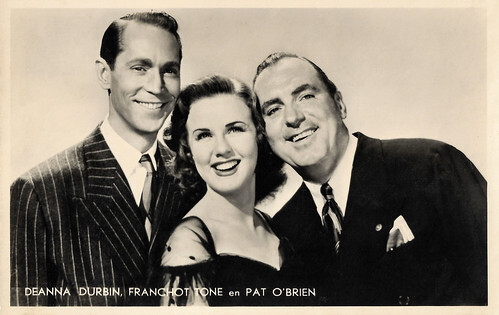
Dutch postcard by J.S.A. (J. Sleding, Amsterdam. Photo: F.B.O. - M.P.E. / Universal. Deanna Durbin , Franchot Tone and Pat 'O Brien in His Butler's Sister (Frank Borzage, 1943).
Some Like It Hot
While working as a Hollywood contract player, Pat O'Brien made occasional appearances on the radio in the 1930s and 1940s. In 1946 he collaborated with the contralto Kate Smith on the popular 'Viva America' program for the CBS radio network. In the summer of 1947, he starred with Lynn Bari in Summer Theater, a program "dramatizing episodes in the life of a small-town druggist." O'Brien's film career slowed considerably by the early 1950s, although he still managed to get work in television. In his autobiography, 'The Wind at My Back', he professed to be completely flummoxed about the decline of his career.
His close friend, Spencer Tracy, fought with his studio, MGM, to get roles for O'Brien in his films The People Against O'Hara (John Sturges, 1951) and The Last Hurrah (John Ford, 1958). He still had leads in films like the war film Okinawa (Leigh Jason, 1952), the Film Noir Inside Detroit (Fred F. Sears, 1956) with Dennis O'Keefe and the British crime film Kill Me Tomorrow (Terence Fisher, 1957) with Lois Maxwell.
In 1959 O'Brien appeared in a supporting role in one of his best-known films as a police detective opposite George Raft in the crime comedy Some Like It Hot (Billy Wilder, 1959), starring Marilyn Monroe , Jack Lemmon , and Tony Curtis . In his later years, O'Brien often worked in television. He was cast in 1956 and 1957 in four episodes of the religion anthology series, Crossroads. In three of the four programs, he played priests. He also performed in two episodes of The Virginian in the mid-1960s. In the 1960–1961 television season, O'Brien played James Harrigan, Sr. in a sitcom titled Harrigan and Son.
O'Brien made numerous appearances on television as himself, including several on The Ed Sullivan Show. In 1957, Ralph Edwards profiled O'Brien's life and career for an episode of This Is Your Life. He was also the mystery guest on the game show What's My Line? in 1953 and 1957. From the 1960s through the early 1980s, O'Brien often travelled around the United States as a one-man act and in road shows. He also performed frequently in nightclubs. He had a small role as Burt Reynolds' father in the comedy The End (Burt Reynolds, 1978), opposite Myrna Loy , cast as Reynolds' mother.
The drama Ragtime (Milos Forman, 1981) featured Pat O'Brien's final film appearance as well as his friend James Cagney 's. Cagney had not acted in a film for nearly 20 years. In 1982, O'Brien's final filmed performance came in an episode of Happy Days. Near the end of his life, he toured in a stage production of 'On Golden Pond', which he considered "absolutely the best play" he had ever read. O'Brien and his wife, Eloise, had four children: Mavourneen, Sean, Terry, and Brigid. Three of his children were adopted. The youngest, Brigid O'Brien (1946-2016), was his biological child. Eloise O'Brien occasionally appeared on stage with her husband. Pat O'Brien died in 1983, from a heart attack at age 83, following minor prostate surgery. President Ronald Reagan released a White House statement noting his sadness over his old friend's death. The president had called the actor at the hospital just days before his death.
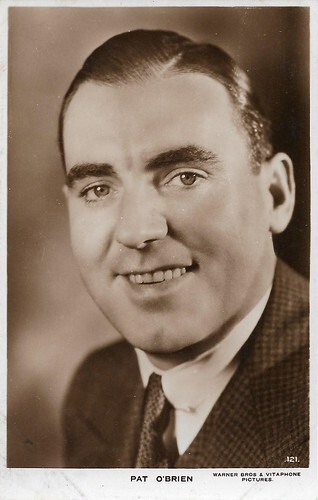
British postcard by Milton's, no. 121. Photo: Warner Bros. & Vitaphone Pictures.
Sources: (IMDb), Wikipedia and .

German postcard by Ross Verlag, no. 5909/1, 1930-1931. Photo: United Artists. Mary Brian and Pat 'O Brien in The Front Page (Lewis Milestone, 1931) Collection: Geoffrey Donaldson Institute.

French postcard by Edition Chantal, Rueil-Malmaison, no. 47. Photo: Warner Bros.
The Front Page
William Joseph Patrick O'Brien was born in 1899 to an Irish-American Catholic family in Milwaukee, Wisconsin. All four of his grandparents had come from Ireland. As a child, O'Brien served as an altar boy at Gesu Church, while growing up near 13th and Kilbourn Streets in Milwaukee. He attended Marquette Academy with fellow actor Spencer Tracy , who was a lifelong friend. During World War I, O'Brien and Tracy joined the United States Navy. They both attended boot camp at the Great Lakes Naval Training Center, but they never went to sea. The war ended before their training had finished. Jack Benny was also at the Great Lakes Naval Training Center at the same time as O'Brien and Tracy.
After the war, O'Brien finished his secondary schooling at Marquette Academy and later attended Marquette University. While still at college, he decided to seek work as an actor. He and Spencer Tracy moved to New York, where they both attended the American Academy of Dramatic Arts. The two struggling young actors shared a small studio apartment and began their careers on stage. O'Brien spent a decade in plays on Broadway and in the New York City area. He made his film debut in the Vitaphone Varieties short film, The Nightingale (1930), produced in New York.
His first starring role was as ace reporter Hildy Johnson in the original version of the screwball comedy The Front Page (Lewis Milestone, 1931) with Adolphe Menjou . Based on the 1928 Broadway play of the same name by Ben Hecht and Charles MacArthur, the film was nominated for the Oscars for Best Picture, Lewis Milestone for Best Director, and Menjou for Best Actor. Pat O'Brien was the lead in Personal Maid (Monta Bell, Lothar Mendes, 1931), and appeared in the musical Flying High (Charles Reisner, 1931), supporting Bert Lahr. He was Irene Dunne 's love interest in Consolation Marriage (Paul Sloane, 1932), then co-starred opposite a young Bette Davis in Hell's House (Howard Higgin, 1932).
O'Brien stayed in leads, going from studio to studio: Scandal for Sale (Russell Mack, 1932), The Strange Case of Clara Deane (Louis J. Gasnier, Max Marcin, 1932), Hollywood Speaks (Edward Buzzell, 1932) and American Madness (Frank Capra, 1932). O'Brien played a heroic pilot in Air Mail (1932), directed by John Ford. At the small Majestic Pictures, he starred in The World Gone Mad (Christy Cabanne, 1933) with Evelyn Brent . In 1933, Warners signed O'Brien to a long-term contract. He would remain with the studio until 1940 when he left after a dispute over the terms of his contract renewal. O'Brien supported Dick Powell in College Coach (William A. Wellman, 1933) and Joan Blondell in I've Got Your Number (Ray Enright, 1934). Here Comes the Navy (Earl Baldwin, 1934) was O'Brien's first film with James Cagney , also under contract to Warners. The two originally met in 1926 and remained friends for almost six decades. After O'Brien's death, Cagney referred to him as his "dearest friend."
O'Brien played the lead, a boxer, in The Personality Kid (Alan Crosland, 1934), supported Dick Powell in Flirtation Walk (1934) and was an auctioneer in I Sell Anything (Robert Florey, 1935). Cagney and O'Brien were reteamed in Devil Dogs of the Air (Lloyd Bacon, 1935). He was a critic in love with Dolores del Río in In Caliente (Lloyd Bacon, 1935) and had the lead in the bio-pic Oil for the Lamps of China (Mervyn LeRoy, 1935), which he called "one of my favourite pictures". He headlined the musical Stars Over Broadway (William Keighley, 1935) and then was back with Cagney for Howard Hawks ' adventure drama Ceiling Zero (1935). Cagney later sued Warners for billing O'Brien's name above his. Warners gave him some starring parts: I Married a Doctor (Archie Mayo, 1936), Public Enemy's Wife (Nick Grinde, 1936), China Clipper (Ray Enright, 1936), The Great O'Malley (William Dieterle, 1937), and Slim (Ray Enright, 1937) with Henry Fonda . He was Captain of the Guard (on special leave from the US Army) in San Quentin (1937) opposite Humphrey Bogart , romanced Joan Blondell in Back in Circulation (Lloyd Bacon, 1937) and was a veteran sailor in Submarine D-1 (Lloyd Bacon, 1938). He and Cagney reteamed for the screwball comedy Boy Meets Girl (Lloyd Bacon, 1938) with Marie Wilson .

British postcard in the Filmshots series by Film Weekly. Photo: Warner. Joan Blondell and Pat O'Brien in I've Got Your Number (Ray Enright, 1934).
Crack-Up
In the late 1930s, Pat O'Brien and a small group of his actor friends began to meet to converse and exchange opinions and stories. Hollywood columnist Sidney Skolsky dubbed them the "Irish Mafia," but they preferred to call their social group the "Boys Club." In addition to O'Brien, the original members of the club were James Cagney , Spencer Tracy , Allen Jenkins and Frank McHugh, all of whom were Irish-Americans. Later Lynne Overman joined their group and then George Brent , James Dunn , Louis Calhern, Brian Donlevy, Ralph Bellamy, James Gleason and Bert Lahr were also frequent guests.
Pat O'Brien has one of his best-ever roles as the former street kid turned priest in the crime drama Angels with Dirty Faces (Michael Curtiz, 1938) with James Cagney . He went over to Paramount for the drama The Night of Nights (Lewis Milestone, 1939), part of a deal in which Warners bought the rights to The Old Maid from Paramount. He then made the mystery Slightly Honorable (Tay Garnett, 1939) for United Artists. Back at Warner Bros, he was reunited with Cagney for The Fighting 69th (William Keighley, 1940).
O'Brien then made the prison film Castle on the Hudson (Anatole Litvak, 1940) with Ann Sheridan and John Garfield . He co-starred with Garfield and Frances Farmer in Flowing Gold (Alfred E. Green, 1940). O'Brien was then given his best-known role, as the famous University of Notre Dame football coach Knute Rockne in Knute Rockne, All American (Lloyd Bacon, 1940). In the film, he gave the speech to "win just one for the Gipper," referring to recently deceased football player, George Gipp, portrayed in the film by a young Ronald Reagan . Reagan later used this saying as a slogan for his campaign for president in 1980.
O'Brien was at a career peak. He was considered for the role of Alvin York in the film Sergeant York. From this high point, however, O'Brien left Warner Bros in July 1940. O'Brien signed a contract with 20th Century Fox for two films a year. However, they ended up not using him. He signed with Columbia Pictures to make two films a year. He was in the war film Escape to Glory (John Brahm, 1940), then was idle for a year before making Two Yanks in Trinidad (Gregory Ratoff, 1942) with Brian Donlevy and the war drama Flight Lieutenant (Sidney Salkow, 1942) with Glenn Ford . At Universal, he was in the crime musical Broadway (William A. Seiter, 1942) with George Raft .
Soon he signed a contract with RKO and appeared in several films for that studio. He mostly played authority or military roles such as The Navy Comes Through (A. Edward Sutherland, 1942), and Bombardier (Richard Wallace, 1943). The Iron Major (Ray Enright, 1943) was an attempt to repeat the success of Knute Rockne with O'Brien as Frank Cavanaugh. At Universal he supported Deanna Durbin in Frank Borzage's His Butler's Sister (1943) then it was back to RKO for Marine Raiders (Harold D. Schuster, 1944). With his agent Phil Ryan, O'Brien set up his own production company, Teneen Productions. They signed a deal with Columbia to make a film with O'Brien, Secret Command (A. Edward Sutherland, 1944). For Columbia, he made the Film Noir Perilous Holiday (Edward H. Griffith, 1946). In 1946 he starred in the successful Film Noir Crack-Up (Irving Reis, 1946) with Claire Trevor . He was in a thriller, Riffraff (Ted Tetzlaff, 1947) and another biopic Fighting Father Dunne (Ted Tetzlaff, 1948). He followed it with the fantasy drama The Boy with Green Hair (Joseph Losey, 1948) featuring Dean Stockwell and the Film Noir A Dangerous Profession (Ted Tetzlaff, 1949) with George Raft and Ella Raines .

Dutch postcard by J.S.A. (J. Sleding, Amsterdam. Photo: F.B.O. - M.P.E. / Universal. Deanna Durbin , Franchot Tone and Pat 'O Brien in His Butler's Sister (Frank Borzage, 1943).
Some Like It Hot
While working as a Hollywood contract player, Pat O'Brien made occasional appearances on the radio in the 1930s and 1940s. In 1946 he collaborated with the contralto Kate Smith on the popular 'Viva America' program for the CBS radio network. In the summer of 1947, he starred with Lynn Bari in Summer Theater, a program "dramatizing episodes in the life of a small-town druggist." O'Brien's film career slowed considerably by the early 1950s, although he still managed to get work in television. In his autobiography, 'The Wind at My Back', he professed to be completely flummoxed about the decline of his career.
His close friend, Spencer Tracy, fought with his studio, MGM, to get roles for O'Brien in his films The People Against O'Hara (John Sturges, 1951) and The Last Hurrah (John Ford, 1958). He still had leads in films like the war film Okinawa (Leigh Jason, 1952), the Film Noir Inside Detroit (Fred F. Sears, 1956) with Dennis O'Keefe and the British crime film Kill Me Tomorrow (Terence Fisher, 1957) with Lois Maxwell.
In 1959 O'Brien appeared in a supporting role in one of his best-known films as a police detective opposite George Raft in the crime comedy Some Like It Hot (Billy Wilder, 1959), starring Marilyn Monroe , Jack Lemmon , and Tony Curtis . In his later years, O'Brien often worked in television. He was cast in 1956 and 1957 in four episodes of the religion anthology series, Crossroads. In three of the four programs, he played priests. He also performed in two episodes of The Virginian in the mid-1960s. In the 1960–1961 television season, O'Brien played James Harrigan, Sr. in a sitcom titled Harrigan and Son.
O'Brien made numerous appearances on television as himself, including several on The Ed Sullivan Show. In 1957, Ralph Edwards profiled O'Brien's life and career for an episode of This Is Your Life. He was also the mystery guest on the game show What's My Line? in 1953 and 1957. From the 1960s through the early 1980s, O'Brien often travelled around the United States as a one-man act and in road shows. He also performed frequently in nightclubs. He had a small role as Burt Reynolds' father in the comedy The End (Burt Reynolds, 1978), opposite Myrna Loy , cast as Reynolds' mother.
The drama Ragtime (Milos Forman, 1981) featured Pat O'Brien's final film appearance as well as his friend James Cagney 's. Cagney had not acted in a film for nearly 20 years. In 1982, O'Brien's final filmed performance came in an episode of Happy Days. Near the end of his life, he toured in a stage production of 'On Golden Pond', which he considered "absolutely the best play" he had ever read. O'Brien and his wife, Eloise, had four children: Mavourneen, Sean, Terry, and Brigid. Three of his children were adopted. The youngest, Brigid O'Brien (1946-2016), was his biological child. Eloise O'Brien occasionally appeared on stage with her husband. Pat O'Brien died in 1983, from a heart attack at age 83, following minor prostate surgery. President Ronald Reagan released a White House statement noting his sadness over his old friend's death. The president had called the actor at the hospital just days before his death.

British postcard by Milton's, no. 121. Photo: Warner Bros. & Vitaphone Pictures.
Sources: (IMDb), Wikipedia and .
Published on July 13, 2025 22:00
July 12, 2025
The Milton Post Card
The 'Milton Post Cards' were published in Great Britain from around 1900. By 1902, Gustave Woolstone had registered the Milton trademark - the firm operated off Milton Street in the Postcard Mile of the City of London. Milton was the business name of Woolstone Brothers, a company registered by Gustave in 1925 at Aldersgate Street in London. The company made countless topographical and novelty postcards. Milton also published series with British stage actors, such as the Photolette series during the 1900s and the Milton Character Sketches series during the 1910s. In the early 1930s, a series of 'Real Photo Postcards' with portraits of Hollywood stars followed. The company stopped publishing postcards in 1933. We selected 25 Milton postcards from our collections for this post.
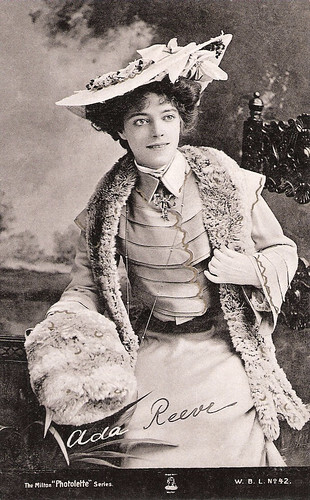
British postcard in the Milton Photolette Series, no. 42 by Woolstone Bros., London. Sent by mail in 1908. Ada Reeve .
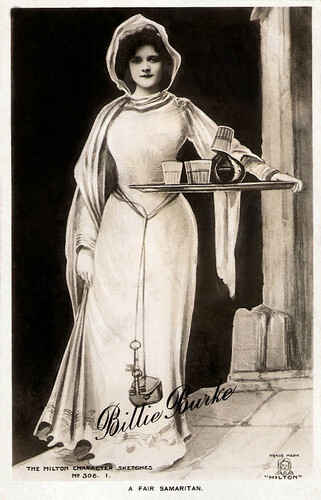
British postcard by Milton, Woolstone Bros, London E.C. in The Milton Character Sketches series, no. 306, 1. Caption: Billie Burke . A fair Samaritan.
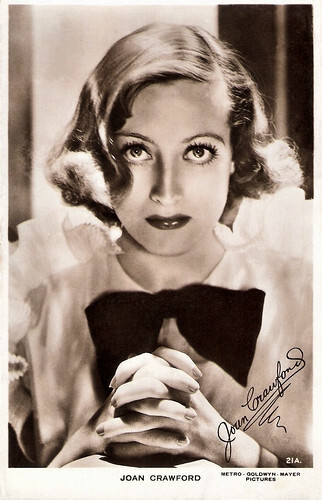
British postcard by Milton, no. 21A. Photo: Metro-Goldwyn-Mayer. Joan Crawford .
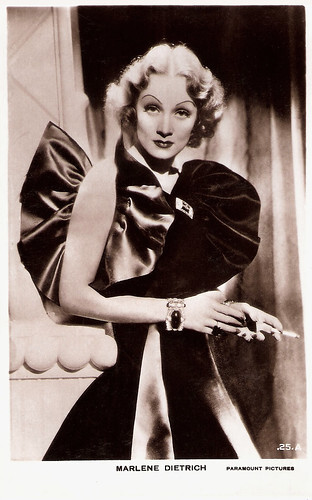
British postcard by Milton, no. 25 A. Photo: Paramount Pictures. Marlene Dietrich .
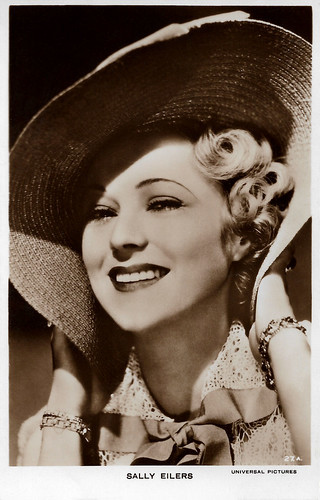
British postcard by Milton, no. 27. A. Photo: Universal Pictures. Sally Eilers .

British postcard by Milton, no. 29. A. Photo: First National Films. Kay Francis .
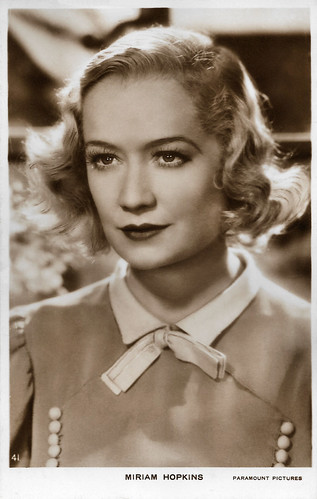
British postcard by Milton, no. 41. Photo: Paramount Pictures. Miriam Hopkins .
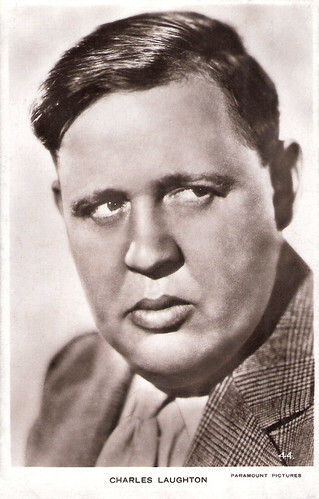
British postcard by Milton, no. 44. Photo: Paramount Pictures. Charles Laughton .
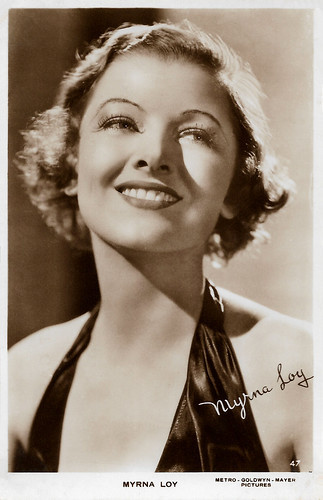
British postcard by Milton, no. 47. Photo: Metro-Goldwyn-Mayer Pictures. Myrna Loy .

British postcard by Milton, no. 53. Photo: Universal Pictures. Douglass Montgomery .
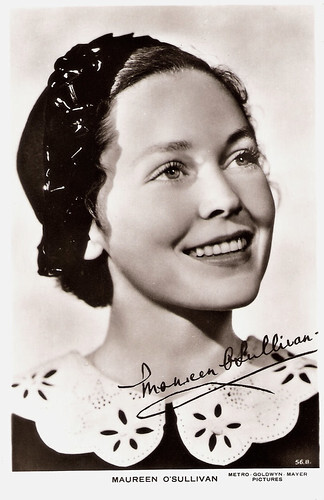
British postcard by Milton, no. 56.B. Photo: Metro-Goldwyn-Mayer. Maureen O'Sullivan .
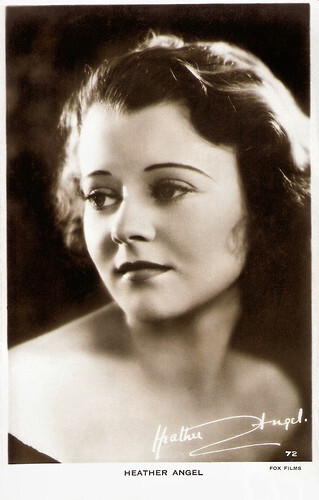
British postcard by Milton, no. 72. Photo: Fox Films. Heather Angel .
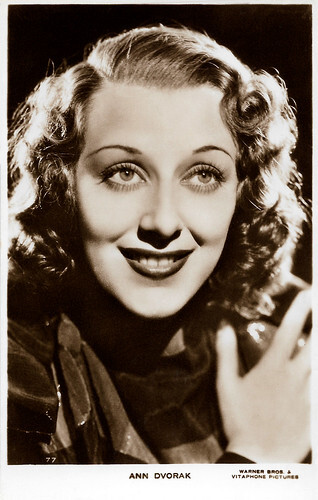
British postcard by Milton, no. 77. Photo: Warner Bros / Vitaphone. Ann Dvorak .
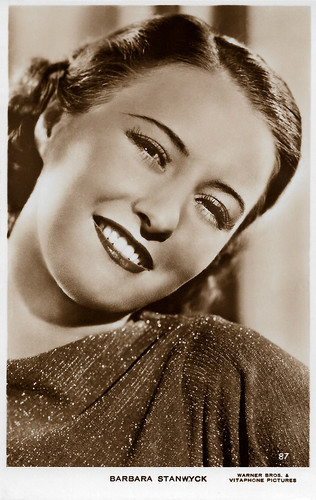
British postcard by Milton, no. 87. Photo: Warner Bros & Vitaphone Pictures. Barbara Stanwyck .
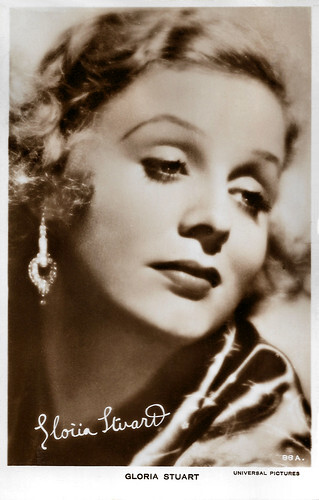
British postcard by Milton, no. 88a. Photo: Universal Pictures. Gloria Stuart .
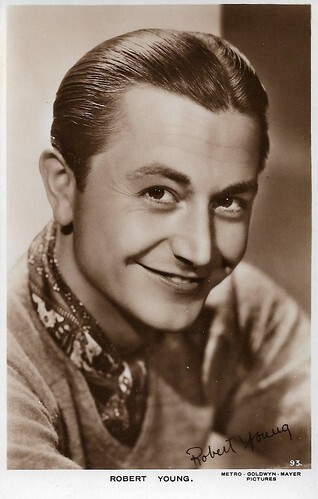
British postcard by Milton Postcard, no. 93. Photo: Metro-Goldwyn-Mayer. Robert Young .
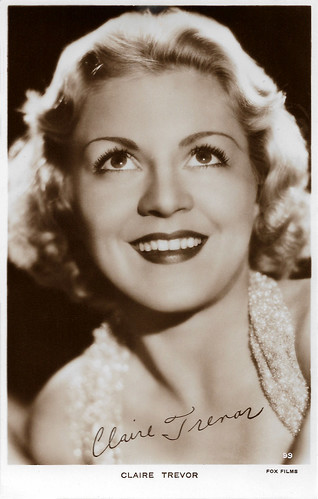
British postcard by Milton, no. 99. Photo: Fox Films. Claire Trevor .
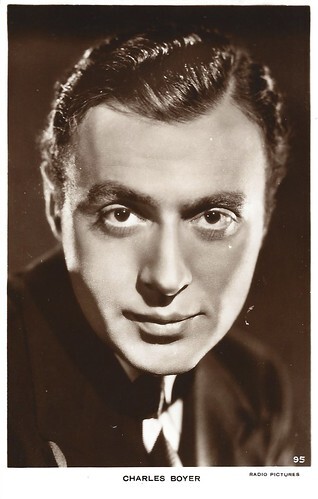
British postcard by Milton, no. 95. Photo: Radio Pictures (RKO). Charles Boyer .
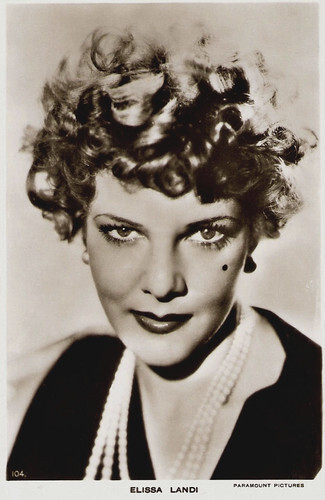
British postcard by Milton, no. 104. Photo: Paramount Pictures. Elissa Landi .
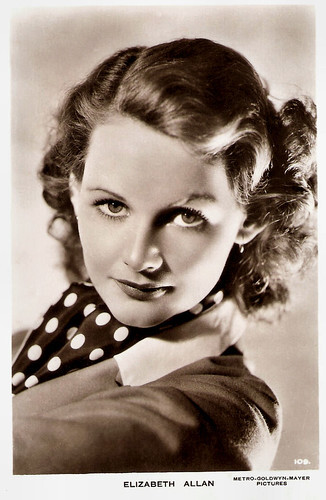
British postcard by Milton, no. 109. Photo: Metro-Goldwyn-Mayer. Elizabeth Allan .
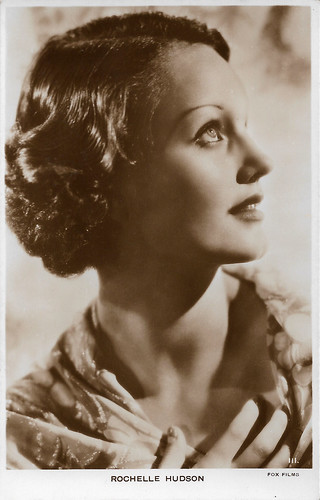
British postcard by Milton, no. 111. Photo: Fox Films. Rochelle Hudson .
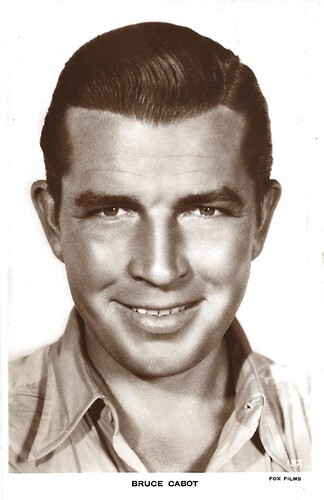
British postcard by Milton, no. 137. Photo: Fox Films. Bruce Cabot.
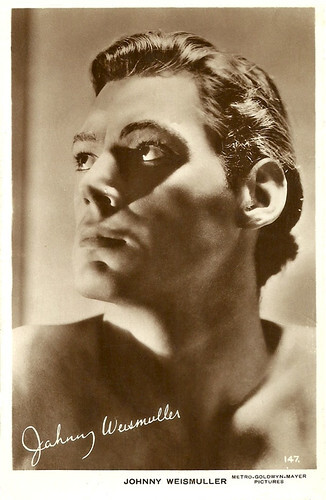
British postcard by Milton, no. 147. Photo: Metro-Goldwyn-Mayer Pictures. Johnny Weissmuller .
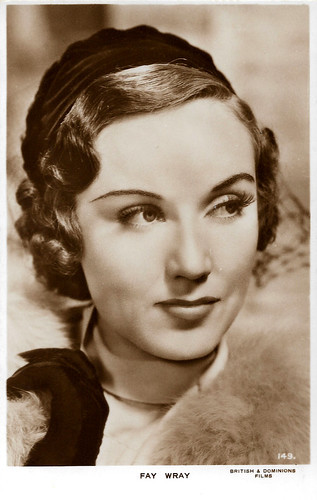
British postcard by Milton, no. 149. Photo: British & Dominions Films. Fay Wray .
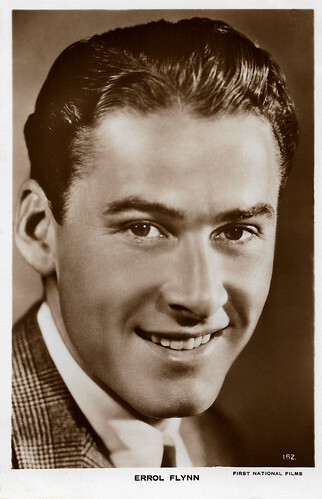
British postcard by Milton, no. 152. Photo: First National Films. Errol Flynn .
Sources: Feel Falkirk, rthcards and National Portrait Gallery.

British postcard in the Milton Photolette Series, no. 42 by Woolstone Bros., London. Sent by mail in 1908. Ada Reeve .

British postcard by Milton, Woolstone Bros, London E.C. in The Milton Character Sketches series, no. 306, 1. Caption: Billie Burke . A fair Samaritan.

British postcard by Milton, no. 21A. Photo: Metro-Goldwyn-Mayer. Joan Crawford .

British postcard by Milton, no. 25 A. Photo: Paramount Pictures. Marlene Dietrich .

British postcard by Milton, no. 27. A. Photo: Universal Pictures. Sally Eilers .

British postcard by Milton, no. 29. A. Photo: First National Films. Kay Francis .

British postcard by Milton, no. 41. Photo: Paramount Pictures. Miriam Hopkins .

British postcard by Milton, no. 44. Photo: Paramount Pictures. Charles Laughton .

British postcard by Milton, no. 47. Photo: Metro-Goldwyn-Mayer Pictures. Myrna Loy .

British postcard by Milton, no. 53. Photo: Universal Pictures. Douglass Montgomery .

British postcard by Milton, no. 56.B. Photo: Metro-Goldwyn-Mayer. Maureen O'Sullivan .

British postcard by Milton, no. 72. Photo: Fox Films. Heather Angel .

British postcard by Milton, no. 77. Photo: Warner Bros / Vitaphone. Ann Dvorak .

British postcard by Milton, no. 87. Photo: Warner Bros & Vitaphone Pictures. Barbara Stanwyck .

British postcard by Milton, no. 88a. Photo: Universal Pictures. Gloria Stuart .

British postcard by Milton Postcard, no. 93. Photo: Metro-Goldwyn-Mayer. Robert Young .

British postcard by Milton, no. 99. Photo: Fox Films. Claire Trevor .

British postcard by Milton, no. 95. Photo: Radio Pictures (RKO). Charles Boyer .

British postcard by Milton, no. 104. Photo: Paramount Pictures. Elissa Landi .

British postcard by Milton, no. 109. Photo: Metro-Goldwyn-Mayer. Elizabeth Allan .

British postcard by Milton, no. 111. Photo: Fox Films. Rochelle Hudson .

British postcard by Milton, no. 137. Photo: Fox Films. Bruce Cabot.

British postcard by Milton, no. 147. Photo: Metro-Goldwyn-Mayer Pictures. Johnny Weissmuller .

British postcard by Milton, no. 149. Photo: British & Dominions Films. Fay Wray .

British postcard by Milton, no. 152. Photo: First National Films. Errol Flynn .
Sources: Feel Falkirk, rthcards and National Portrait Gallery.
Published on July 12, 2025 22:00
Paul van Yperen's Blog
- Paul van Yperen's profile
- 13 followers
Paul van Yperen isn't a Goodreads Author
(yet),
but they
do have a blog,
so here are some recent posts imported from
their feed.



